The convict word was never mentioned in my husband Geoffrey Rundle’s family and as far as he knew, his family were thought to be First Fleeters, whose famous ancestor, Frederick Meredith, had arrived on the Scarborough, as steward to Captain John Marshall. Geoff’s father’s side of the family had no convicts, however, I discovered, to my great interest and vast amusement, that his mother Valmae Lenore Rundle nee Patterson (1926-2016) had convicts crawling out of nearly every family branch. Previous generations had most definitely decided to keep whatever they knew about their family’s convict past completely and very successfully confidential. If Valmae Lenore Patterson knew about any convicts in her family, she was in denial and certainly was never going to tell anyone! Well, that was until I came along as the family historian, aided by the invention of the internet, which opened up the past, providing search engines, that, at the click of a button would reveal the convicts and early settler documents of Australia’s past generations.

Australians today are fascinated about their past, and wear their convict family member as a badge of honour.
I am quite sure that the reason Australians wish to unlock their past is because so many people today don’t know where their families originated from. It is a fact that many convicts who arrived in the Colony as felons, murderers and petty criminals were the victims of poverty, neglect and circumstance. These ancestors were banished from both their homelands and families, never to return. Over time convict’s homelands were forgotten, as well as their crimes, as Australian citizens transformed themselves into one of the most law abiding societies in the world. Victorian England’s influence on Australia produced a stiff upper lip attitude and any relationship to a convict past was quickly swept under the carpet of respectability.

Pedigree chart for Valmae Lenore Patterson
When I told my mother-in-law Valmae Lenore Patterson several years ago that I was going to write up and publish the family history she asked me not to put anything in my history that would reflect badly on the family. I know she was worried about herself personally and I simply replied, that if she has lived her life truthfully, then she should have nothing to worry about. I am not sure there was much comfort in my words for her, as I explained to her that I was interested only in historical and legal documents, and that my history would reflect and reveal these facts if they were relevant records for our family history. Family stories handed down the generations are almost always notoriously inaccurate and unreliable and it is the documents that tell the truth about people. This was the very first lesson I was taught during my two year Certificate Course in Genealogy Studies 2012-2013 with the Society of Australian Genealogists, Sydney.
In this chapter I will deal with the arrival in Sydney of the Stewart, Smith and Blade families from England, in the early days of the Colony of New South Wales, detailing the ships they arrived in, and how and why they came to be here. As far as practicable I will also show their extended families and produce as many original documents, newspaper clippings, photographs and charts that I have been able to find during my many years of research. It has been an amazing experience to journey back in time and uncover the early social history of Sydney and see the extraordinary part my husband’s family played in shaping the history of the early Colony. One of my particular interests was to try and find the historic graves of these early Colonists in the many early and famous Sydney cemeteries from the 19th Century and in this particular quest I have uncovered some very impressive real estate!
Sydney Cove had grown massively in the 50 years since 1788, spreading away from the Cove, up George Street keeping close by to the Tank Stream. Governor Lachlan Macquarie’s legacy of a clearly marked out roadway system of square blocks is still today appreciated by anyone who visits our fine city. However, by 1820 the Old Burial Ground at the top of George Street was closed, due to overcrowding, terrible drainage, sanitation problems and often a lack of clean air.
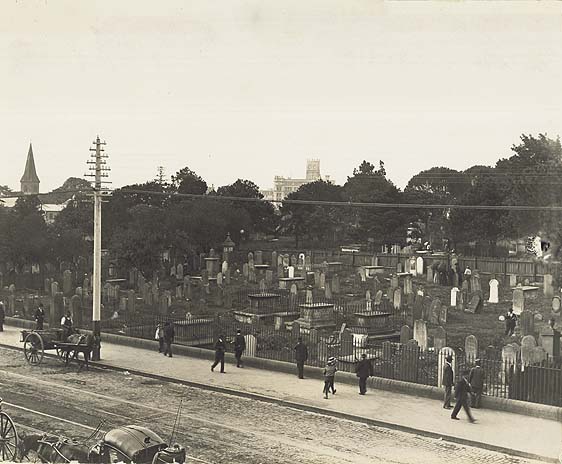
Devonshire Burial Grounds, now the site of Central Railway, abt. 1880
The expansion of Sydney meant that the ever spreading city limits were deemed to be too close to the Old Burial Ground for it to keep operating. The haphazard layout, lackadaisical record keeping and the fact that many early graves were simply marked with a cross, allowed the caretakers to cram more burials into the area than it could cope with, rather than build over it, the cemetery was simply closed and an ornate fence was built around the perimeter. It stayed this way until 1880 when the Sydney Town Hall was proposed for the site. A new cemetery was created near Brickfield Hill on Devonshire Street to take all of Sydney’s burials. Devonshire Cemetery today is where Sydney’s Central Railway was built in 1901.
It the area around George Street and the Market Street Wharves down at Cockle Bay, now Darling Harbour and the pub areas around Sussex and Erskine Streets was where the Stewart, Smith and Blade families settled in the early 1800’s. Later they moved to Millers Point, before quitting the city for the more fashionable areas of Camperdown, Surry Hills and Paddington. This was a time well before the eastern suburbs were subdivided and sold off from their very large estates, owned by the Cooper and Wentworth families and before ferries opened up the city to the north shore. More than a hundred years would pass before the Sydney Harbour Bridge was built in the 1930’s. It was only natural therefore, that the city moved west at a great pace.
My research into my husband’s family began shortly after I found, to my surprise, that I also had a convict ancestor, well, two to be accurate, Samuel Howell who arrived on the Scarborough, as part of the notorious Second Fleet in 1789 and his son in law Richard Kippax, a doubly convicted highwayman from Yorkshire who, in 1815 arrived in Sydney aboard the Indefatigable, lucky to escape the hangman’s noose.
In January 2011 I took out a subscription for a year on ancestry.com and it took me barely five hours of research late one hot and sticky January evening, before I uncovered my Kippax family line. I clearly remember the moment that the website instructed me to click “here” to obtain my ancestor’s convict records. To be perfectly honest, I was absolutely gobsmacked, because no-one in my family had ever mentioned our convict heritage before. I wondered if my dad, Reg Robson had actually known. When I told my sister Lavinia Chrystal the following day, her reply came back “does anyone really need to know this?” I simply laughed at her! Today we both wear our convict heritage as a badge of honour.
However, I simply couldn’t bring myself to tell my husband about my convicts because I knew he would tease me remorselessly! So I kept it a secret for a few more days while I beavered away on his side of the family to see if he, like me, had convicts in his family tree. It was a complex process because my husband had difficulty even naming his grandparents, as all bar Sylvia Patterson, his maternal grandmother, had died before he was born. Geoff had the middle name Farrell, and when I placed this name tentatively into my tree as a surname for his grandmother Sylvia, records appeared for me to collect.
In no time at all I had accepted many Farrell records, newspaper articles and photographs which had been posted and accepted by other family researchers on ancestry.com. In a few hours I had traced the Farrell family back several generations to Geoff’s 3x great grandmother Charlotte Farrell nee Meredith (1794-1851) who was the daughter of Frederick Meredith (1763-1836) and a young Yorkshire lass and convicted felon, Mary Kirk (1771-1809), who had arrived on the Royal Admiral on 7 October 1792. The Farrell and the Meredith Family, is another chapter, telling the story of this remarkable family and their early involvement in the Colony of New South Wales and in particular Port Macquarie and Sydney.
It was at this point that I came clean with my husband, Geoff, about what I was up to in the late hours of the evenings, explaining that we both had amazing ancestors, including convicts, who had arrived in the early Colony. Our families, arriving so early, it was no wonder that there were convicts in some of our lines! Together Geoff and I have marvelled about each and every discovery and our quest to locate the graves of our ancestors has resulted in our uncovering graves and headstones, not only here in Australia, but in New Zealand, England, Scotland and Ireland and has taken us on an incredible adventure of discovery, which has left us feeling more like amateur detectives, historians and archaeologists, than just the descendants of early Colonists.
After I had explored the Farrell and the Meredith family, I turned to uncovering the surname of Sylvia Farrell’s mother. Unfortunately Sylvia’s birth extract had not listed a surname for her mother, she was simply listed as Charlotte F. S., so I turned to other resources and it was from a very blurred newspaper clipping that I discovered Charlotte’s maiden surname was Stewart. Charlotte or Sarah, known as Cissie, had married Charles M. Farrell and her marriage in 1887 had luckily been reported in the newspaper. The marvellous part about these newspaper clippings is that there is just so much information given about the families, including their addresses.
Australia Birth Index, 1788-1922
| Name | Sylva R L Farrell |
| Birth Date | 1893 |
| Birth Place | New South Wales |
| Registration Year | 1893 |
| Registration Place | Redfern, New South Wales, Australia |
| Father | Charles M Farrell |
| Mother | Charlotte F S |
| Registration Number | 30698 |

Marriage of Charles Farrell and Sarah “Cissy” Stewart, Sydney Morning Herald, 10 May 1887

Pedigree chart for Sylvia Rita Lenore Farrell
Sylvia Farrell’s pedigree takes her family back in so many family branches to the early Regimental soldiers, founders, pioneers, migrants and convicts of the Colony of New South Wales. All branches bar the Stewarts, Musts and Farrells are associated with the convict past of our Nation. I am proud to have been able to research this early Australian family and exorcise any shame that my husband’s ancestors may have had about their convict past. I am pleased to be able to reveal how these early Australian’s turned their lives around and turned adversity to triumph to became outstanding citizens in their communities. It has been such a pleasure to have researched these families.
In no time at all I had found Cissy Stewart’s birth record and collected it confidently due to her three Christian names, Charlotte Fanny Sarah.
Australia Birth Index, 1788-1922
| Name | Charlotte F S Stewart |
| Birth Date | 1865 |
| Birth Place | New South Wales |
| Registration Year | 1865 |
| Registration Place | Kingston, New South Wales, Australia |
| Father | Thomas Stewart |
| Mother | Eliza |
| Registration Number | 4251 |
One of the most helpful online resources has been the addition of Church of England parish records to the ancestry.com website. The purchase of these records through Births Deaths and Marriage Registry would have been prohibitive, but collecting them on ancestry.com makes the annual subscription very good value. It was a great thrill when I collected and downloaded to my computer, the original marriage record for Charles Farrell and Cissie Stewart.

Marriage of Charles Mitchell Farrell and Charlotte Fanny Sarah Stewart, 17 April 1887, St Michaels Church, Surry Hills, Sydney
There was so much information on this record, including the maiden names of both Thomas Stewart’s wife as Eliza Brown and William Thomas Farrell’s wife, named as Frances Kidd. The bride and groom’s ages were listed as well as their marital state, and the occupations of the men were also given, as well as addresses. Not only that, but I was able to see an original document that was nearly 130 years old, making this record so precious.
Charles Mitchell Farrell (1859-1924) and Charlotte Fanny Sarah Farrell (1865-1942) had four children, Ruby Muriel Farrell (1887-1979), Gordon Charles Farrell (1889-1891), Doris Elaine Farrell (1890-1923) and Sylvia Rita Lenore Farrell (1893-1978).
More information about this family is found in another chapter, The Farrell Family and the Meredith Family of Port Macquarie and Sydney.
The Stewart, Smith and Blade families are complex and large and the interconnections between them has been wonderful to discover. For the benefit of other descendants and family researchers, I will, as much as possible, expand these families and include some of the siblings in each generation in an attempt to help as many descendants find their family trees.
THE STEWART FAMILY
Thomas Stewart Jnr. (1841-1903), the father of Cissie Farrell was born in Sydney on 23 May 1841, the son of Thomas Stewart Snr. (1819-1883), a cabinet maker and publican, and his wife Ann Smith (1821-1856).

Pedigree chart for Charlotte Fanny Sarah “Cissie” Stewart

Baptism of Thomas Stewart Jnr. , son of Thomas Stewart Snr. and Ann Smith, 20 June 1841, born 23 May 1841, document kindly provided by Potsy Quigley nee Bathurst, Geoff’s third cousin
Thomas Stewart Jnr. married Eliza Brown (1842-1898) at St Michael’s Church Surry Hills on 9 April 1863. Eliza was the daughter of a convict, William Brown (1805-1864) who arrived in Sydney aboard the Asia in 1822 and his wife, Mary Faughtley Wright (1815-1888), who was the daughter of a convict, George F. Wright who arrived in Australia aboard the Somersetshire in 1814. I have earlier touched on Thomas and Eliza Stewart in my chapter on William Brown – A Proud Australian. William Brown was a business friend of both Thomas Stewart Snr. and Jnr., and had a successful timber business which he ran down at the Market Street Wharf where he had come into contact with the Stewarts who were involved in the area as publicans and ship owners. I can just imagine William Brown’s great joy when his daughter Eliza married into this fine early Colonial family.

Marriage of Thomas Stewart and Eliza Brown, The Empire, 14 April 1863

Marriage of Thomas Stewart and Eliza Brown, Sydney Morning Herald, 21 April 1863

Marriage of Thomas Stewart and Eliza Brown, 9 April 1863, St Michael’s Church, Surry Hills
Thomas and Eliza Stewart were the great great grandparents of my husband Geoffrey Rundle and it has been such a fascinating experience to find out about this early Colonial family of New South Wales and their incredible contribution to the hospitality and the transportation industry that has shaped our nation.
Thomas Stewart Jnr. (1841-1903) and Eliza Brown (1842-1898) had eleven children Florence Elizabeth Maryanne Stewart (1863-1933), Charlotte Fanny Sarah Stewart (1865-1942), Harriette Louise Stewart (1866-1948), Ann Jane Stewart (1868-1916), Thomas William George Stewart (1869-1903), Emma Lilian Stewart (1871-1934), Constance Eliza Maud Stewart (1873-1923), John Robert Stewart (1874-1942), Harold Andrew Stewart (1876-1945), Mildred Alice Stewart (1878-1957) and Leslie Smith Stewart (1879-1940).
Thomas Stewart proudly placed birth announcements for his children into the newspapers giving wonderful information, not only about the birth dates of his children, but their address and it can be seen in the early years of their marriage that they moved from Elizabeth Cottage, Paddington to Petersham and then to Wimbledon Hall, Surry Hills for their third daughter’s birth. Wimbledon Hall being the home of Eliza’s parents, William and Mary Brown.

Birth of Florence Elizabeth Maryann Stewart, Sydney Morning Herald, 14 November 1863

Birth of Charlotte Fanny Sarah Stewart, Sydney Morning Herald 22 February 1865

Birth of Harriet Louisa Stewart, Sydney Morning Herald, 2 August 1866

Waters v. Stewart, Sydney Morning Herald, 10 December 1885

Stable Fire in Redfern, South Australian Register, 2 February 1893
It was interesting that this fire was picked up by other states, I soon found a more in-depth account of the fire which did so much damage to the stables of Thomas Stewart Jnr.

‘Bus Stables Burnt, Daily Telegraph, 2 February 1893
During my early research on Thomas Stewart Jnr. I had often wondered what his occupation was, and I became confident after capturing these newspaper clipping regarding Thomas Stewart that he was an omnibus proprietor. An omnibus is a registered horse drawn carriage for public patrons and like any business, it was subject to advances in transportation innovation. Obviously Thomas Stewart had found a niche business in a time frame that proceeded the motor car industry, which would put an end to the horse and carriage business right around the world.

Transit Commission, Sydney Morning Herald, 2 February 1893

A ‘Bus for Riley-Street, Australian Star 13 July 1899

Death notice for Eliza Stewart, Daily Telegraph, 14 April 1898
During my searches in old newspapers I came across the death notice for Eliza Stewart on 12 April 1898 at her residence, 16 Dowling Street, Redfern, aged 60 years. Again, it was wonderful to be so confident collecting this notice and I was grateful for the added information confirming Eliza as the daughter of William Brown of Wimbledon Hall and giving the address of Bourke Street.

Friday’s Mails, Evening News 17 September 1903

Obituary for Mr. Thos. Stewart, Australian Star, 21 September 1903

Death notice for Thomas Stewart, bus proprietor, Sydney Morning Herald, 21 September 1903

Obituary for Thomas Stewart, Australian Town and Country Journal, 23 September 1903
The obituaries I found for Thomas Stewart were full of the most wonderful information bringing Thomas Stewart literally back to life for me and explaining and filling so many of the gaps that I had in my family history. The journalists not only explained his various interests in the horse racing industry but also described his personality as that of a quiet and reserved man.

Funeral of Thomas Stewart, Sydney Morning Herald, 22 September 1903
This funeral notice for Thomas Stewart was exciting to find because it revealed that Thomas was buried at the family vault at Waverley Cemetery in the Eastern Suburbs of Sydney. A quick Google of Waverley Cemetery showed that there was a document lodged in the State Library of New South Wales which gave descriptions of grave locations and a list of those interred in the graves. Making things even easier, I discovered that there is an office at Waverley Cemetery with a full time staff who are very helpful in giving directions to the gravestones.

Stewart Vault Grave, Waverley Cemetery, Saturday 7 July 2012, photo by Virginia Rundle
What an exciting day Saturday 7 July 2012 was, not only was it my husband Geoff’s birthday, but armed with grave directions for the Anglican section of the cemetery, we set off on an adventure with our cemetery scout Roy, our West Highland White Terrier, to find the Stewart grave at Waverley Cemetery. It didn’t take us long to locate this magnificent brown granite pedestal grave atop a lovely mosaic of black and white marble tiles, in the dress circle position overlooking the Pacific Ocean. It was quite magnificent, even on a wild and windy winter’s day. A vault beneath the grave allowed for the dead to be interred. However, the grave was in the most desperate condition, and a tree had formerly been growing on the eastern side, which had done considerable damage to the retaining wall. Thankfully the staff at the cemetery had cut it out, however it was still alive and we remedied that situation a few weeks later after we applied Roundup liberally to the grave.

Family vault of Thomas Stewart, Waverley Cemetery, photograph taken by Virginia Rundle
It was wonderful to see other Stewart family members buried in the grave along with Thomas and Eliza Stewart. The Morris family had inscriptions on another side of the grave. Cyril H. Morris (1888-1947), who had died in an accident, the husband of Vera Adams, grandson of Thomas and Eliza Stewart and his parents Sydney J Morris (1867-1946) who was the husband of Harriet Louisa Stewart (1866-1948), a sister to Cissie and a daughter to Thomas and Eliza, who is also listed below her husband, parents of Sydney “Sid” Morris, Cyril H Morris, Emily E Morris (1891-1965) and Ida Neita Morris (1893-1981). Also listed below is Sydney Stewart Morris (1886-1962) the eldest son of Sydney and Harriet Morris who has his ashes interred in the vault. On another side of the grave Leslie S Stewart (1879-1940 and his wife Florence Bracken (1882-1962) are listed, the parents of Glen and Dulce Stewart. It was so helpful to be able to take photos of the headstone and then return to my research documents and work out the relationships of these other people who are buried in the Stewart Grave. I must add that the brown granite is very difficult to photograph, in particular on a sunny day, when the reflections of the sun off the water and surrounding areas is too dazzling to get a clear photo.
Gravestone of Thomas and Eliza Stewart, Waverley Cemetery, photos taken by V. Rundle

Headstone of Cyril H Stewart, grandson of Thomas and Eliza Stewart, husband of Vera, photograph taken by Virginia Rundle

Headstone of the Morris family grave, part of the Stewart family grave at Waverley Cemetery, photo taken by Virginia Rundle
Headstone of Leslie S Stewart and his wife Florence, Stewart Family Grave, Waverley Cemetery. Photo taken by Virginia Rundle

Restoration begins on the Stewart grave at Waverley, photos V Rundle

Over a series of four weekends Geoff and I visited Waverley Cemetery and undertook restoration of the marble tiles, which involved removing the tiles in sections and taking out a thick matting of asparagus fern which had not been touched in nearly fifty years. We took out large green recycle bins and filled them many times over with this material. Then we carefully replaced the tiles and moved on to other sections of the marble. Finally, I applied a heavy duty potion of Roundup to kill of any further regrowth in the future. We still visit the grave several a times a year to weed and to admire this wonderful and peaceful place. On many occasions we have been blessed with the sight of whales rearing out of the water and I must say it is a most amazing vantage point for whale watching.
Stewart Grave, Waverley Cemetery, Easter 2018, photo taken by V Rundle
The work continues to weed and preserve the Stewart grave at Waverley Cemetery, however as the years go by, less and less weeds pop their heads up over the Spring and Summer months and as long as we can, we will be vigilant caretakers of this lovely grave.

Death of Cyril H. Morris, Coroner’s Report, Sydney Morning Herald, 8 Jul 1947
Cyril H. Morris was the grandson of Thomas and Eliza Stewart, his mother Harriet Stewart married Sydney J. Morris. Harriet was a sister to Cissie Stewart, my husband Geoff Rundle’s great grandmother.
How sad to find this newspaper report of the Coroner for Cyril Humphrey Morris, but how valiant he was in the face of a disaster that he gave his life so another could live. I am so grateful to Trove Digitised Newspapers, a free online resource funded by the Australian National Library, for without this information, it would take many library visits to plough through the microfiche tapes to find the newspaper clippings required. Trove allows for parameters to be selected and at the press of a button copies of these original newspaper become available to download. I am indebted to this resource, without it my family history would be incomplete and many unanswered questions would have remained.
In researching Cyril H. Morris I also discovered that Vera was actually his second wife. I found his marriage certificate from the Anglican Parish Registers, 1814-2011 for his first marriage to Kate Massingham on 19 June 1906.
Cyril and Kate Morris had three children, Stewart Massingham Morris (1906-1987), Cyril Ernest Morris (1908-1966) and Hugh Morris (1909-).

Marriage of Cyril Humphrey Morris and Kate Massingham, 19 June 1906, St Thomas’ Church, North Sydney, Sydney Anglican Parish Records, 1814-2011

Marriage of Ernest Alfred Porter and Mildred Alice Stewart, 15 April 1902, St Michael’s Church, Flinders Street, Sydney 1814-2011, Sydney Anglican Parish Register

The Motor Omnibus, Australian Star, 21 February 1905

Partnership Dissolved, Sydney Morning Herald, 10 February, 1909

Sydney’s last line of ‘buses, Mercury, 9 March 1912
During my research on the Stewart family I received some wonderful correspondence from another Stewart family descendant, Potsy Quigley, who is also a great great granddaughter of Thomas Stewart and Eliza Brown. Potsy’s ancestor is Ann Jane Stewart, a sister to Charlotte Fanny Sarah Stewart, who married Frances Bede Bathis/Bathurst. It has been an absolute pleasure to have collaborated with Potsy who has done an incredible amount of independent and extensive research on not only the Stewart family and the Brown family, but the Smith, Kent and Blade families of Sydney and London. I am indebted to Potsy for her generosity in sending me so many wonderful and precious documents that she has obtained from the Births, Deaths and Marriage Register of New South Wales. Potsy comes down a direct line from Francis and Ann Janes’s youngest son Thomas L. J. Bathis/Bathurst (1891-1952) who married Catherine A Field (1891-1925) at Marrickville, New South Wales in 1910. Their son Keith Allan Bathurst is Potsy Quigley nee Bathurst’s father.

Marriage of Francis Joseph Bede Bathurst and Ann Jane Stewart, 9 April 1888, St Peter’s Catholic Church, Surry Hills, document kindly provided by Potsy Quigley nee Bathurst.
Grave of Francis Bathis 1914 and Anne Jane Bathis nee Stewart 1916, Waverley Cemetery
It was a wonderful weekend in late May 2018 when we met up with Potsy Quigley in Sydney and had an amazing time visiting Rookwood, Waverley and Camperdown Cemeteries, where we were able to show her the graves of her ancestors. At Waverley we showed her the Stewart Grave and as a bit of an after-thought Potsy mentioned that her grandparents were buried somewhere in the cemetery. A quick visit to the office found a delightful worker explaining that on Saturdays the office is now shut. He must have sensed our disappointment as he kindly opened the office and helped us find the grave location, which was only a short walk from the office. He explained that Waverley Cemetery have how developed a free App. with a hot dot method to guide you to your relative’s grave, which sounds a great step forward. Potsy was so happy to find her grandparents grave that day and we hugged each other with excitement at her discovery.

Birth Registration of Ann Jane Stewart, daughter of Thomas Stewart and Eliza Brown 15 June 1868, born at Westbourne Street, Petersham, courtesy of Potsy Quigley

Thomas “Tom” Bathurst, circa 1916, kindly shared to ancestry.com by Noelene_W and her Bathis/Williams family tree
Thomas Stewart Jnr.’s (1841-1903) parents, Thomas Stewart Snr. (1819-1883) and his wife Ann Smith (1821-1856) were both born in the Colony of New South Wales, a testament to the early arrival of the Stewarts and the Smith to the Colony of New South Wales.
Thomas Stewart Snr’s occupation was a cabinet maker and later a publican whose family owned The Royal Oak Hotel, on the corner of Sussex and Erskine Street nearby to the Sydney Markets, which serviced Darling Harbour, formerly known as Cockle Bay. Later records revealed he was a ship owner and shipping agent.
The site of the Sydney Markets is now where the Queen Victoria Building stands, adjacent to the Sydney Town Hall, which is the former site of the old Sydney Burial Ground. It is incredible to think that this part of early Sydney was where the Stewart, Brown, Smith and Blade families lived, worked and socialised.

Baptism of Thomas Stewart, son of Robert and Mary Stewart, 7 March 1819, born 17 February 1819, document courtesy of Potsy Quigley nee Bathurst
Thomas Stewart Snr. (1819-1883) was the son of Robert Stewart (1778-1834), a Napoleonic soldier of the 46th Foot Regiment, who was posted to Australia, aboard the Wyndham in 1814, together with his wife Mary Bowman (1777-1848), and their young children John Stewart (1801-1877) and Elizabeth Stewart (1804-1875). Shortly after their arrival in Port Dalrymple, Tasmania, twins Henry Stewart (1814-1866) and William Stewart (1814-1869) were born. Thomas Stewart Snr. was born in Sydney in 1819, after the family made Sydney their permanent home.
Ann Smith (1821-1856) was the daughter of a convict shoemaker, George Smith (1783-1855), who was transported aboard the Baring in 1815. George Smith’s wife Mary Ann Kent (1782-1837) arrived the same year aboard the Broxbournebury, following her then husband, the convict Thomas Blades (1774-1815), an artist, who was transported on the Surrey in 1815, a companion ship to the Broxbournebury on the voyage to Sydney. Thomas Blades was tragically drowned in Cockle Bay in 22 January 1815 when a pleasure craft sank in a sudden squall. George Smith was assigned to Mary Ann Blades after their marriage on 27 May 1818. Their daughter, Ann Smith, was born in a wooden home along the eastern shore of Cockle Bay, which is now known as Darling Harbour.
Thomas and Ann Stewart had seven children, Thomas Smith Jnr. (1841-1903), Sarah Ann Stewart (1843-1869), George Robert Stewart (1845-1871), Mary J Stewart (1848-1848), Elizabeth Stewart (1850-1895), Martha Susannah Stewart (1852-1939) and Clara A Stewart (1854-1928).

Sydney Cove, looking down on Campbell’s Wharf, circa 1818, engraving by Captain Wallis of the 46th Regiment

1828 New South Wales Census which lists Thomas Stewart Snr., his parents Robert and Mary Stewart. Robert Stewart is listed as arriving aboard the Wyndham, a tailor of Erskine Street, Sydney and Thomas is listed as aged 9 B.C. (born colony). Listed below is Thomas Stewart’s brother John, wife Lydia and children, Mary Ann and John. John Stewart is listed as a shoemaker who arrived on the Matilda in 1813, another ship which sailed with the Wyndham.
There is just so much wonderful information on this census, and the incredible thing about this document is that it has survived until today and I was able to capture it on my home computer courtesy of ancestry.com who have made available an incredible amount of original Colonial and Convict documents in their original state.

Marriage of Thomas Stewart and Ann Smith, Sydney Monitor, 29 August 1840

Transfer of Publican Licence–refused, Commercial Journal and Advertiser, 14 September 1839, William Howard was married to Elizabeth Stewart, Thomas Stewart’s sister.

Marriage of Thomas Stewart and Ann Smith, 26 August 1840, image courtesy of Potsy Quigley
Witnesses to the marriage were Thomas’ brother William Stewart and Sarah Ireland nee Blades, who was a niece of Ann Smith, and the daughter of Sarah Ann Blades, a half sister of Ann Smith.

New South Wales Publican’s Licence, 30 April 1841, in favour of Thomas Stewart of the Royal Oak, Sydney,

Publican’s Licence, Sydney Gazette, 16 April 1842

Thomas Stewart, shipping agent, Sydney Morning Herald, 2 December 1851

Death Certificate of Ann Stewart nee Smith, 28 October 1836, image courtesy of Potsy Quigley
Ann had died at the relatively young aged of 35 years and I had often wondered whether she had died in childbirth, this document from Potsy confirmed this sad fact.

Death of Ann Stewart, Empire, 29 October 1856

Funeral of Ann Stewart, Sydney Morning Herald, 30 October 1856

New South Wales Government Gazette, 15 May 1857

Sands Directory, 1857 for Thomas Stewart, listed as a distillery inspector, Forest Lodge, Glebe. Also listed are his brothers, James and John Stewart, grocers from Elizabeth Street, Paddington and William Stewart, publican of the Royal Oak, Cnr Sussex and Erskine Streets.

Sale of Stewart property, Sydney Morning Herald, 11 May 1859

Marriage of Thomas Stewart and Elizabeth Coulton 13 June 1859, Sydney Morning Herald, 21 June 1859
Marriage of Thomas Smith and Elizabeth Coulton, St Michael’s Church Surry Hills, undated, Anglican Parish Records 1818-2011
I found this St Michael’s Surry Hills, Sydney, marriage register document for Thomas Stewart and Elizabeth Coulton on the ancestry.com website and it was unusual indeed to find an undated marriage document. Two of the marriages on the page were undated, however the third is listed as 1st September 1859 which enables me to confirm it as Thomas Stewart’s correct second marriage document. The marriage gives a wealth of information about the couple. The Stewart’s address as Botany Street, Surry Hills. Thomas’ siblings William Stewart and Elizabeth Howard are both witnesses to the marriage as well as the full names of Thomas and Elizabeth’s parents, Robert Stewart is listed as a tailor and Elizabeth Coulton father is listed as Thomas Mason, farmer. Precious information about the surnames of their mothers are also revealed. Thomas’ mother is listed as Mary Bowman and Elizabeth’s mother is listed as Anne Ords.
It was not surprising that Thomas Stewart married again, just three years after becoming a widower, marrying a widow, Elizabeth Coulton, the self-described relict of Mr George Coulton.
Headstone of George Coulton, died 27 January 1856, buried at Camperdown Cemetery, New South Wales, left hand side of one of three matching graves, the other two being for John and Lydia Stewart, Thomas Stewart’s Snr’s elder brother, and John and Lydia Stewart’s daughter Mary Borton and her family, photo taken by Virginia Rundle 23 June 2018.
The headstone of George Coulton is adjacent to the William Brown family vault at Camperdown Cemetery and during my visit in June 2018 I was intrigued by the discovery of his grave and that of the John and Lydia Stewart. Unsurprisingly, I am sure they were all family friends, and it comes as no surprise at all that William Brown’s daughter Eliza married Thomas Stewart Jnr on 9 April 1863 at the nearby St Michael’s Church in Surry Hills.
George Coulton was a publican who owned The Golden Fleece in George Street, and his burial record from Camperdown Cemetery stated he was an innkeeper. His wife Elizabeth inherited his estate after probate was granted. It is not surprising that Elizabeth Coulton married Thomas Stewart, as they we both involved in the running of pubs in Sydney during the 1850’s.
Funeral Notice for George Coulton of the Golden Fleece Inn 29 January 1856, Sydney Morning Herald
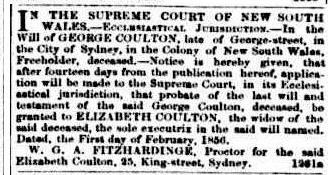 Probated will of George Coulton, 1 February 1856, Empire
Probated will of George Coulton, 1 February 1856, Empire
NSW Publican’s Licence grant for Mr George Coulton, 1855 for The Golden Fleece, George Street, Sydney

Death of Sarah Ann Stewart, Empire, 27 October 1869
There is so much information in this death record for Sarah Ann Stewart, aged just 27 years, listing her place of death at the residence of her uncle Mr C Morris of Campbelltown, and that her father Mr Thomas Stewart was now proprietor of Charlton’s Hotel, foot of Market Street.

Funeral of Sarah Ann Stewart, Sydney Morning Herald, 29 October 1869
Sarah Ann Stewart was buried at Balmain Cemetery and this was the first time I had seen a reference to a burial ground for Thomas Stewart Snr.’s family. Like many cemeteries Balmain Cemetery was full to overcrowding by the 1930’s and its position on a slight hillside meant that in hot or very wet weather there was a shocking odour and run-off emanating most unpleasantly from the cemetery, which was then deemed to be unsanitary to public health. Balmain Cemetery was completely bulldozed during World War II, to create what is now known as Balmain Pioneers Park, even after there were concerted efforts from concerned residents as to the total disregard to the historic nature of the cemetery. Balmain Council gave surviving relatives the opportunity to have their ancestors re-interred, however the shocking truth was that it was a very inopportune time for many descendants to take advantage of this offer. Sadly the bulldozing included the crushing of all headstones in a very callous disregard to our Colonial history. At the very least one would have expected that the historic headstones would have been preserved and included in a surrounding wall of respectfulness, as has happened at other cemeteries that were turned into parks.

Funeral of George Robert Stewart, son of Thomas Stewart Snr, Sydney Morning Herald, 27 September 1871

Death notice for Thomas Stewart Snr. Sydney Mail, 17 May 1883

Funeral of Mr Thomas Stewart Snr. Sydney Morning Herald, 8 March 1883
Thomas Stewart Snr. was buried at Balmain Cemetery with many members of his family, I still have to confirm whether the remains were resumed in 1940 and re-interred at Waverley Cemetery after Balmain Cemetery was bull-dozed.

Death Certificate of Thomas Stewart Snr. 7 March 1883, courtesy of Potsy Quigley
Private Robert Stewart 46th South Devonshire Foot Regiment
“The 46th Regiment arrived in the British colony of New South Wales to replace the 73rd Regiment of Foot (1st Battalion Highlanders) in February 1814, and were relieved by the 48th (Northamptonshire) Regiment of Foot in 1817. Whilst in New South Wales, the Regiment saw service in Sydney, Newcastle, Parramatta and Van Diemens Land before leaving for Madras in 1817. During their service in New South Wales, the 46th were commanded by Lieut. Colonel G. Molle. In 1820 apparently a detachment travelled on HMS Coromandel as escorts for convicts bound for Van Diemen’s Land and New South Wales.
Robert Stewart 46 regiment of foot . Private Robert Stewart (c.1778…..1834) Back To . .46th South Devonshire Regiment .48th Foot .The Northamptonshire Regiment 3rd Foot The Buff’s The East Kent Regiment. •Born : 31 May, 1778 •Where Born : Startforth, Co. Durham •Occupation : Tailor / Soldier •Date Arrived : 11 February, 1814 •Ship Arrived on : Wyndham •Rank on Discharge : Private •Date of Enlistment : 19 January, 1801 Enlisted 46th Regiment •Where Enlisted : Leeds •Transferred to 48th : 25 August, 1817 •Transferred to 3rd :25 March, 1818 •Date of Discharge :22 December, 1824 after length of service •Where Discharged : Sydney •Died : 10 May, 1834 •Where Died / Buried : Sydney / Sydney Burial Ground •Parents Names : Robert & Martha Stewart (maiden name Westerman ) •Spouse’s Name : Mary Bowman •Born : 1777 •Where Born : Yorkshire, England •Occupation : Soldier’s Wife •Date Arrived : 11 February, 1814 •Ship Arrived on : Wyndham •Died : 8 February, 1848 •Where Died / Buried : Sydney / Sydney Burial Ground •Date Married : 5 April 1801 •Where Married : St Peter’s, Leeds, Yorkshire, England •Spouse’s Parents : unknown.”
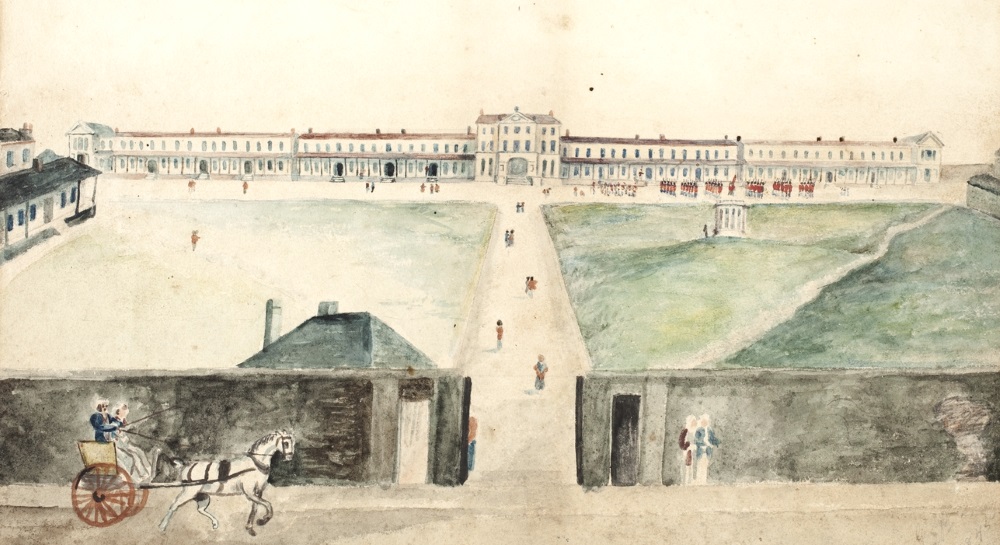
Victoria Barracks, Darlinghurst, Sydney, watercolour circa 1840
Much has been written about Private Robert Stewart of the 46th South Devonshire Foot Regiment and I must say it was fascinating to discover this amazing piece of regimental history in my husband, Geoff Rundle’s family. Many family researchers have placed documents onto websites such as ancestry.com and there is a wonderful spirit of collaboration and great pride amongst this group of descendants of Robert Stewart and his wife Mary Bowman. I was determined now to try and take Robert back to England and place him into his town of origin.
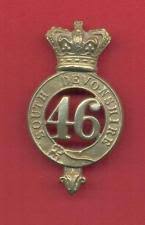
Brass Hatpin for the 46th Regiment
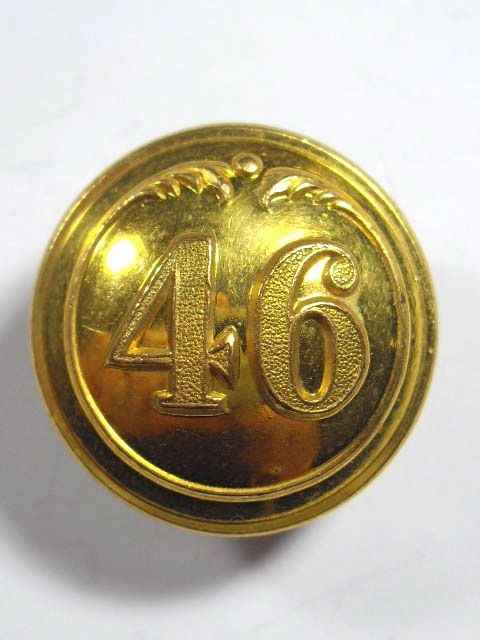
Brass button from the uniform of the 46th Regiment

Foot Soldier, 46th Regiment of New South Wales, Australia
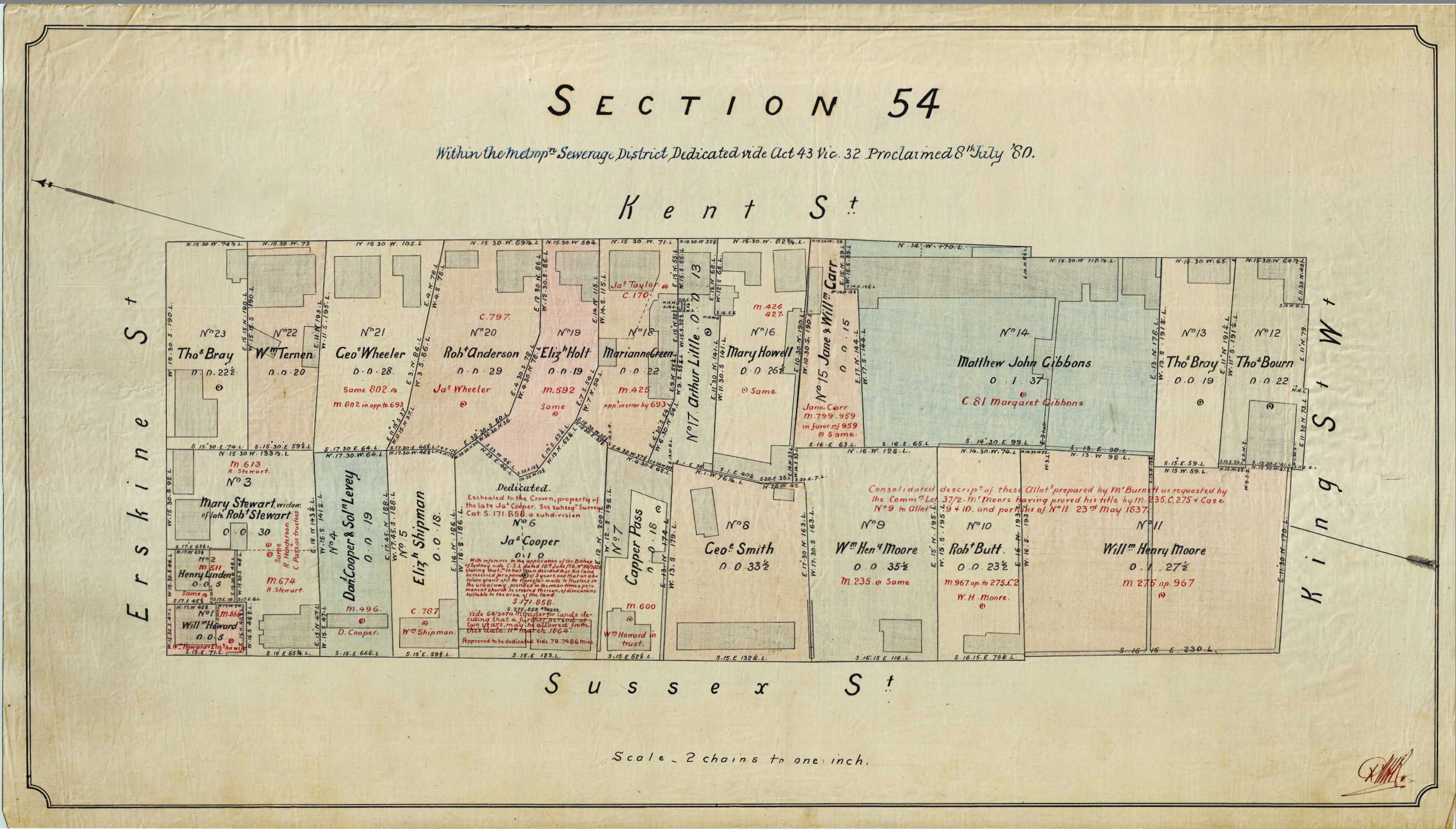
Section 54, Corner of Erskine and Sussex Streets, Sydney, the Stewart’s land is bottom LHS
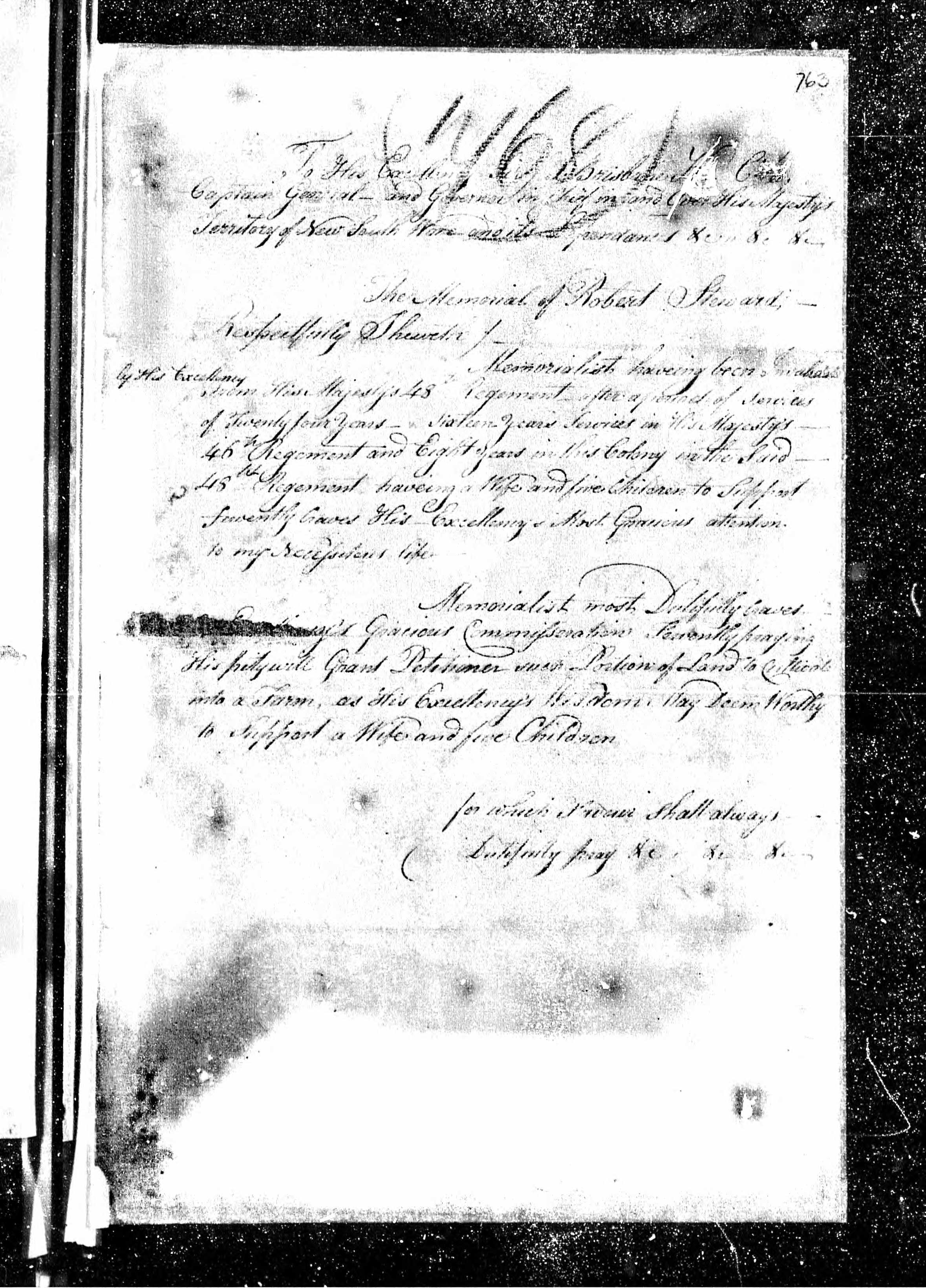
Memorial to the Governor, New South Wales Colonial Secretary’s Papers 1788-1856, Robert Stewart, November 1825
This plead letter to the Governor from Robert Stewart explains his predicament upon retirement, formerly of the 48th Regiment, he is married with five children to support and he is desirous of a land grant.
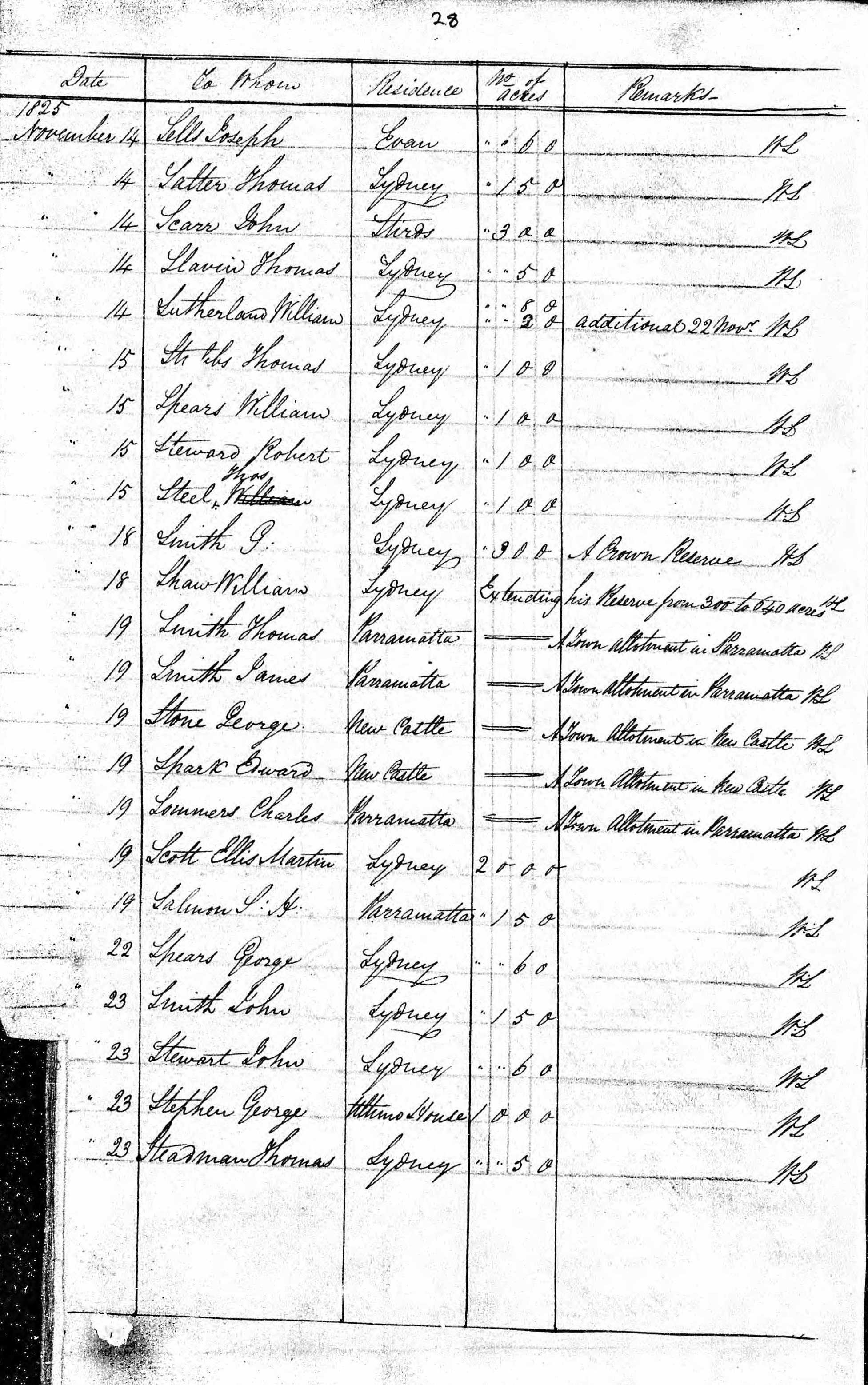
Robert Stewart, 10 square perches, Sydney, on a list of Land Grants by Sir Thomas Brisbane, 1824, New South Wales, Australia, Colonial Secretary’s Paper’s, 1788-1856
Incredibly, Robert Stewart pleaded for lands to be granted to him further west of Sydney so he could settle down as a farmer, and apparently he was dismayed to be granted only 1 acre of land on the corner of Sussex and Erskine Streets in the township of Sydney, in a busy acreage of the town, with little farming opportunity. If only the Stewarts could be alive today to see this area of land in the central CBD of Sydney, which can only leave one speechless to its value. Robert had no choice but to return to his previous occupation as that of a tailor.
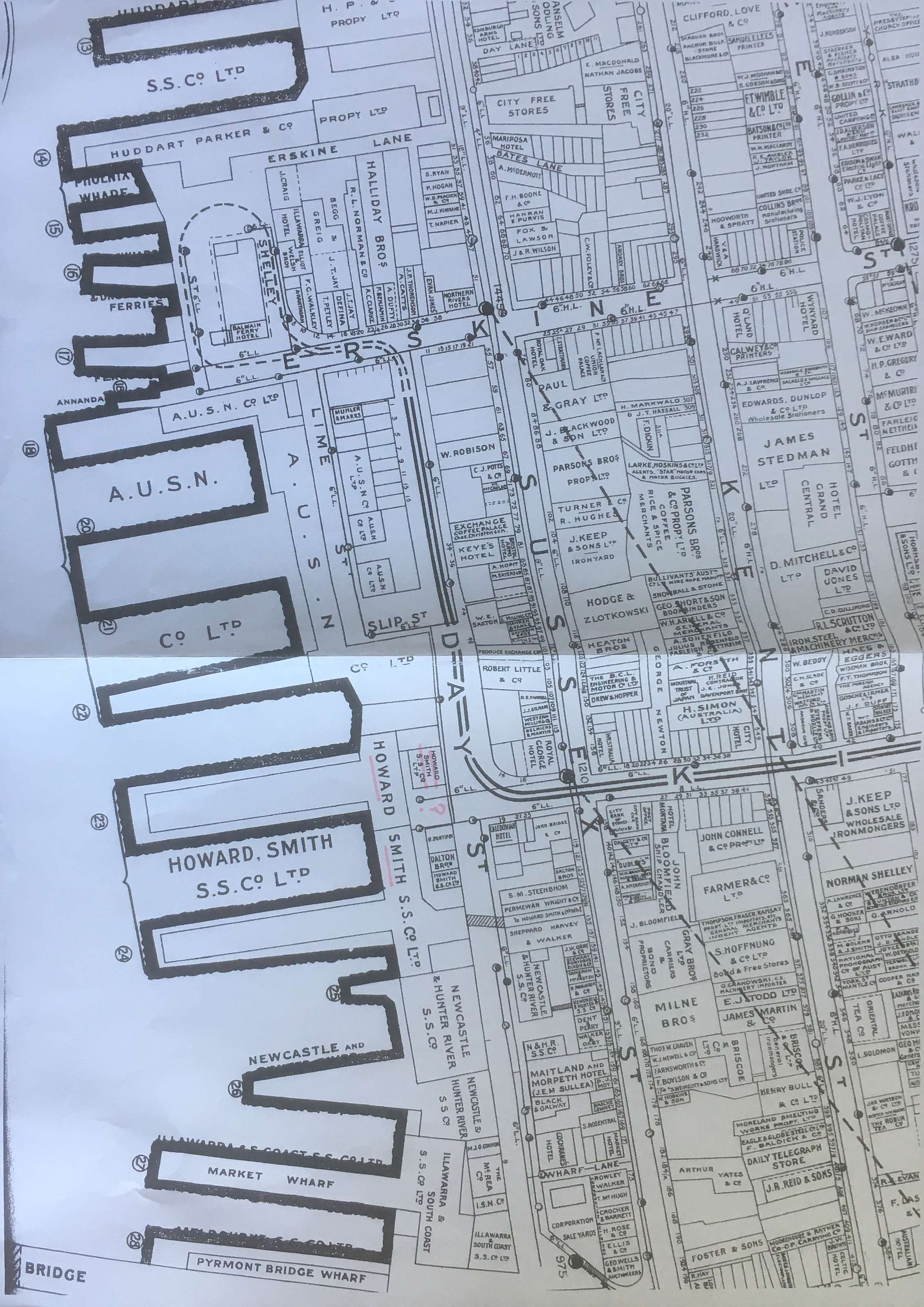
Map of early Sydney showing The Royal Hotel on the Cnr. of Sussex and Erskine Streets image courtesy of Potsy Quigley.
Metropolitan Water and Sewerage Map showing the Stewart’s land on the corner of Sussex and Erskine Streets, and also George Smith’s land on Sussex Street, George being the father of Ann Stewart who married Thomas Stewart Snr. the son of William Stewart. Image courtesy of Potsy Quigley
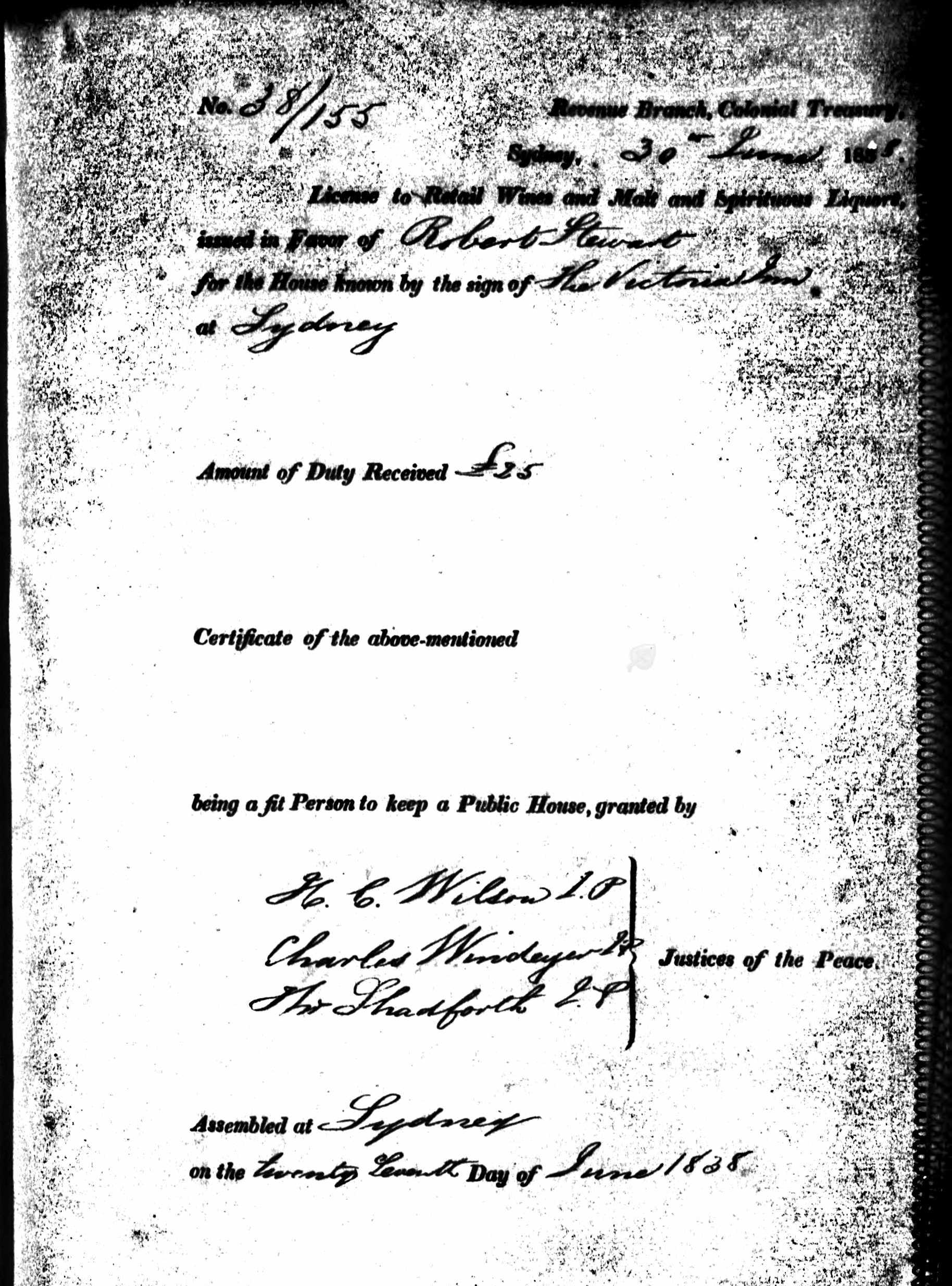
New South Wales, Australia, Certificates for Publican’s Licences, 1830-1848, for Robert Stewart June 1838
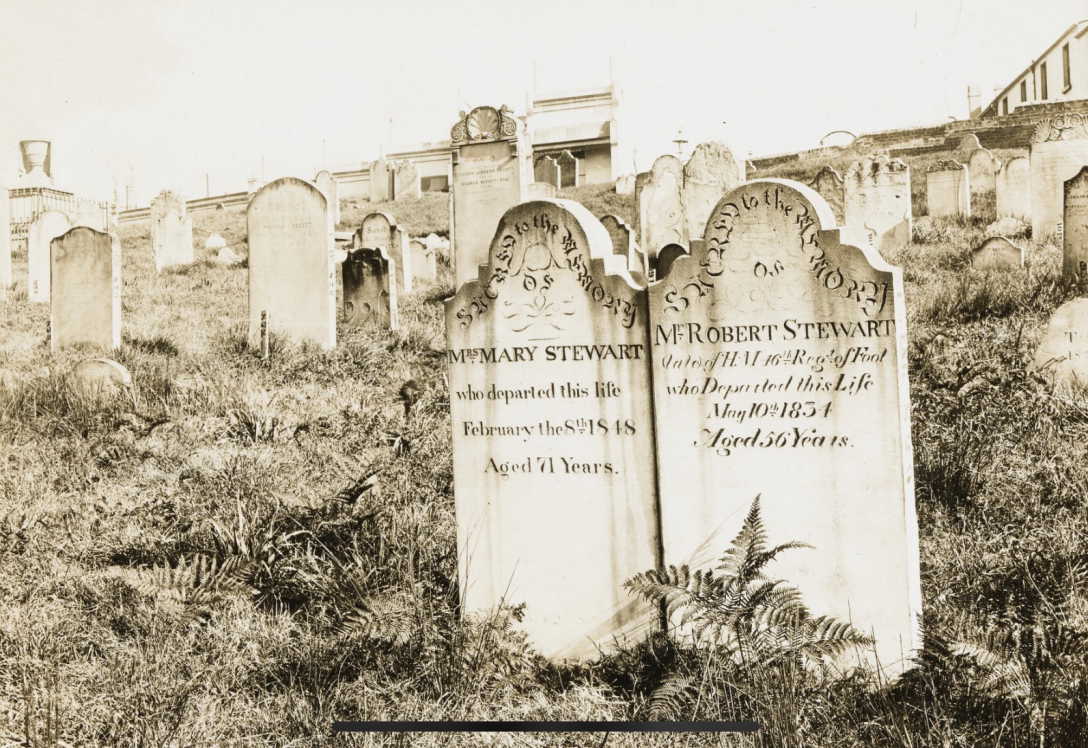
Headstones of Robert Stewart, 46thRegiment of Foot and his wife Mary Stewart, Devonshire Street Cemetery, Mrs Arthur George Foster Collection, comprising glass negative photographs, image courtesy of the Mitchell Library, State Library of New South Wales, circa 1901. Information about the existence of this photograph was kindly provided by Mary Petrov, who uploads images to Find a Grave. Mary very kindly contacted a descendant of the Stewart family, Robert Strang, who then shared it with the wider Stewart descendants in March 2019.
It is absolutely wonderful to have this photograph of Robert and Mary Stewart’s headstones at Devonshire Street Cemetery, before it was razed to the ground to make way for Central Railway in 1901. Some descendants feel that the Stewart headstones were removed to Bunnerong Cemetery with many other unclaimed gravesites, although there is always the possibility that they were resumed and reburied at Balmain Cemetery with Robert’s son Thomas Stewart Snr, who had his family grave in this cemetery. Sadly, Balmain Cemetery was razed to the ground in a most insensitive manner during the early 1940’s and so many headstones were crushed into the ground to make way for Balmain Memorial Park, with little attempt at resumption or sensitive preservation

Sydney Morning Herald, 23 June, 1834, Claims to Land
This interesting claim to land was advertised in the Sydney Morning Herald six weeks after Robert Stewart’s death.
Robert Stewart and Mary Bowman (1777-1848) had five children, John Stewart (1801-1877), Elizabeth Stewart (1804-1875), Henry Stewart (1814-1866), William Stewart (1814-1869) and Thomas Stewart Snr. (1819-1883).
John Stewart was born in Limerick, Ireland in 1802, where his parents were living, his father Robert Stewart was attached to the 46th Regiment of Foot and he had been serving in the army during the Napoleonic Wars.
Ireland, Births and Baptisms, 1620-1911:
| Name | John Stewart |
| Gender | Male |
| Baptism Date | 6 Jun 1802 |
| Baptism Place | Cathedral St Mary, Limerick, Limerick, Ireland |
| Father | Robert Stewart |
| Mother | Mary |
| FHL Film Number | 897365 |
Australia Marriage Index, 1788-1949:
| Name | John Stewart |
| Spouse Name | Lydia Bates |
| Marriage Date | 1825 |
| Marriage Place | New South Wales |
| Registration Place | Sydney New South Wales |
| Registration Year | 1825 |
| Volume Number | V B |
John Stewart (1801-1877) and Lydia Bates (1806-1867) had eight children, Mary Ann Stewart ( 1826-), John (1828-) James Enoch Stewart (1830-1897), William Henry Stewart (1835-1899), Robert M Stewart (1836-1888), Nathaniel Joseph Stewart (1838-1838) Joseph Nathaniel Stewart (1840-1840), George Stewart (1842-1843), Charles Richard A Stewart (1845-1845) and Lydia Stewart (1846-)
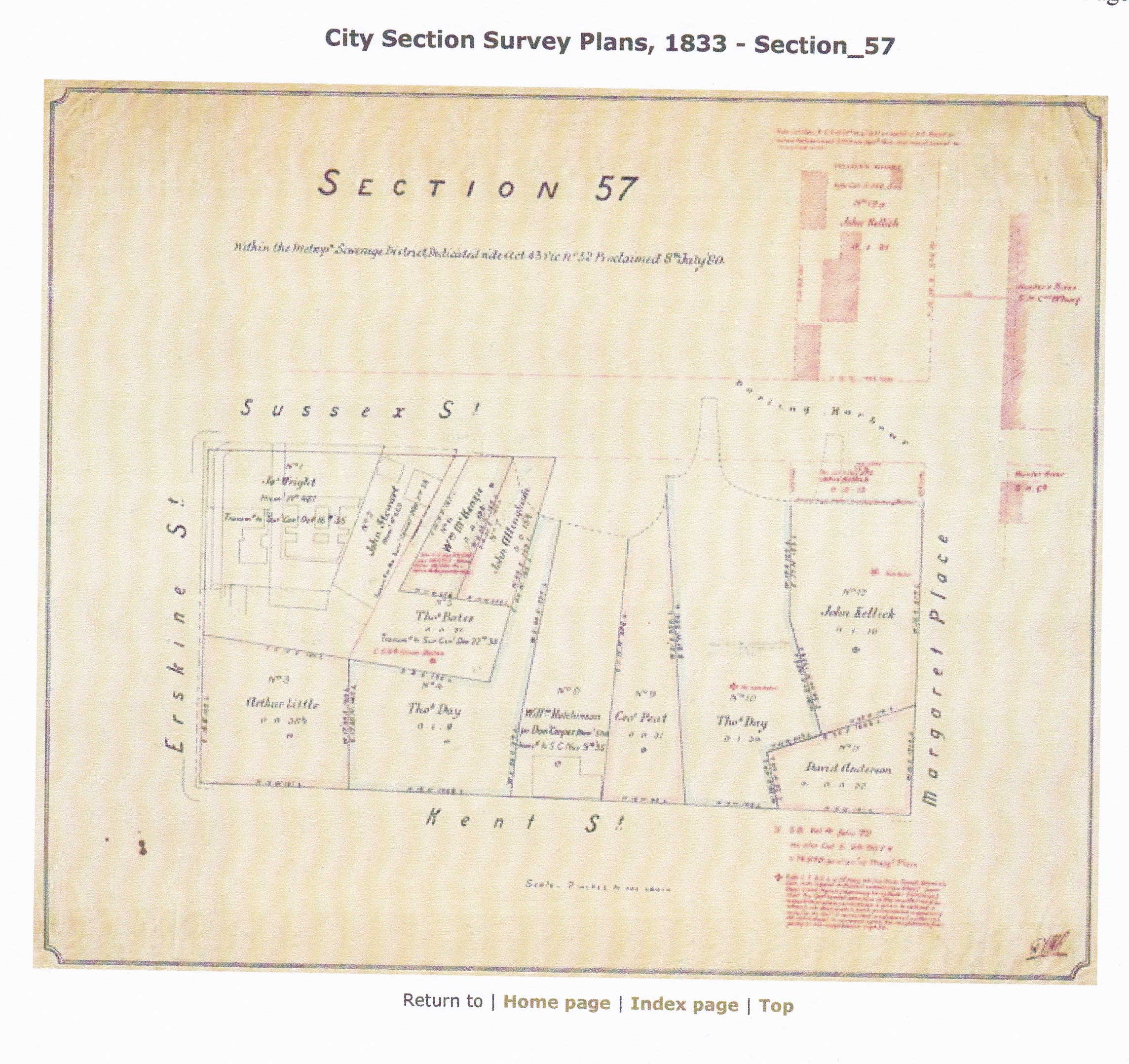
Land Grant to John Stewart, 24 November 1830, Cockle Bay, New South Wales. Image kindly provided by Warwickv1 from ancestry.com Venables Family Tree.
John was granted an allotment next to Thomas Bates in Sussex Street. Thomas Bates was John Stewart’s father-in-law.
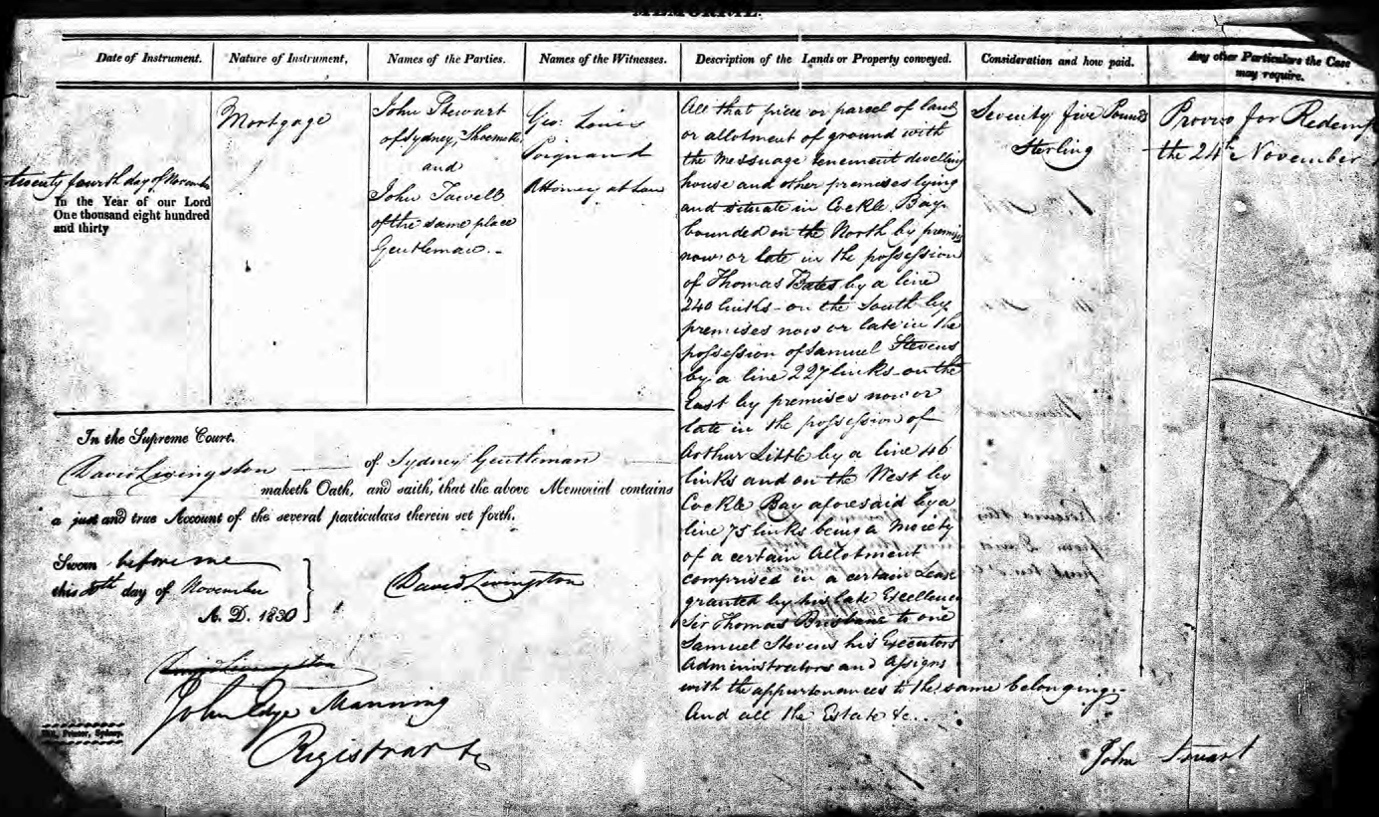
N.S.W. Land Grant, Register of Memorials, 1788- 1963 for John Stewart, 24 November 1830
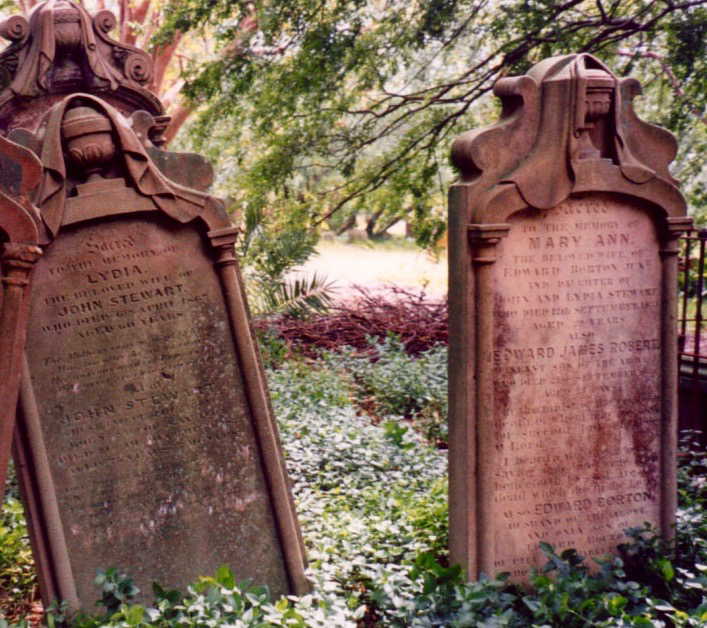
Headstone of John and Lydia Stewart, on left hand side, and Edward and Mary Ann Borton, on right hand side. Camperdown Cemetery, Newtown, Sydney, image courtesy of Neil Stewart
Neil Stewart has a well-illustrated and comprehensive family tree called Neil Stewart Family Tree on ancestry.com. Mary Ann being the daughter of John Stewart and Lydia Bates. Camperdown Cemetery is where the Brown Family Vault is also found, William and Mary Ann Brown being the parents of Eliza Brown who married Thomas Stewart Jnr. This grave and its restoration in 2013 is included in another family chapter, William Brown – A Proud Australian.
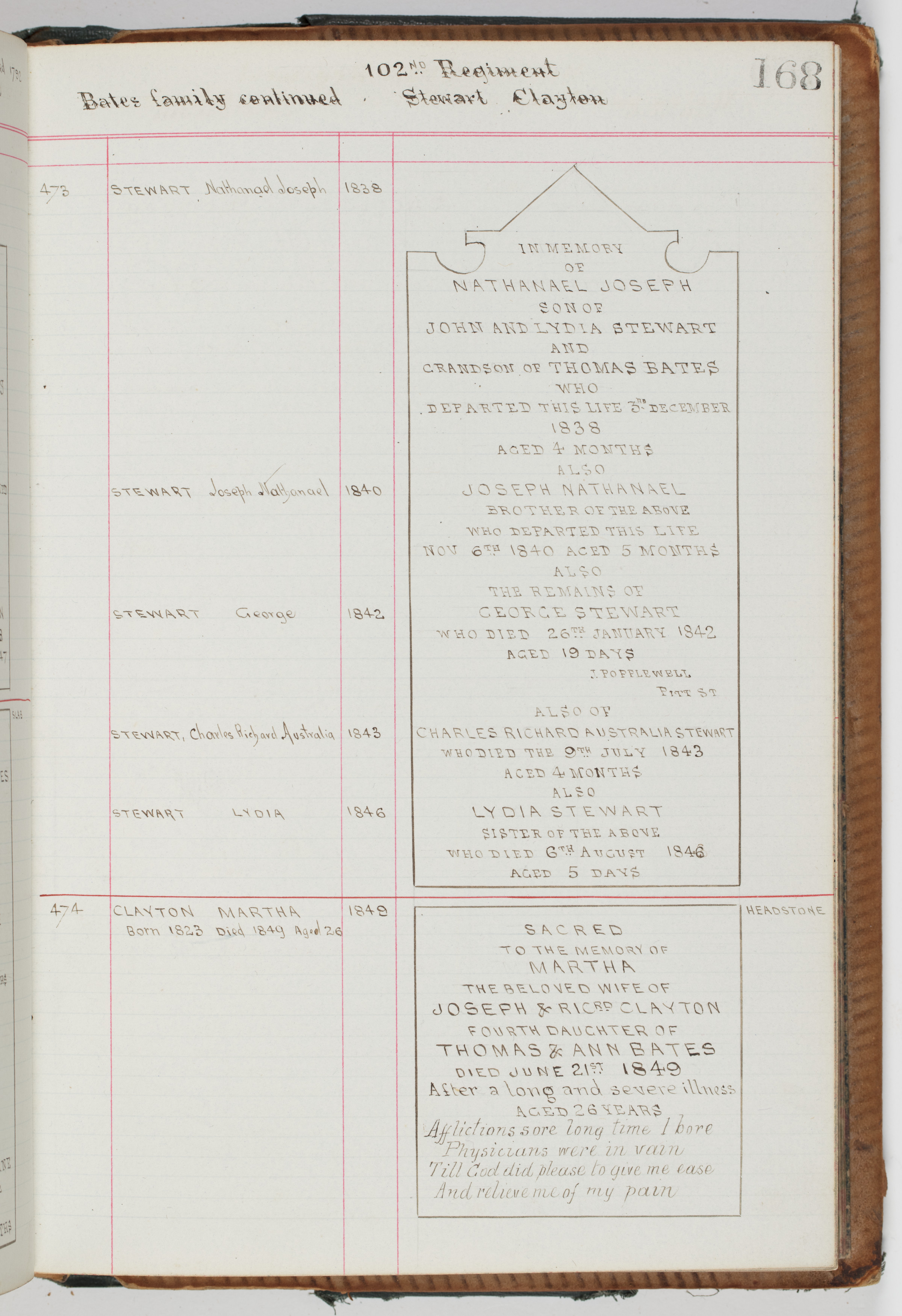
Headstone Transcription from Devonshire Cemetery for the infant children of John and Lydia Stewart, Arthur George Foster Papers 1901, Mitchell Library, State Library of New South Wales page 168
It was exciting to find these precious transcriptions amongst the Mitchell Library Collection. I had actually been searching for the transcriptions for Robert and Mary Stewart and I came across this document first. Arthur George Foster was an ardent, methodical and meticulous historian who transcribed several hundred headstones from Devonshire Cemetery. His wife photographed many headstones as well and they spent nearly all their free time in 1901 at the cemetery undertaking this tremendous task before the cemetery was razed to make way for Sydney’s Central Railway. This record for the Stewarts was actually recorded under the Regimental inscriptions because Lydia Stewart’s father Thomas Bates was a Regimental Officer from the 102nd, 73rd and 46th Regiments and he arrived in Australia in 1790 aboard the Neptune, part of the notorious Second Fleet.
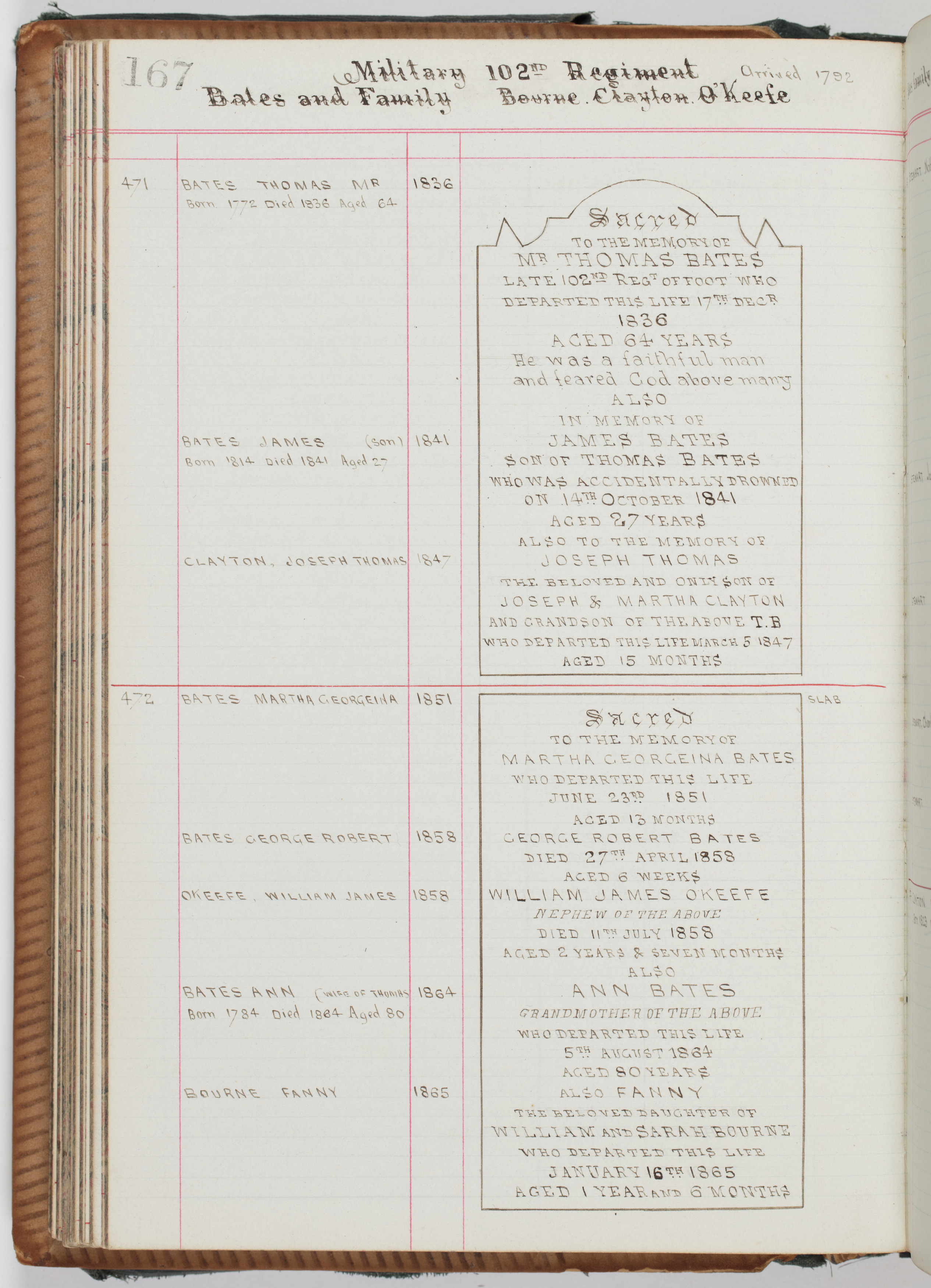 Headstone Transcription from Devonshire Cemetery for Thomas and Ann Bates together with several of their children and grandchildren, Arthur George Foster Papers 1901, Mitchell Library, State Library of New South Wales page 167
Headstone Transcription from Devonshire Cemetery for Thomas and Ann Bates together with several of their children and grandchildren, Arthur George Foster Papers 1901, Mitchell Library, State Library of New South Wales page 167
Earlier I illustrated the 1828 Census of Sydney which showed John Stewart, wife, Lydia and his two children Mary Ann and John living next door to his parents in Erskine Street, Sydney. I also illustrated the Sands Directory of 1859 which showed John, a grocer, living in Elizabeth Street, Paddington.
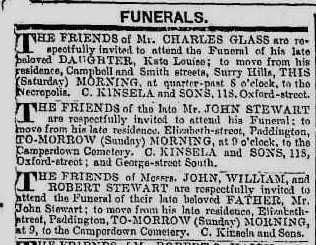
Funeral of Mr John Stewart of Elizabeth Street, Paddington, Sydney Morning Herald, 22 Dec 1877
Robert and Mary Stewart’s daughter Elizabeth Stewart (1804-1875) married William Howard (1804-1877) in 1826, and they had nine children, William Howard (1827-1915), Agnes Howard (1829-1892), Mary Hannah Howard (1832-1866), Isaac Howard (1834-1914), Robert Howard (1837-1875), John Howard (1839-1894), Susannah Howard (1840-), Martha Elizabeth Howard, (1842-) and Annie Eliza Howard (1842-1882).
Australia Marriage Index, 1788-1949:
| Name | William Howard |
| Spouse Name | Elizabeth Stewart |
| Marriage Date | 1826 |
| Marriage Place | New South Wales |
| Registration Place | Sydney New South Wales |
| Registration Year | 1826 |
| Volume Number | V |
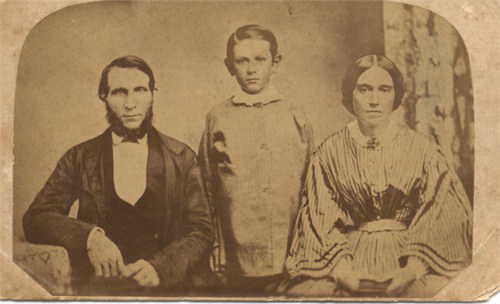
William and Elizabeth Howard and son William, circa 1835, photo courtesy of Kath Booth nee Waterman, the daughter of Harold Osborne Waterman.
Harold was the son of Annie Eliza Howard, daughter of William and Elizabeth Howard. Kindly uploaded to ancestry.com by another Stewart family researcher, Ann Dodd, who, since 1995 now has the photograph in her safe keeping.
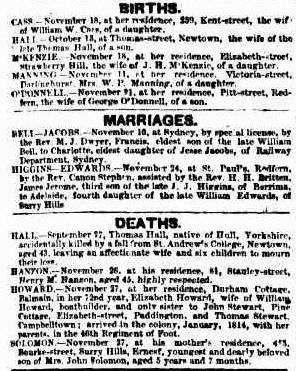
Death notice of Elizabeth Howard nee Stewart, Sydney Morning Herald, 29 November 1875
This is a wonderful notice, with so much information, confirming her father’s status as part of the 46th Regiment of Foot. Notice her brother Thomas is listed living at Campbelltown.
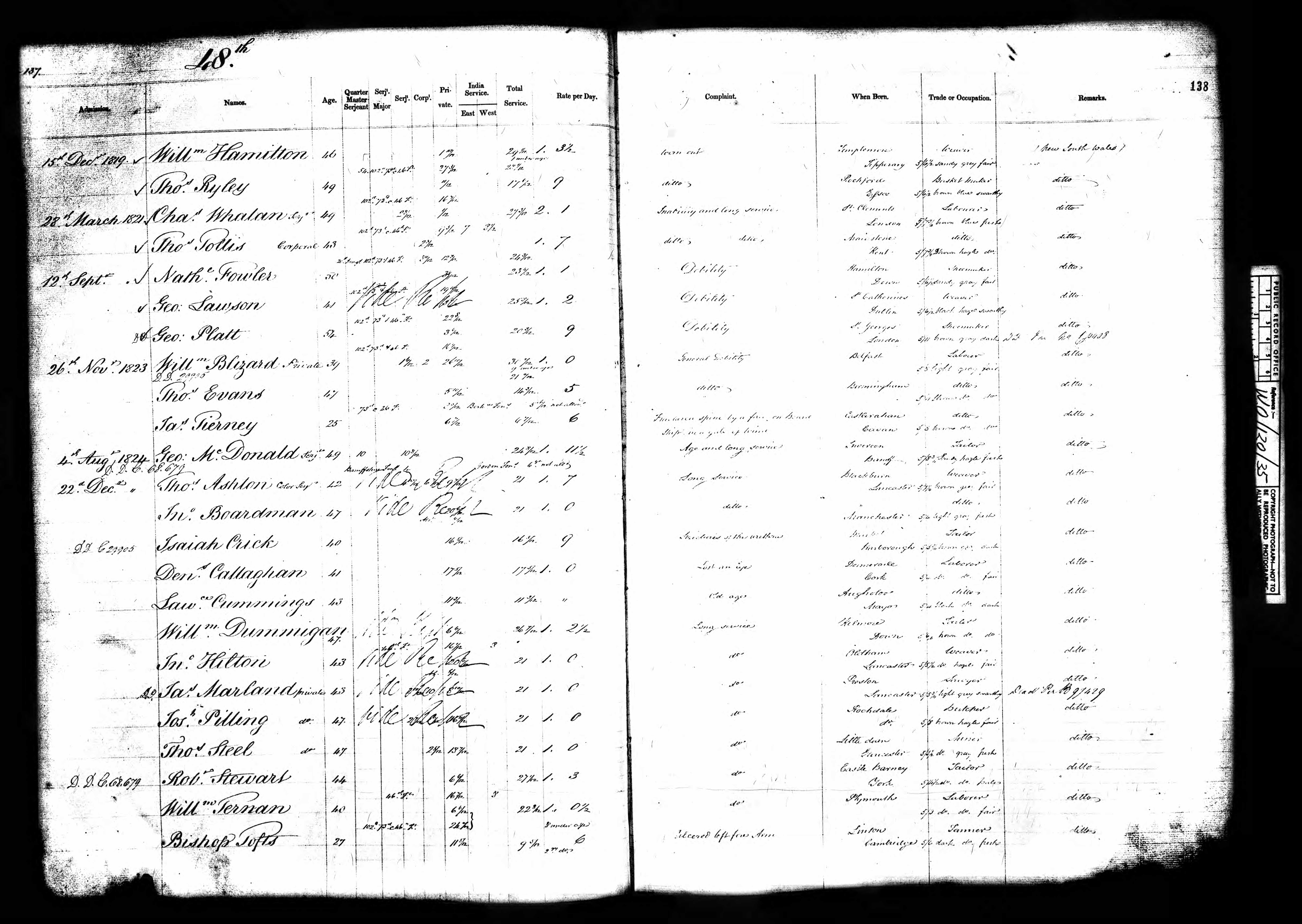
U.K. Royal Hospital, Chelsea, Regimental Registers of Pensioners 1713-1882 for Robert Stewart, resigned from Regiment 22 December 1824
This record lists Robert Stewart’s original details from Barney Castle, Yorkshire and even gives his height at five feet, four and a half inches, grey eyes and pale complexion and gives his time in the regiment at twenty seven and a half years. Whilst the top of this document lists 48th Foot Regiment, I feel confident in collecting this record for Robert Stewart.
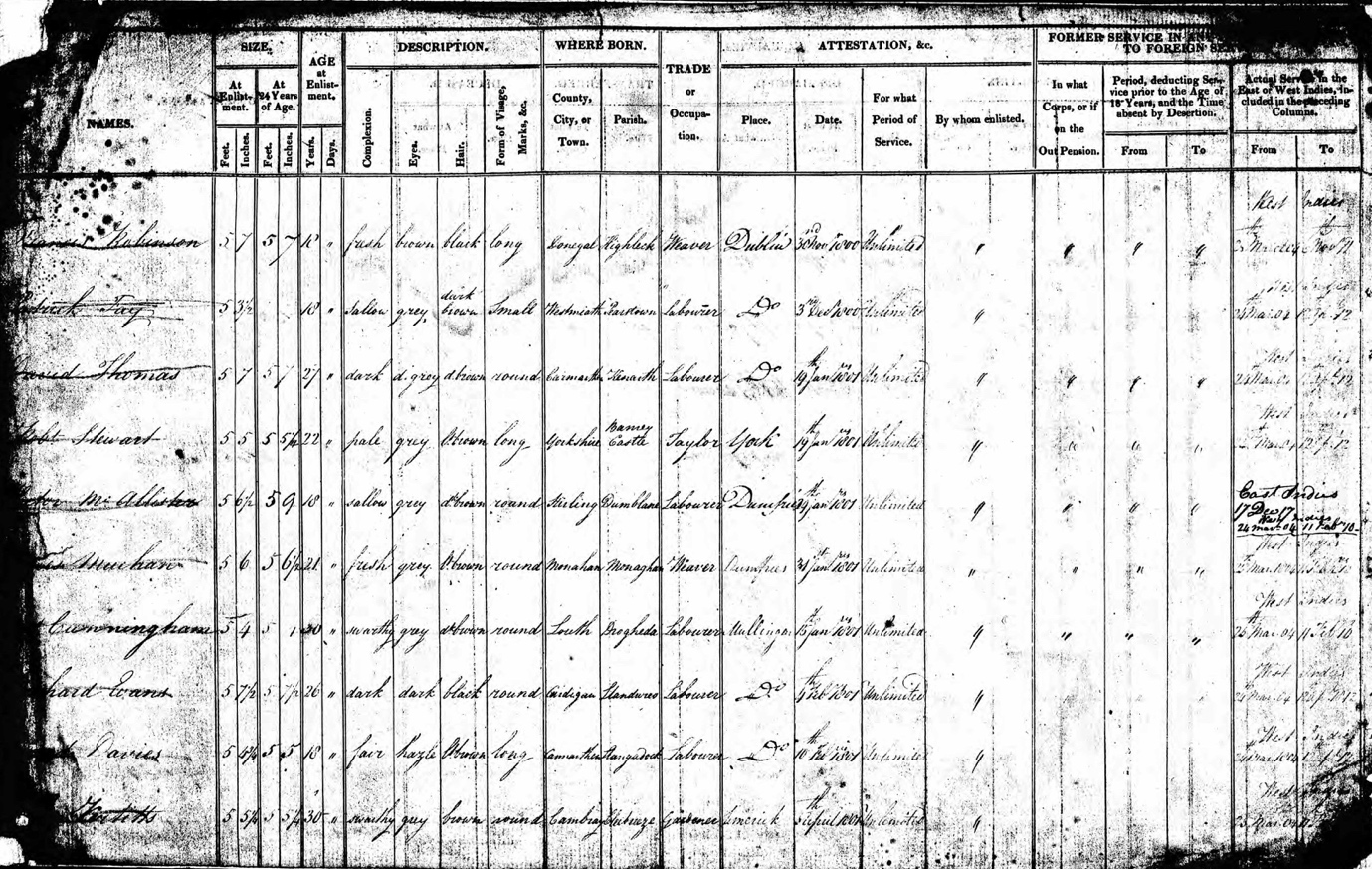
Canada, British Regimental Registers of Service, 1756-1900, for Robert Stewart, 46th Foot Soldier, 19 January, 1801
The 46th Regiment of Foot was originally raised in Yorkshire in 1741 and was called John Price’s Regiment, after their General, they proceeded to Scotland where they first saw action in the Battle of Prestonpans in September 1745, during the Jacobite rising. In May 1757 the 46th Regiment of Foot saw action in Nova Scotia and America until 1760 when the Regiment was posted to the West Indies in October 1761 and then back to America for the American War of Independence. The Regiment returned to England in 1782.
It may have been during this time back in England that some of the Regiment was stationed in Ireland. As can be seen from the Canadian document, Robert Stewart joined the 46th Regiment of Foot on 19 January 1801. A few months later on 5 April 1801 he married Mary Bowman at St Peter’s Church, Leeds, Yorkshire.This document for Robert Stewart is lodged amongst the Canadian Service Register, however it is questionable whether he saw service in Canada. It is a fact that Robert Stewart’s first son John Stewart was baptised in Limerick, Ireland on 6 June 1802. There may have been a small contingent of the 46th Regiment of Foot who were stationed there.
“The regiment embarked for the West Indies in November 1794 and helped suppress an insurrection by caribs on Saint Vincent before returning home in November 1796. It returned to the West Indies in April 1804 and, fighting alongside the 1st West India Regiment in February 1805, defended Dominica against a French force for over a week until the French abandoned the attack; hence the regiment’s first battle honour “Dominica”.The regiment took part in another action when in May 1806 when 40 of its soldiers boarded the packet boat Duke of Montrose and set out in pursuit of the French privateers Napoleon and Imperial: they captured the Imperial and its crew. The regiment took part in the invasion of Martinique in February 1809 and then returned to England in December 1811. The regiment embarked for New South Wales in August 1813: they were stationed at Hobart on Van Diemens with orders to suppress a gang of bushrangers It then sailed for Madras in September 1817and, after a tour in India, returned to England in March 1833.” A short history of the 46th (South Devonshire) Regiment of Foot from Wikipedia
This document contained an amazing piece of information, giving Robert Stewart’s place of origin as Barney Castle, Yorkshire, and his age as 22 years. “Barnard Castle is a market town in Teesdale, County Durham, England. It is named after the castle around which it grew up. It is the main settlement in the Teesdale area, and is a popular tourist destination.” Wikipedia
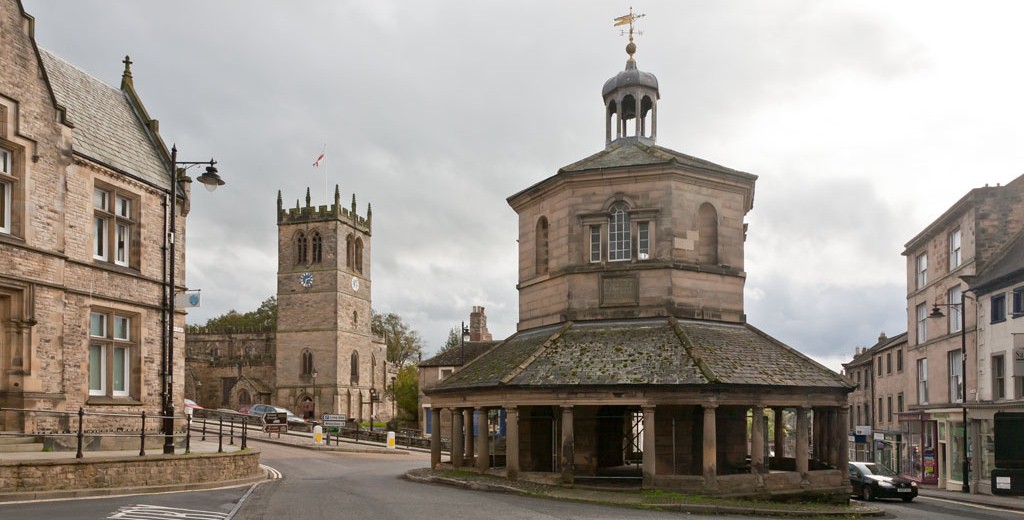
Barney Castle, market town, Yorkshire, image courtesy of Wikipedia, free online encyclopaedia
Barney Castle is close by to Startford, Yorkshire where Robert Stewart was born. This marriage record for Robert Stewart gives his Regiment as the 46th Foot Regiment.
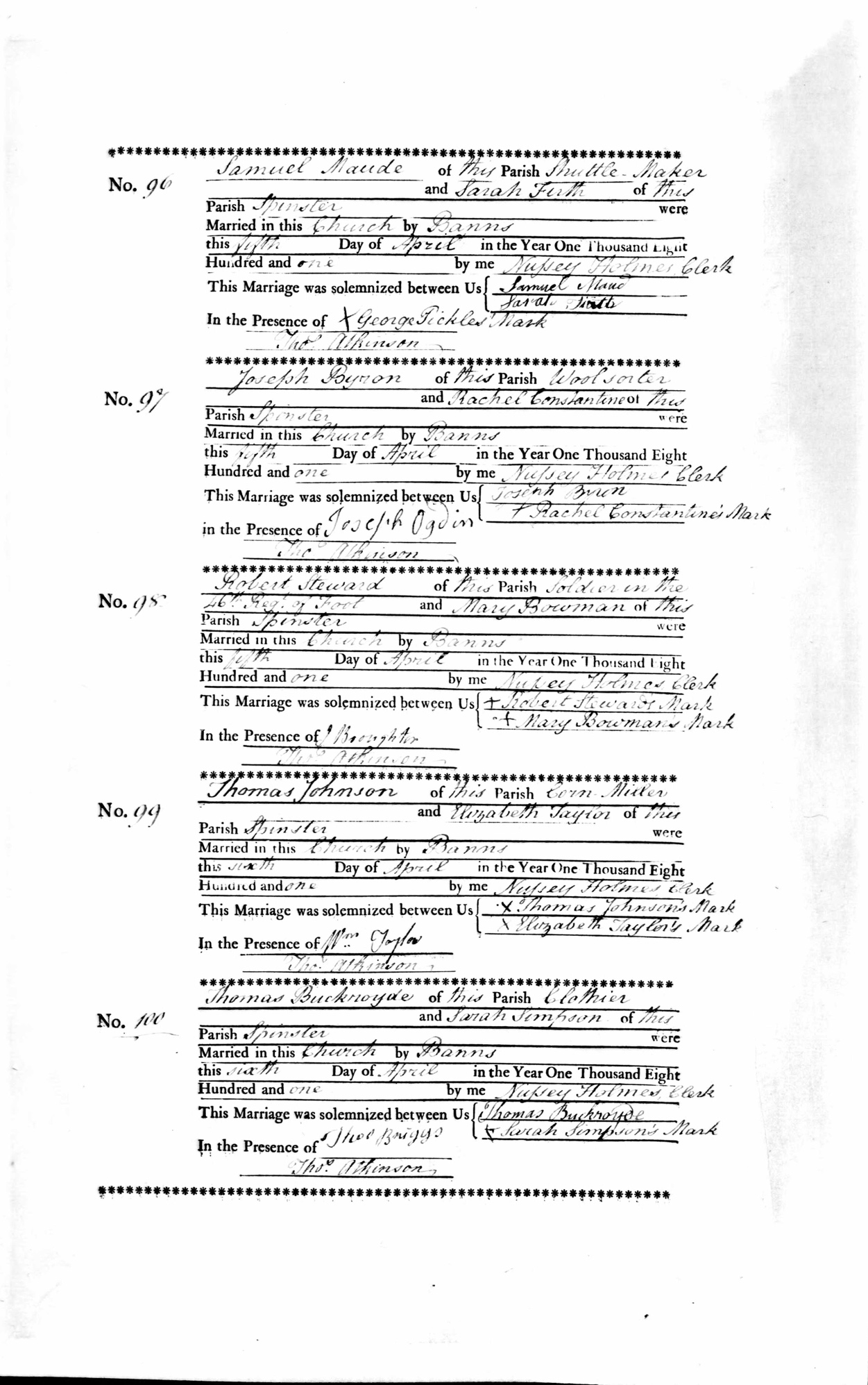
Marriage of Robert Stewart and Mary Bowman, 5 April 1801, St Peters, Leeds, West Yorkshire, England, Church of England Baptisms, Marriages and Burials 1510-1812
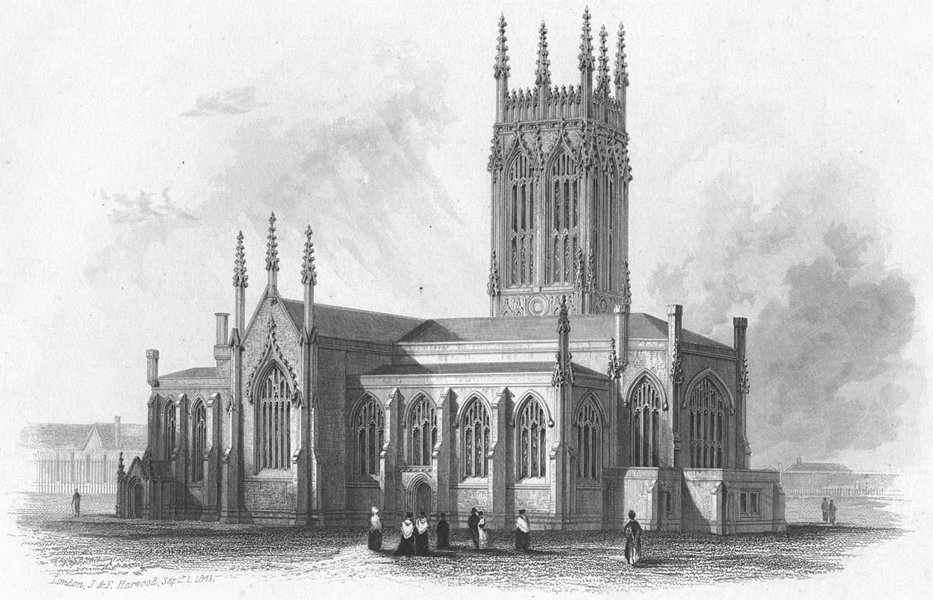
St Peter’s, Leeds, Yorkshire, 1855, J & E Harwood, antique print from Vignette view book
I then found this transcription for the Baptism of Robert Stuart which I am confident is correct.
England, Select Births and Christenings, 1538-1975:
| Name | Robert Stuart |
| Gender | Male |
| Baptism Date | 31 May 1778 |
| Baptism Place | Startforth, York, England |
| Father | Robert Stuart |
| Mother | Martha |
| FHL Film Number | 207584 |
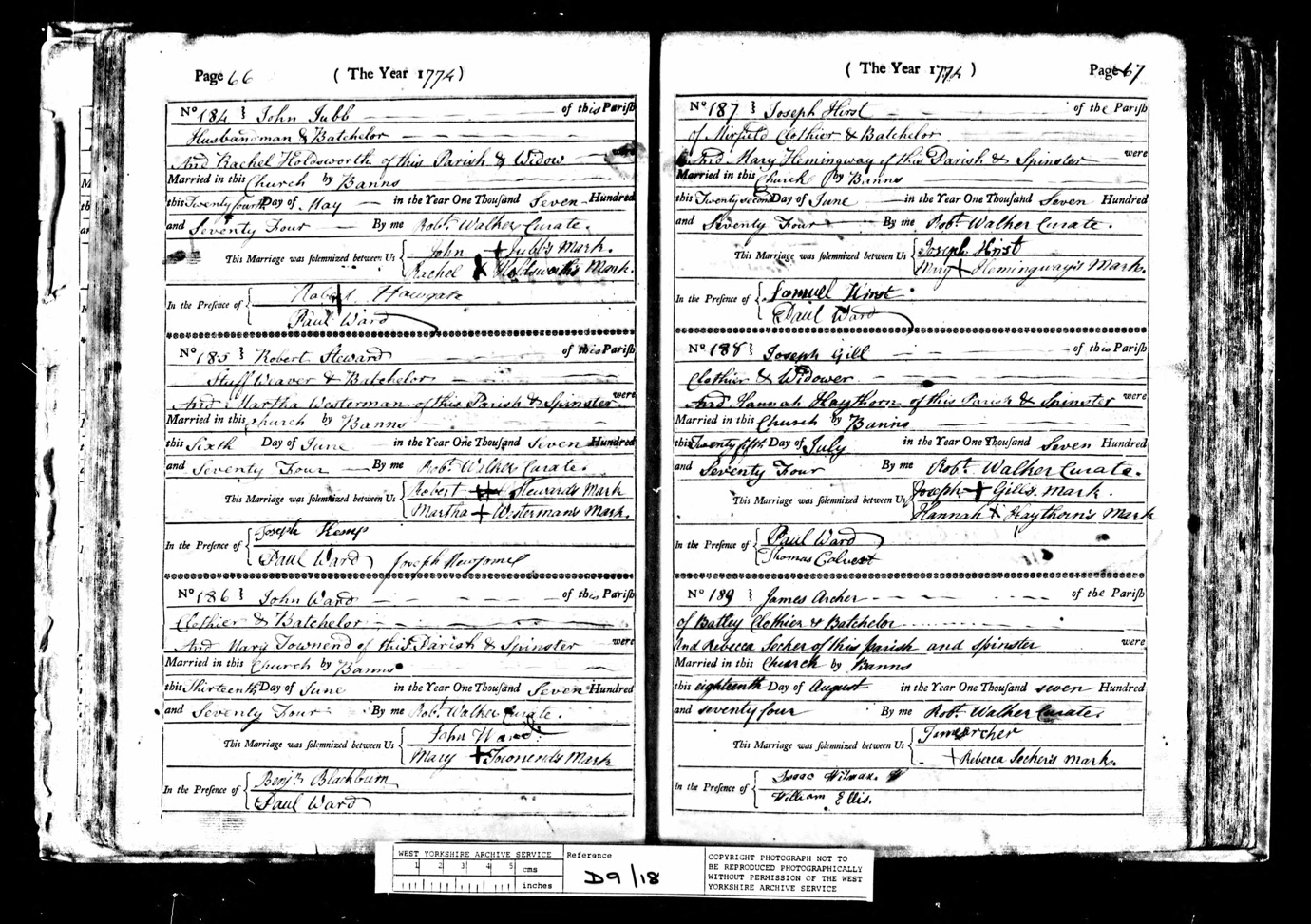
Marriage of Robert Stewart and Martha Westerman, 6 June 1774, All Saints, Dewsbury, West Yorkshire, England, Church of England Baptisms, Marriages and Burials, 1512-1812
UK, Royal Hospital Chelsea Pensioner Soldier Service Records, 1760-1920
| Name | Private Robt Stewart |
| Enlistment Age | 18 |
| Discharge Age | 34 |
| Birth Date | abt 1783 |
| Birth Place | Castle Barney York, England |
| Enlistment Year | 1801 |
| Discharge Year | 1817 |
| Regiment | 48th Regiment of Foot |
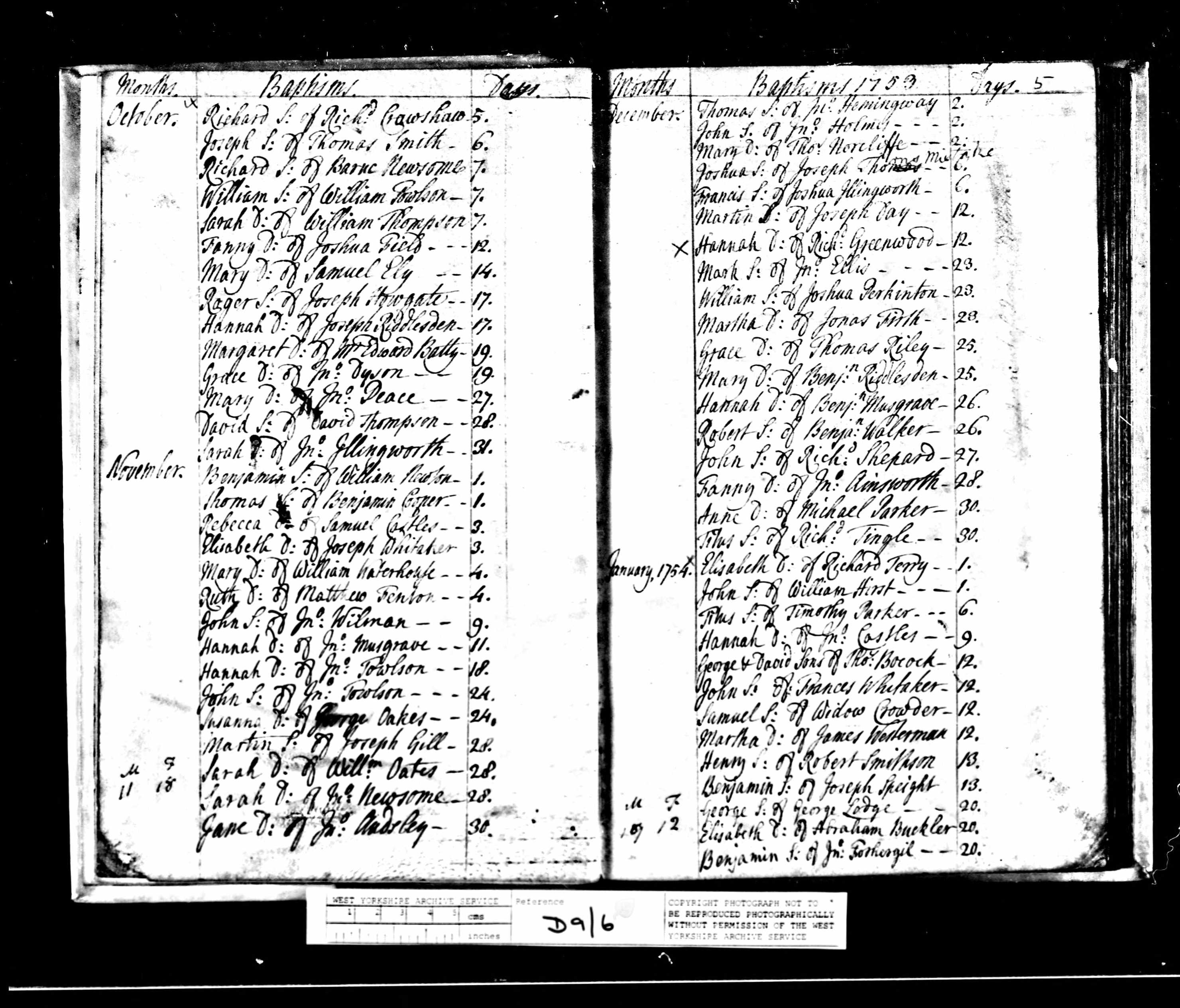
Baptism of Martha Westerman, daughter of James Westerman, 12 January 1754, All Saints, Dewsbury, West Yorkshire, England, Baptisms, Marriages and Burials, 1512-1812
THE SMITH FAMILY
Ann Smith married Thomas Stewart Snr., she was the daughter of George Smith alias Taylor, a convict who had arrived in Sydney aboard the Baring in 1815. Various convict indents, census and prison reports describe George Smith as a native of Wiltshire, England. One documents even lists George as 5 feet 8 inches tall with brown greying hair, with a ruddy complexion and hazel eyes. George Smith was convicted of forgery and sentenced to 14 years transportation to Sydney, and before that he was apparently held on a prison hulk, the Retribution, in Woolwich, England. George Smith is listed as a boot and shoe maker and so must have been the sort of convict, if reformed, who the New South Wales Governor may have seen as desirable type of person to make a contribution to the Colony. George’s start though was surprisingly not a good one, and from the Colonial Secretary’s Index 1788-1825 the following year George along with other convicts aboard the Lady Nelson were transported to Newcastle, held in chains and put on a watch list. The conditions in Newcastle, New South Wales were appalling, and prisoners were often cruelly whipped and left without any medications for their wounds. The convicts were held in a camp on Nobby’s head which became notorious, rather like the Port Arthur of New South Wales and only the worst offenders were sent there. George Smith must have made up his mind to get out of that place and obviously had the good sense to mend his ways.
Colonial Secretary Index, 1788-1825
| SMITH, George. Per “Baring”, 1815; shoemaker; husband of Sarah, widow of Thomas Blades | |
| 1816 Nov 21 | To be strictly watched & for some months to be kept in irons at Newcastle (Reel 6005; 4/3495 p.292) |
| 1816 Nov 21 | On list of prisoners sent to Newcastle per “Lady Nelson” (Reel 6005; 4/3495 p.293) |
| 1817 Mar 29 | Prisoner at Newcastle. Allowed to return to Sydney before his sentence had expired (Reel 6066; 4/1806 pp.68a-b) |
| 1818 May 4,5 | Re permission to marry Sarah Blades at Sydney (Reel 6006; 4/3498 p.202) |
| 1819 Nov 20; 1820 Jan 3 | Petition of his wife Sarah for mitigation of his sentence (Fiche 3200; 4/1860 p.35) |
| 1825 May 9 | Of Cockle Bay. Petition of Mary Smith to have her husband, Thomas Smith per “Grenada”, servant of George Smith, reassigned to her (Fiche 3252; 4/1875 p.212) |
| 1825 Nov | To be granted a conditional pardon (Fiche 3292; 4/6974.1 pp.47, 74) |
SMITH, Sarah (Came free per “Broxbornebury”, 1814) see also BLADES, Sarah
| SMITH, Sarah. Came free per “Broxbornebury”, 1814; widow of Thomas Blades, per “Surrey”, 1814; wife of George Smith, per “Baring”, 1815 | |
| 1819 Nov 20 | Petition for mitigation of the sentence of her husband George (Fiche 3200; 4/1860 p.35) |
| 1822 Aug 1 | Memorial for land in Sussex Street, Cockle Bay (Fiche 3053; 4/1832 No.360A) |
| BLADES, Thomas. Per “Surrey”, 1814 | |
| 1815 Jan 23 | Referred to in evidence at inquest on Elizabeth Howell held at Sydney (Reel 6021; 4/1819 p.323) |
| 1819 Nov 20 | Lost shortly after the arrival of his wife Sarah and three children per “Broxbornebury” in a gale of wind in Cockle Bay; his wife subsequently married George Smith for whom she was petitioning for mitigation of sentence (Fiche 3200; 4/1860 p.35) |
| STEWART, Robert. Formerly of 48th Regiment | |
| 1825 Nov | Invalid from 48th Regiment. Memorial; as Steward (Fiche 3157; 4/1844B No.768 pp.763-4) |
| 1825 Nov 15 | On list of persons who have received orders for grants of land; listed as Steward (Fiche 3266; 9/2652 p.102); on list of lands granted & reserved by Sir Thomas Brisbane (Fiche 3269; 9/2740 p.28) |
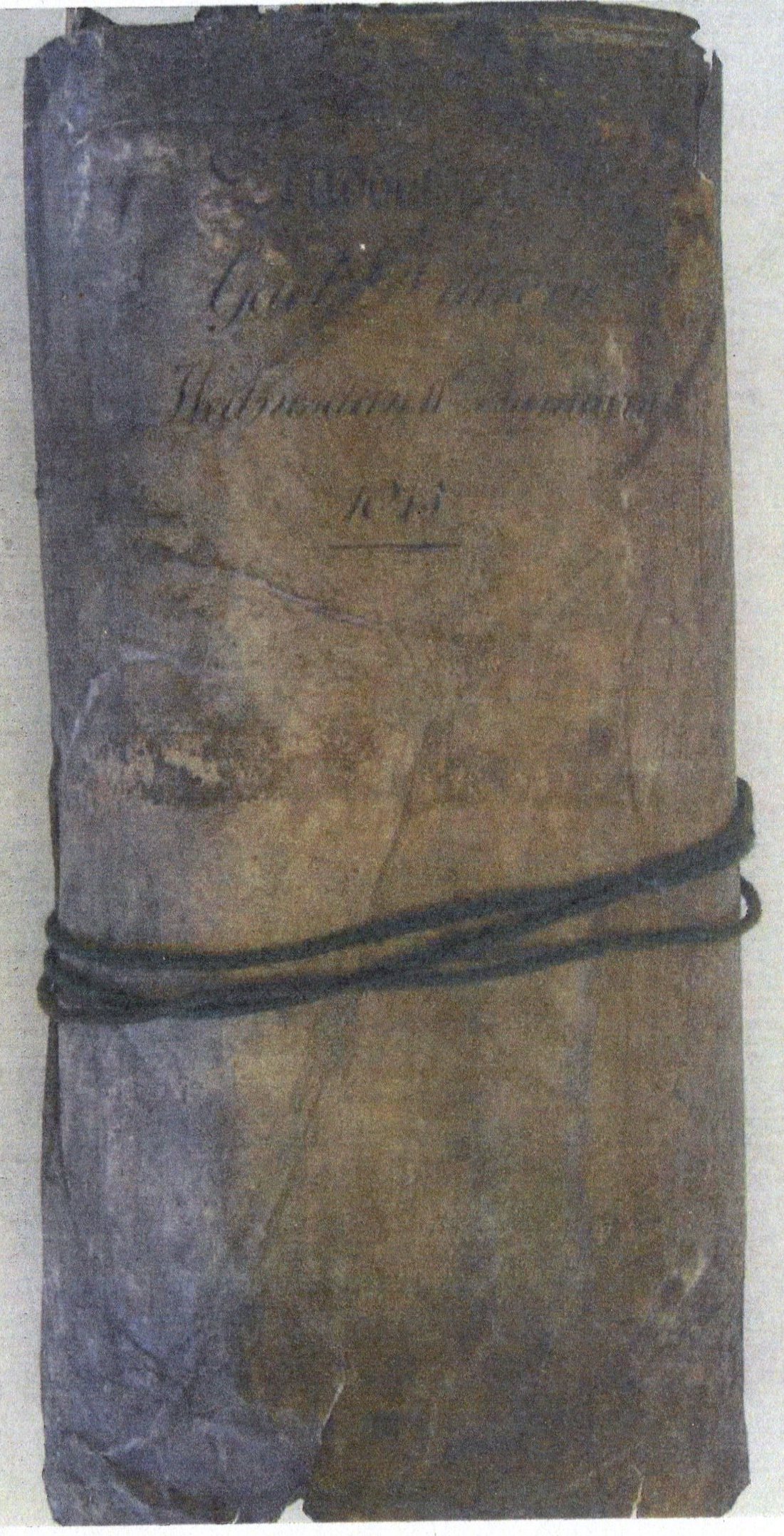
Cover document from the Court Proceedings and Delivery to Middlesex Gaol for George Smith 11 January 1815, image courtesy of Potsy Quigley
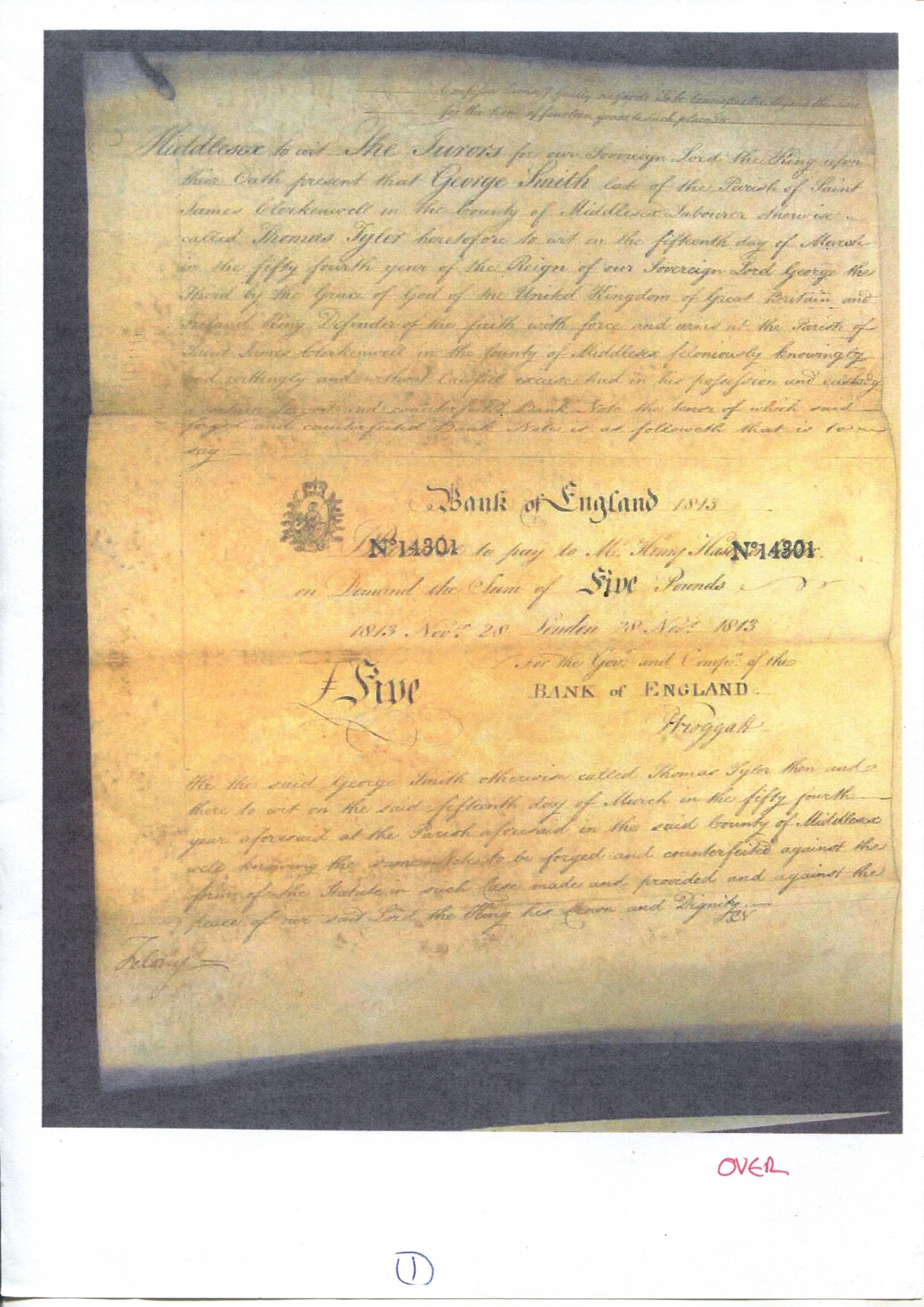 Crime, Jury Findings and Sentencing for George Smith at Middlesex Gaol, 11 January 1815, image courtesy of Potsy Quigley
Crime, Jury Findings and Sentencing for George Smith at Middlesex Gaol, 11 January 1815, image courtesy of Potsy Quigley
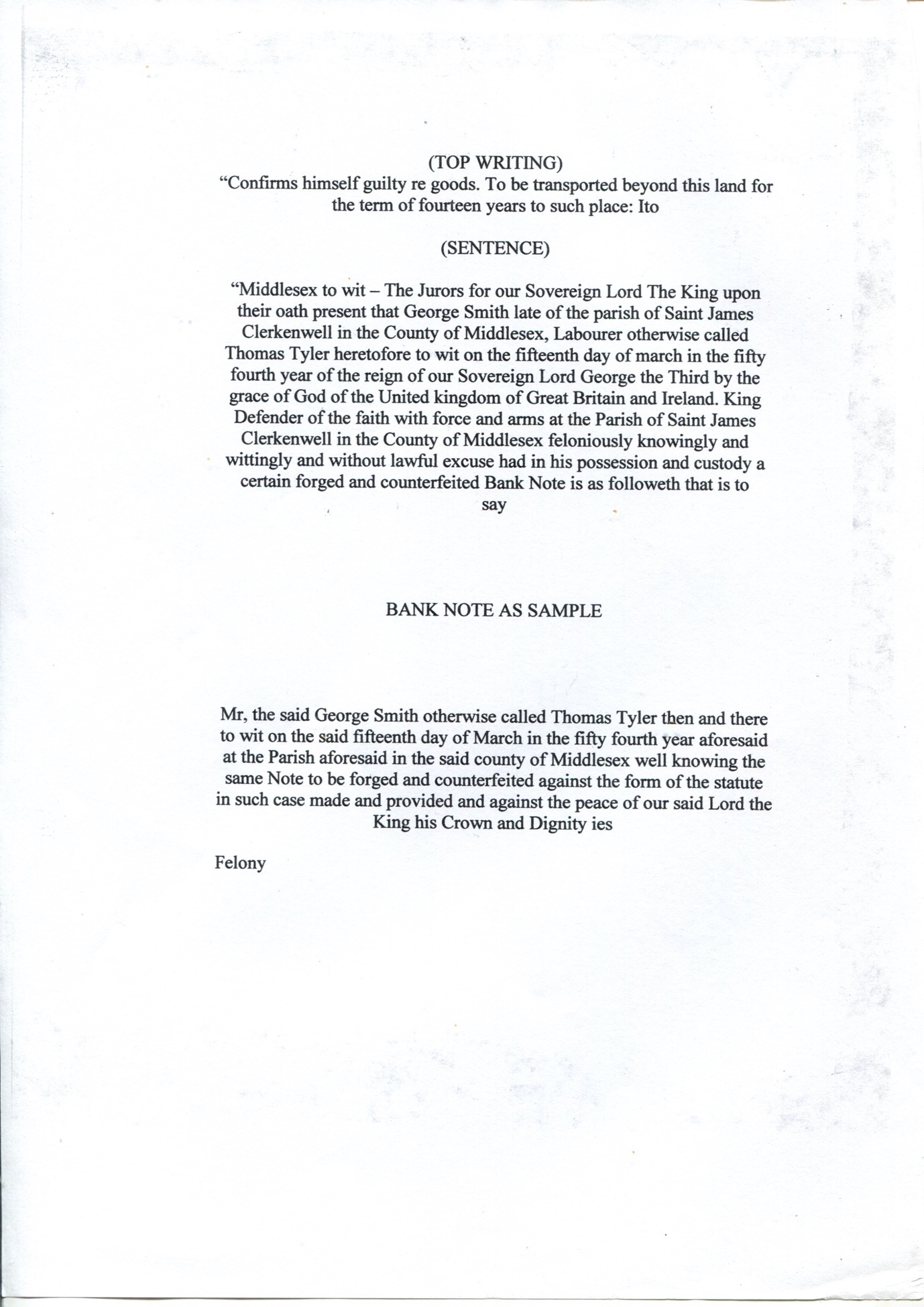
Transcription of Jury Findings at Middlesex Gaol, 11 January 1815, image courtesy of Potsy Quigley
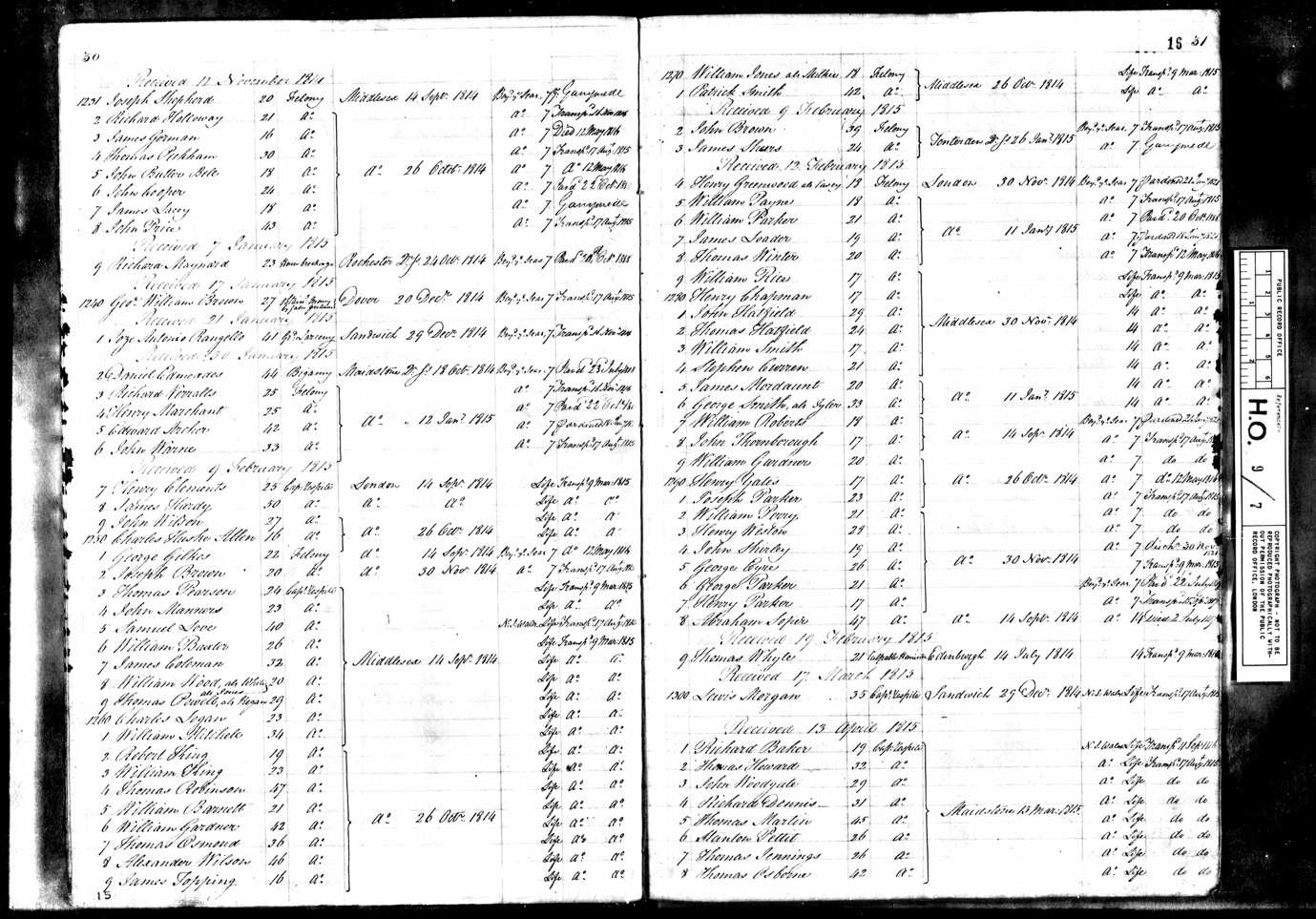
U.K. Prison Hulk Register and Letter Book 1802-1849 for George Smith aboard Retribution 1815
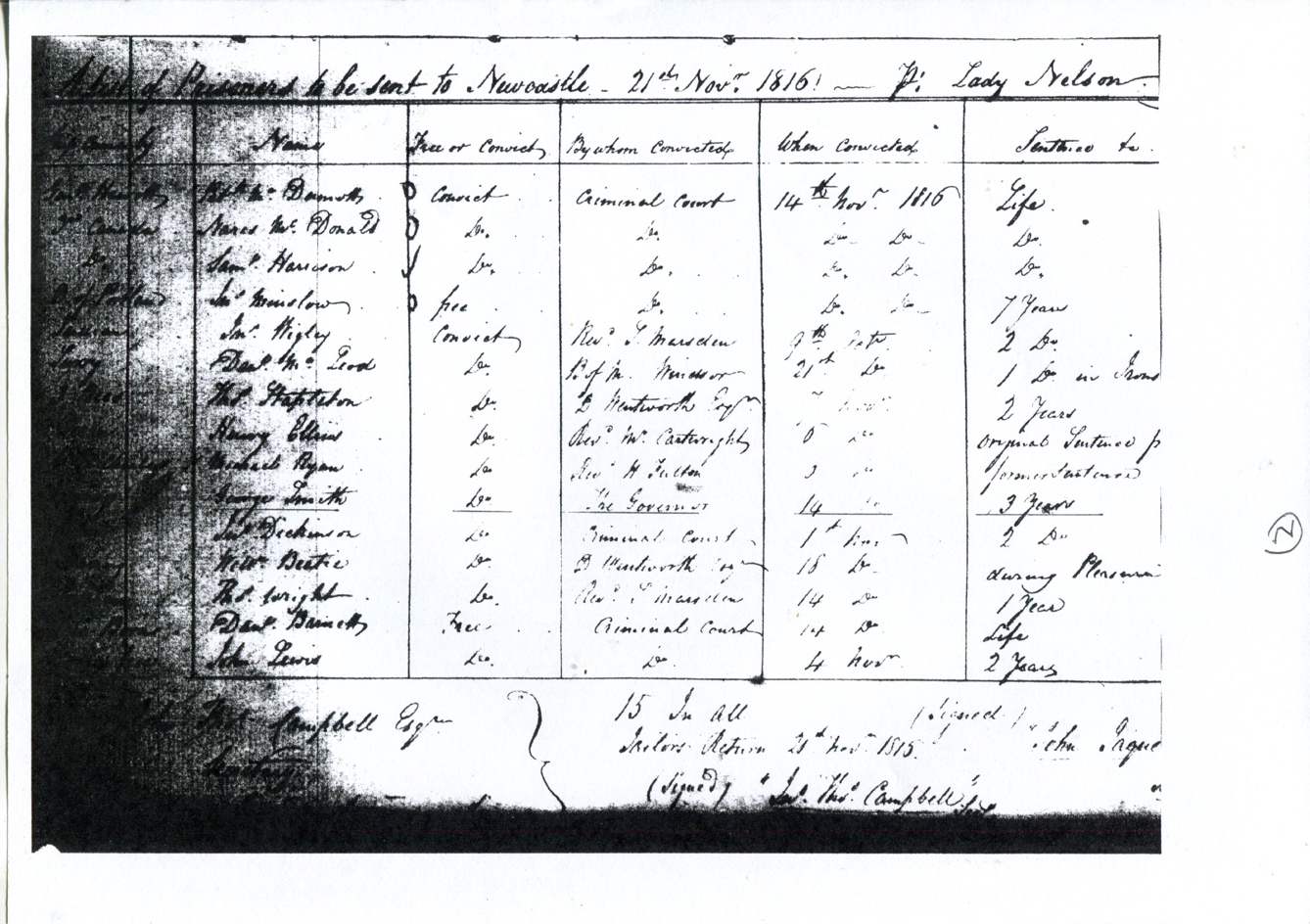
List of Prisoners sent to Newcastle aboard the Lady Nelson, 21 November 1816, per orders of Governor Macquarie, Colonial Secretary’s Office, 1788-1825, image courtesy of Potsy Quigley
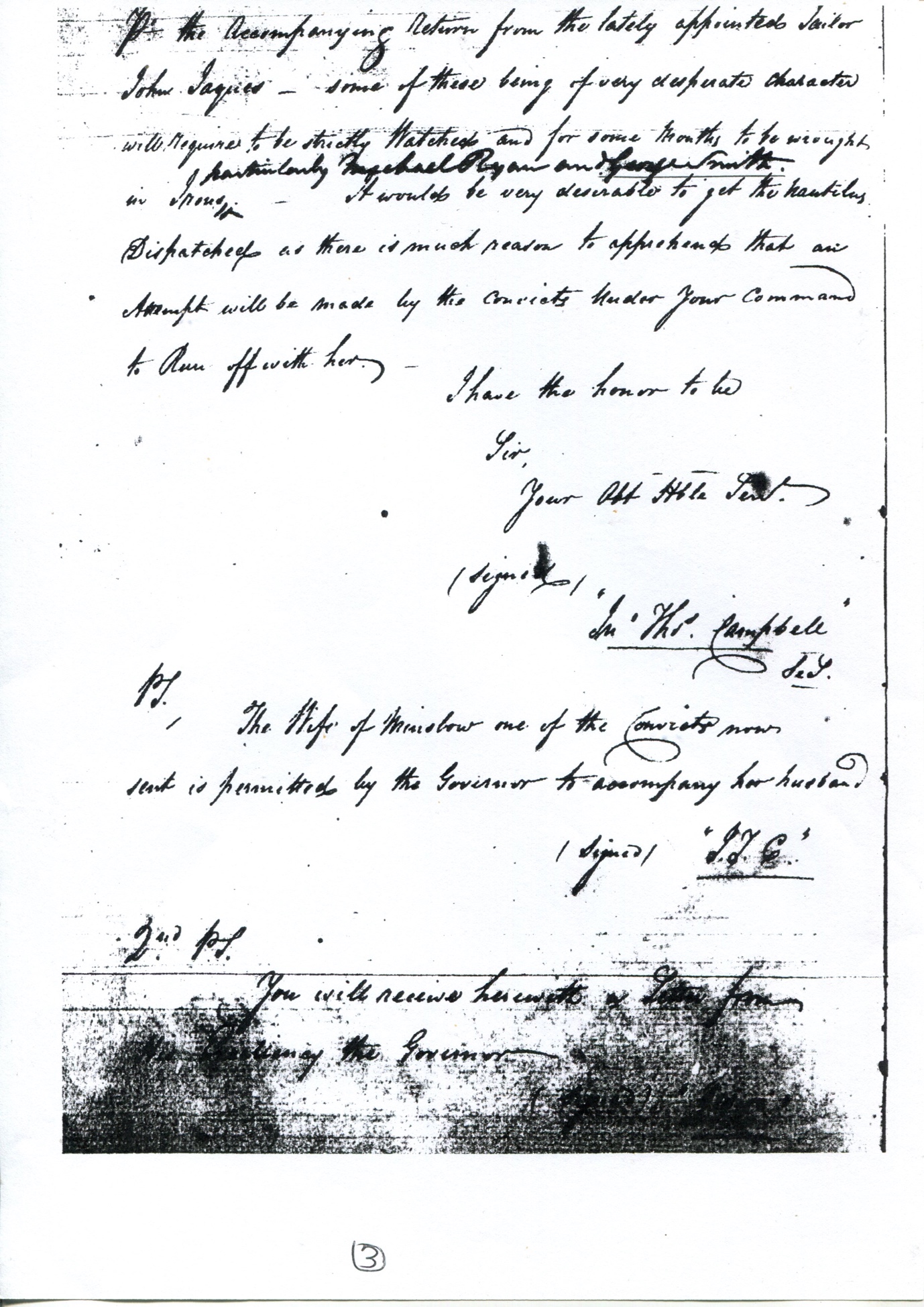
A list of prisoners, including George Smith, banished by Governor Macquarie to Newcastle, 1816, “these were convicts worth watching”, Colonial Secretary’s Papers, 1788-1825
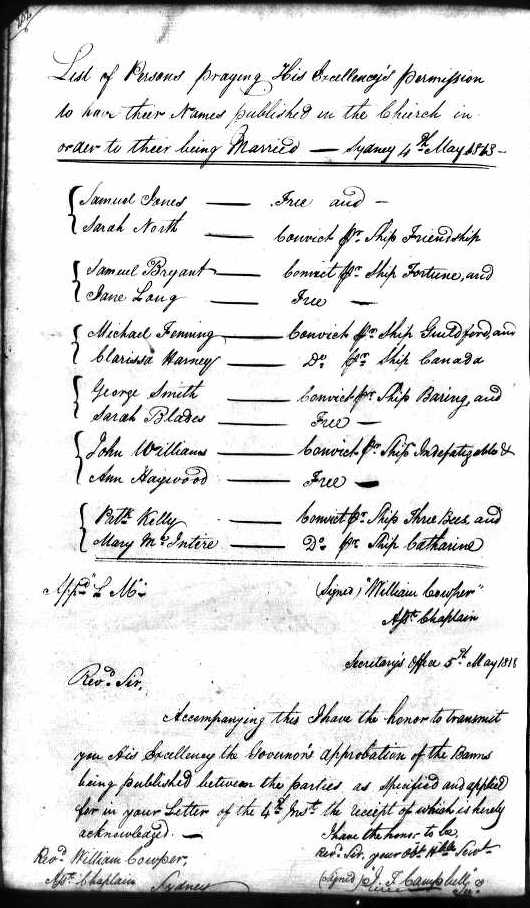
Permission for Sarah Blade and George Smith to Marry, 14 May 1818, Colonial Secretary’s Papers 1788-1825
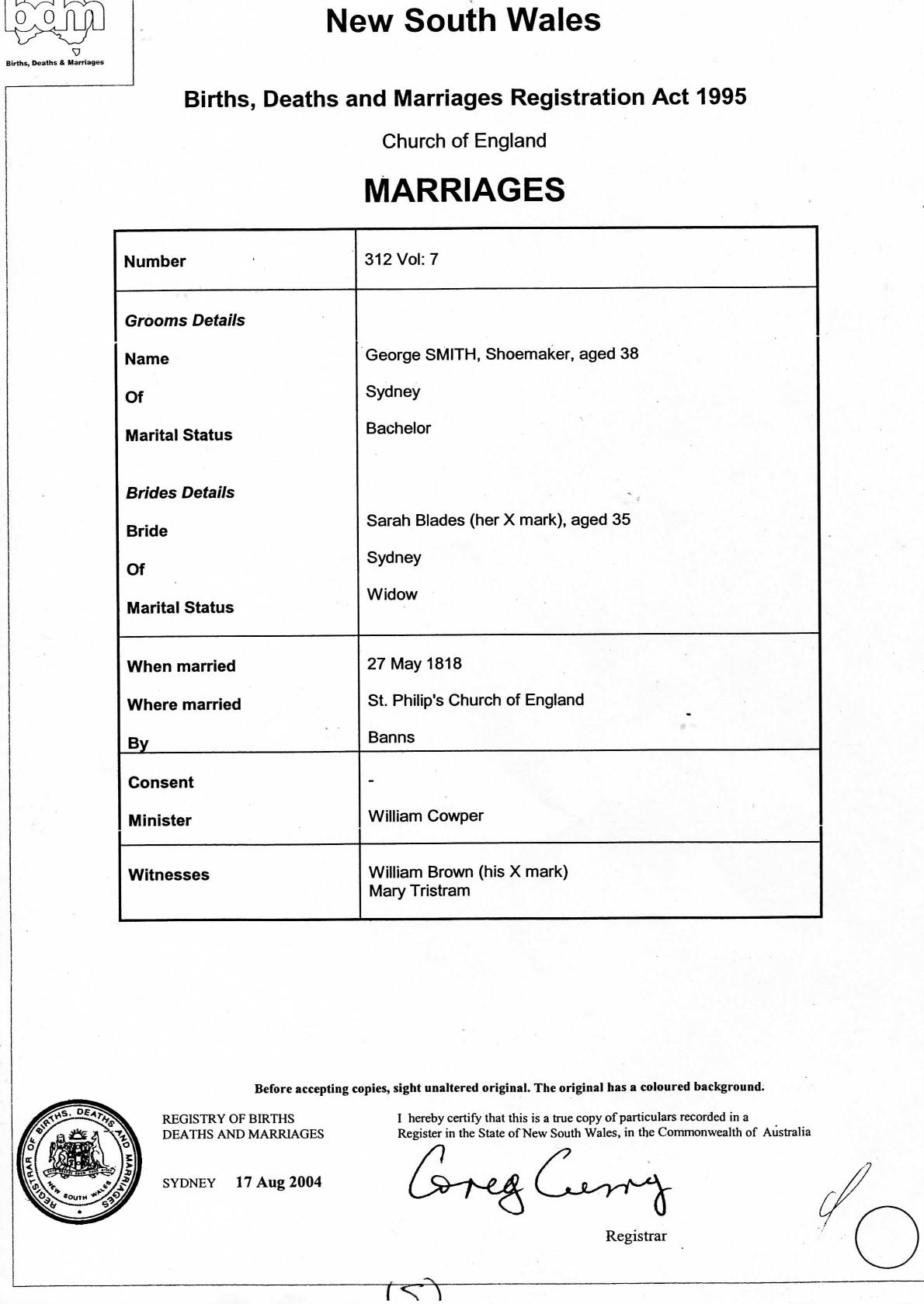
Marriage Certificate for George Smith and Sarah Blade, 27 May 1818, St Philip’s Church, Sydney, image courtesy of Potsy Quigley
George Smith (1783-1855) and Sarah Blade nee Kent (1782-1837) had three daughters, Jane Smith (1818-1868), Ann Smith (1821-1856) and Lily Shepherdess Smith (1824-1859).
Australia Birth Index, 1788-1922:
| Name | Jane Smith |
| Birth Date | 1818 |
| Birth Place | New South Wales |
| Registration Year | 1818 |
| Registration Place | Sydney, New South Wales, Australia |
| Father | George Smith |
| Mother | Sarah |
| Volume Number | V1818795 7 |
Both Jane and her sister Ann were listed in Commissioner Bigges Appendix of 1816-1821 as “daughters of Mrs Sarah Smith nee Blades”. Appendix lodged with State Library of NSW. Jane Smith was born in 1818 and her sisters Ann Smith was born on 3 March 1821 and Lily Shepherdess Smith was born on 3 February 1824.
Australia, Births and Baptisms, 1792-1981:
| Name | Ann Smith |
| Gender | Female |
| Baptism Age | 0 |
| Birth Date | 3 Mar 1821 |
| Baptism Date | 25 Mar 1821 |
| Baptism Place | St. Philip, Sydney, New South Wales, Australia |
| Residence Date | 1821 |
| Residence Place | New South Wales, Australia |
| Father | George Smith |
| Mother | Sarah |
| FHL Film Number | 993949 |
| Name | Lily Shepherdess Smith |
| Gender | Female |
| Baptism Age | 0 |
| Birth Date | 3 Feb 1824 |
| Baptism Date | 29 Feb 1824 |
| Baptism Place | St Philip Sydney New South Wales, Australia |
| Residence Date | 1824 |
| Residence Place | New South Wales, Australia |
| Father | George Smith |
| Mother | Sarah |
| FHL Film Number | 993949 |
Jane Smith married Charles Morris (1810-1875) in 1837 and they had four children, Sarah Morris (1838-), Charlies Morris (1839-1876), Henry D Morris (1841-1884) and Elizabeth Morris (1843-1880).
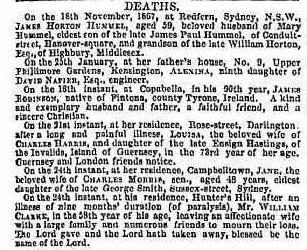
Death of Jane Morris, Sydney Morning Herald, 24 March 1868
Jane was described as daughter of the late George Smith of Sussex Street, Sydney.
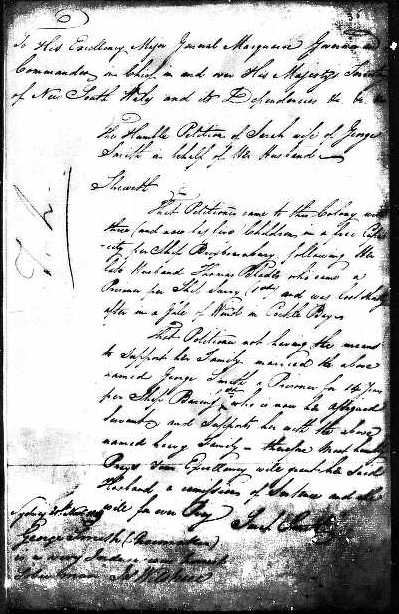
Plea letter written by Sarah Blade asking clemency for her husband George Smith 1820, Colonial Secretary’s Papers, 1788-1825
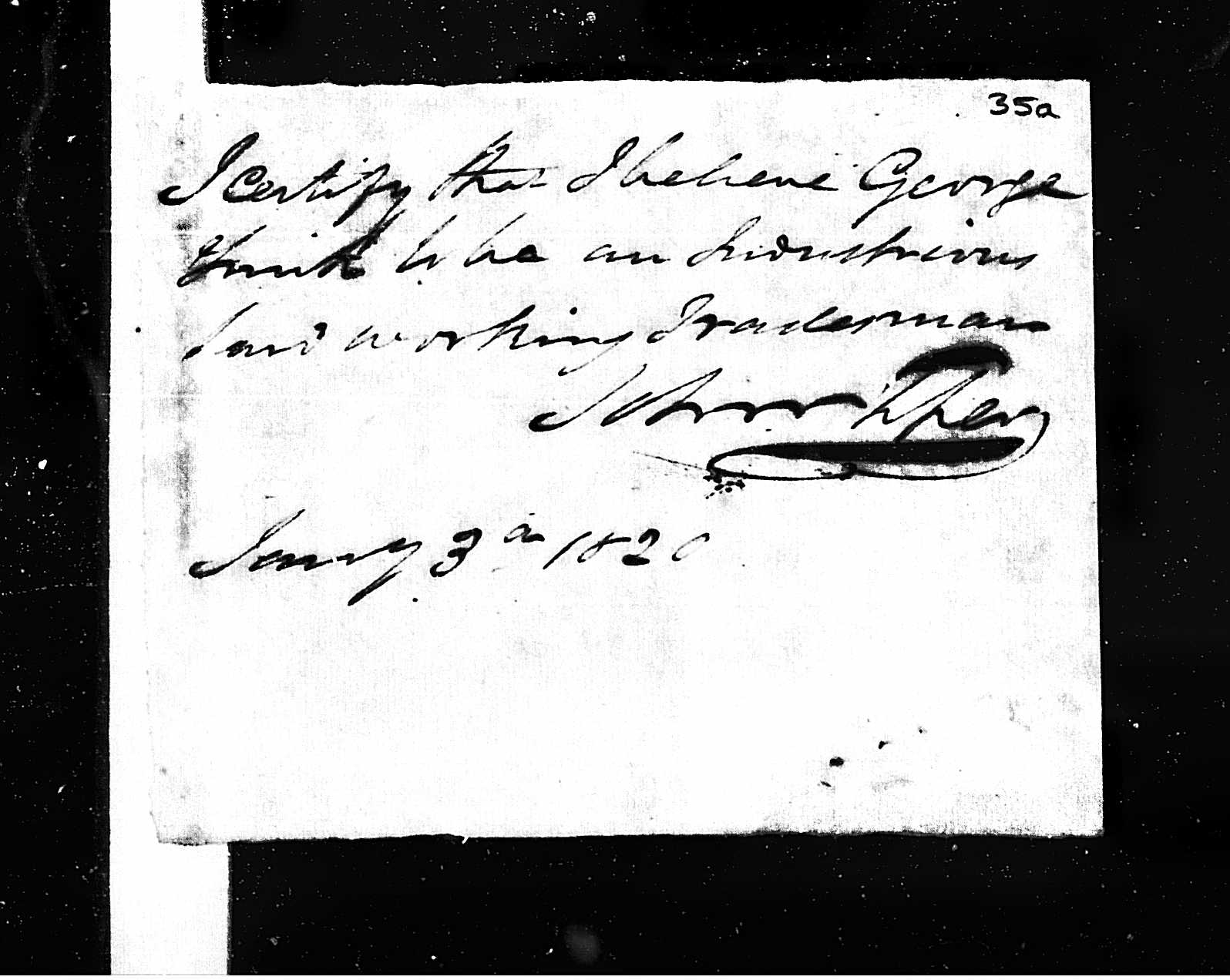
Attachment to Plea Letter for clemency for George Smith by his wife Sarah Smith 3 January 1820, stating that George Smith is in her employ as a tradesman, Colonial Secretary’s Papers 1788-1825
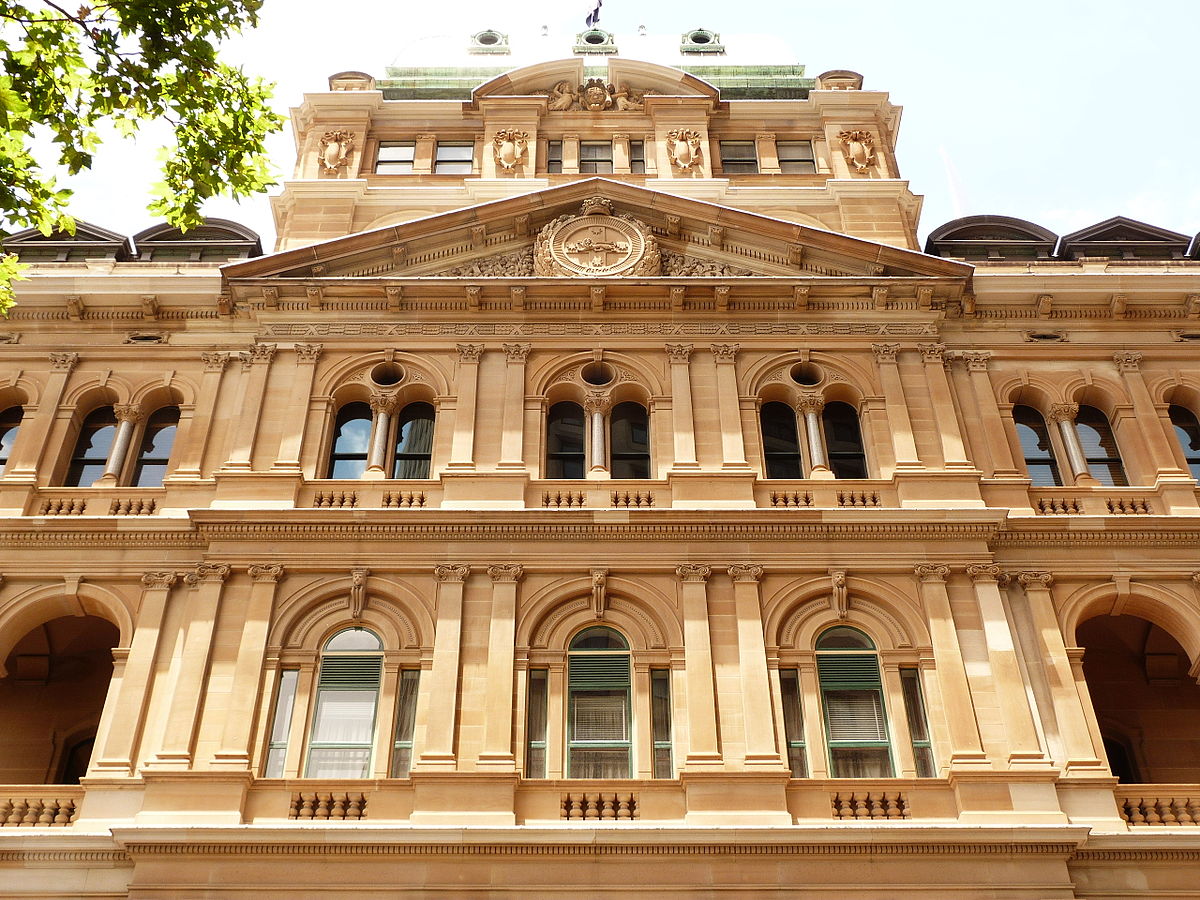
Colonial Secretary’s Building, Macquarie Street, Sydney
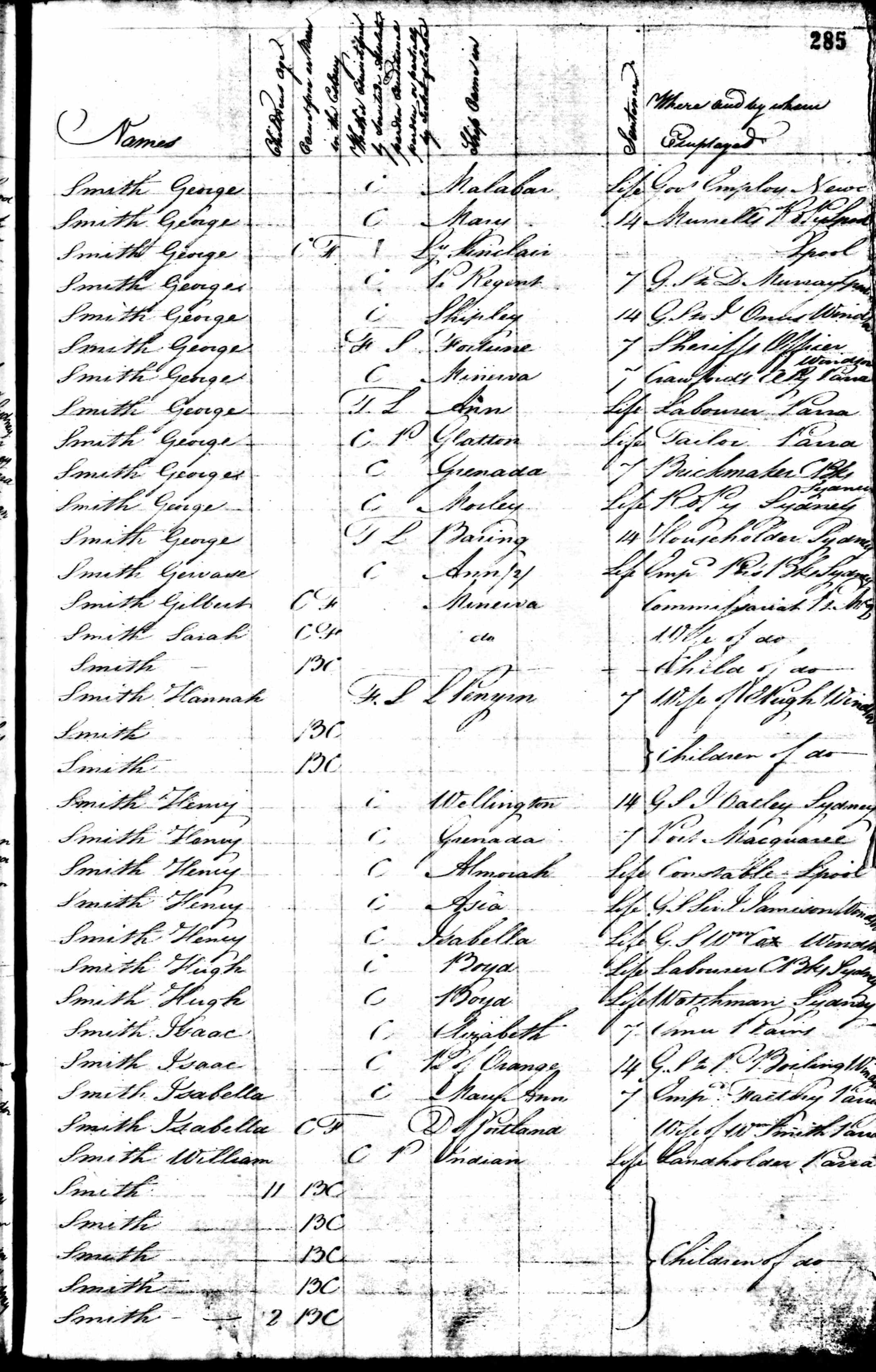
George Smith, Baring, New South Wales, Australian Convict Muster, 1822
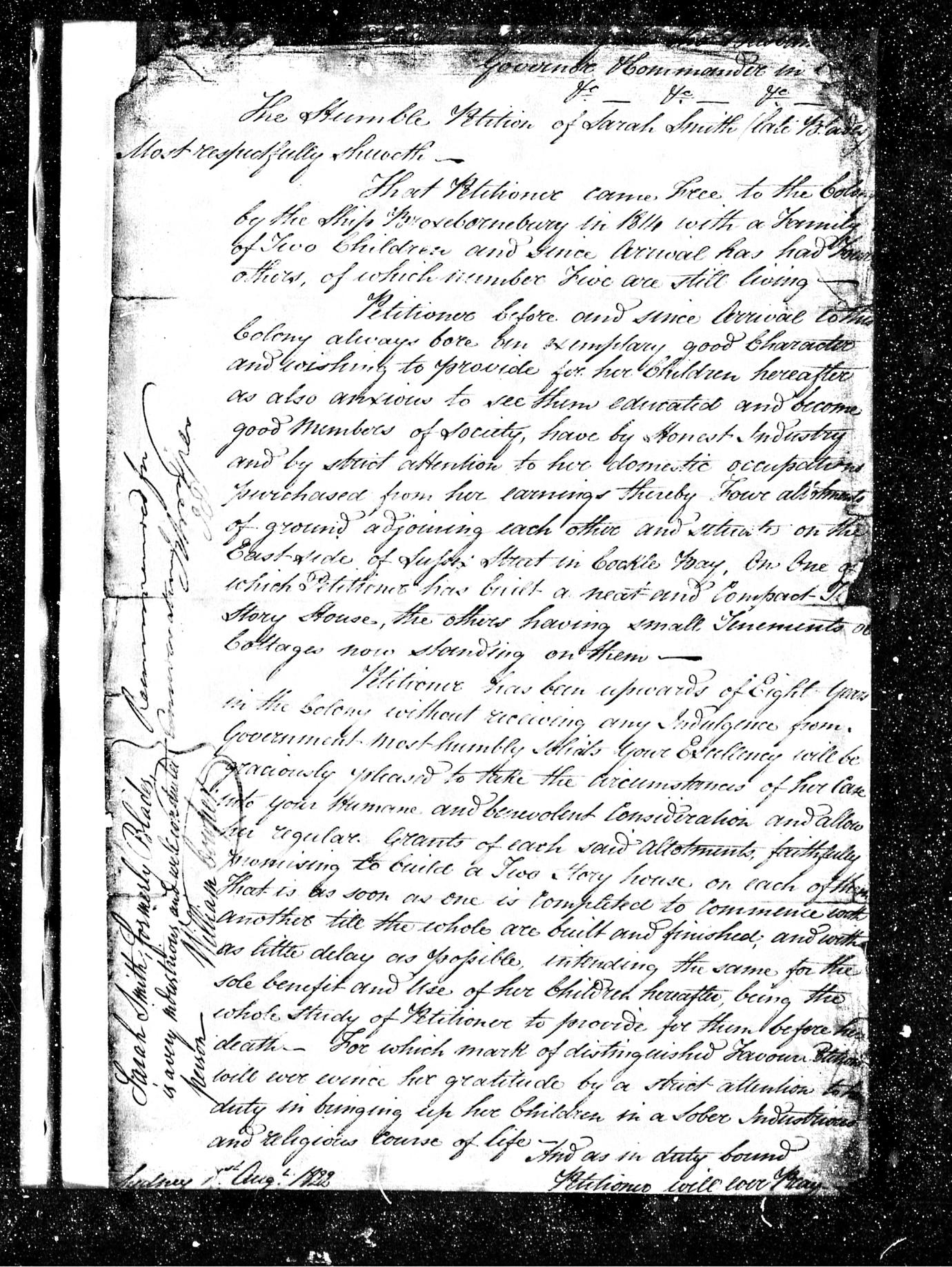
Memorials to the Governor, Colonial Secretary’s Papers 1788-1825, Plea letter of Sarah Smith formerly Blade explaining her predicament as a convict wife of George Smith with children to care for and asking for permission to build two story houses on her land grant of four allotments of land at Cockle Bay, 1 August 1822
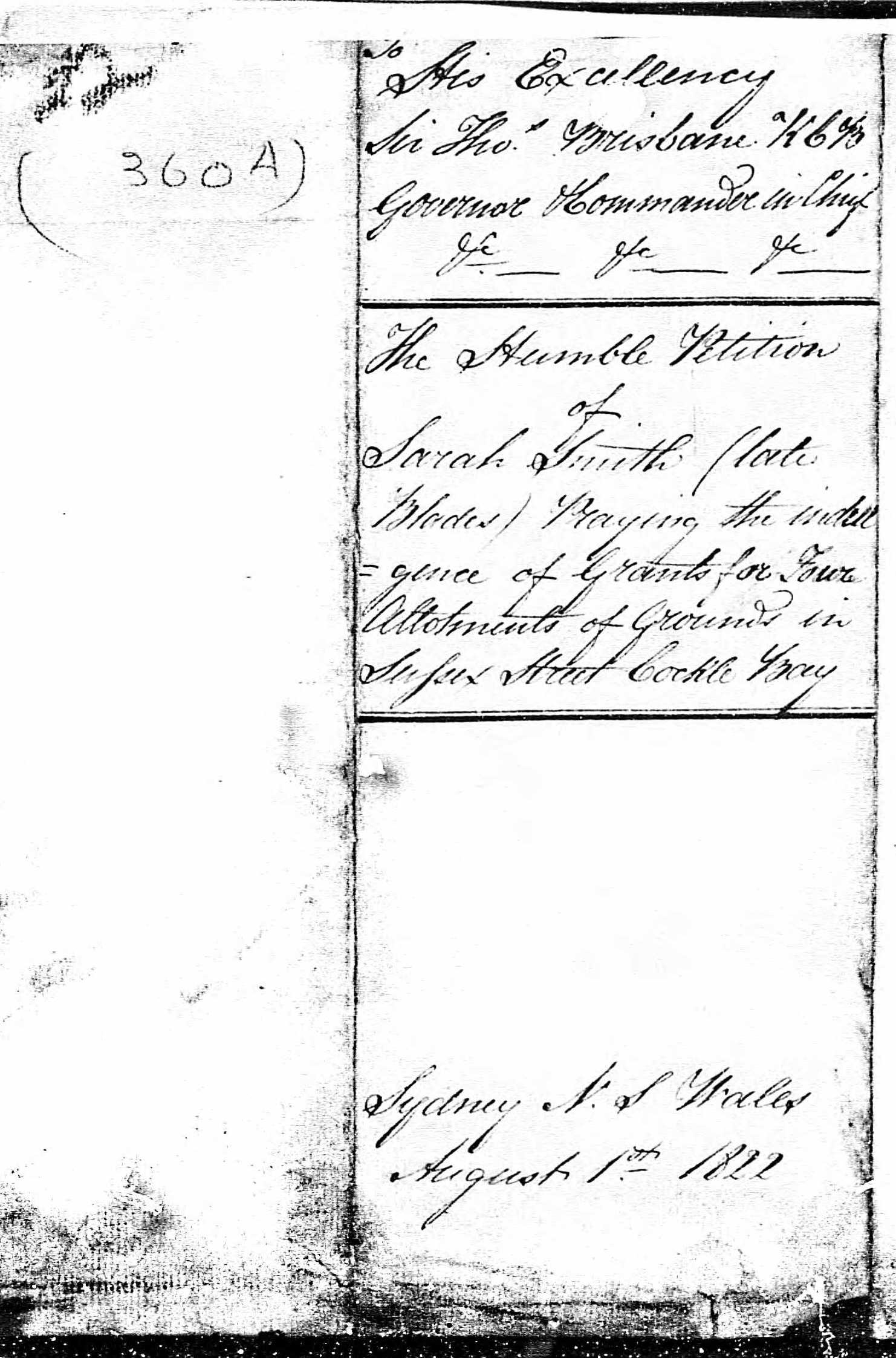
Cover letter to Plea Document 1 August 1822, Colonial Secretary’s Papers 1788-1825
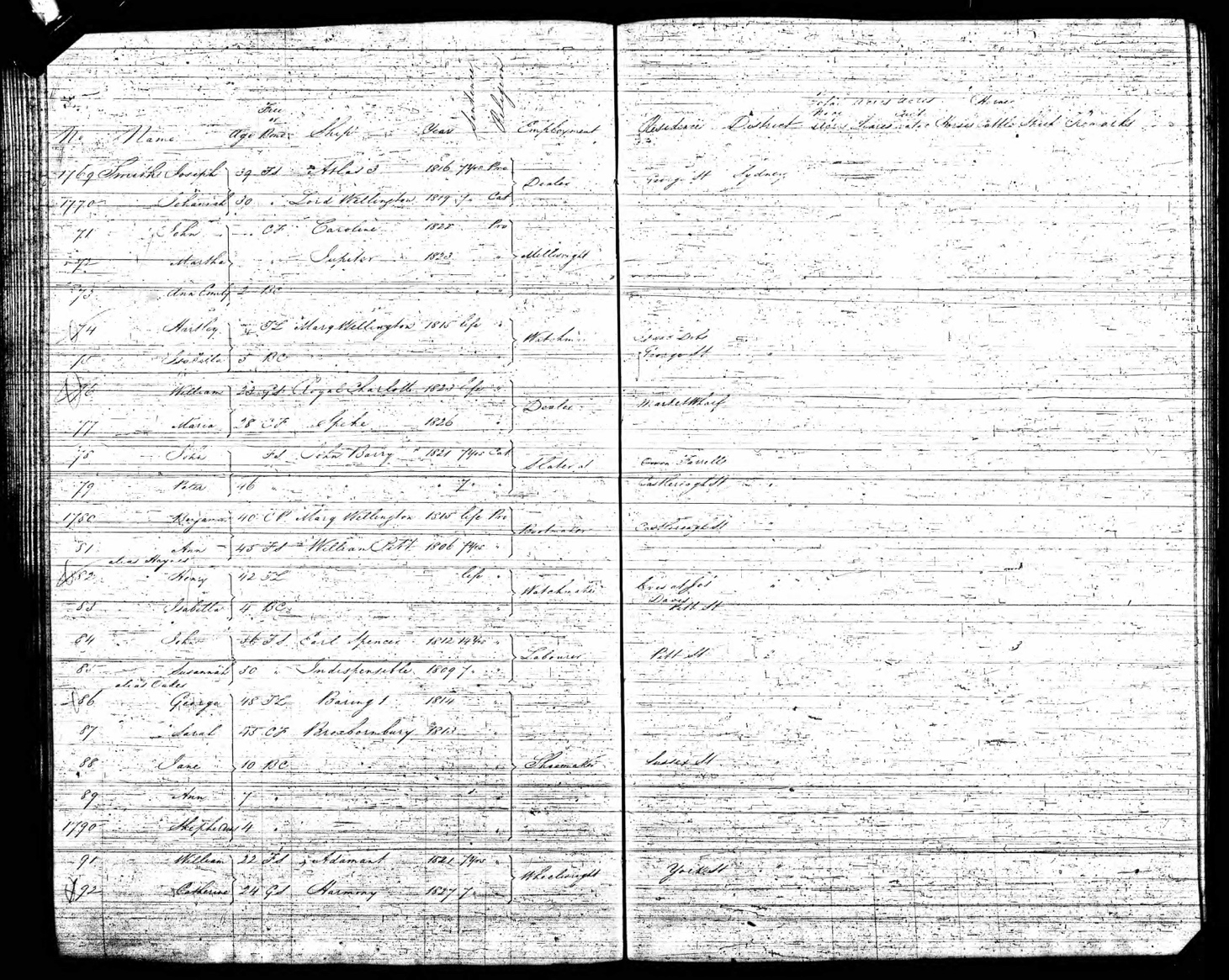
George Smith, Baring 1, Aged 48, 1828, New South Wales Australian Census, 1828
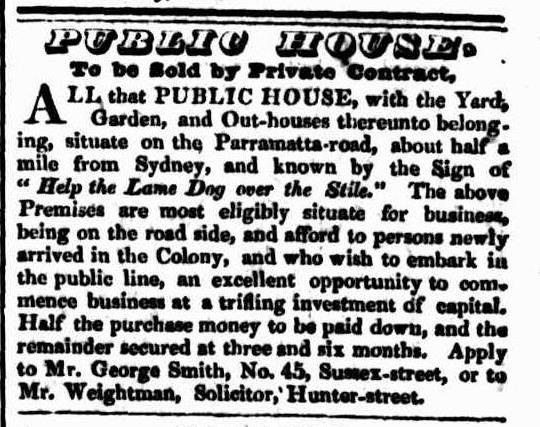
Public House, Sydney Herald, 31 January 1833
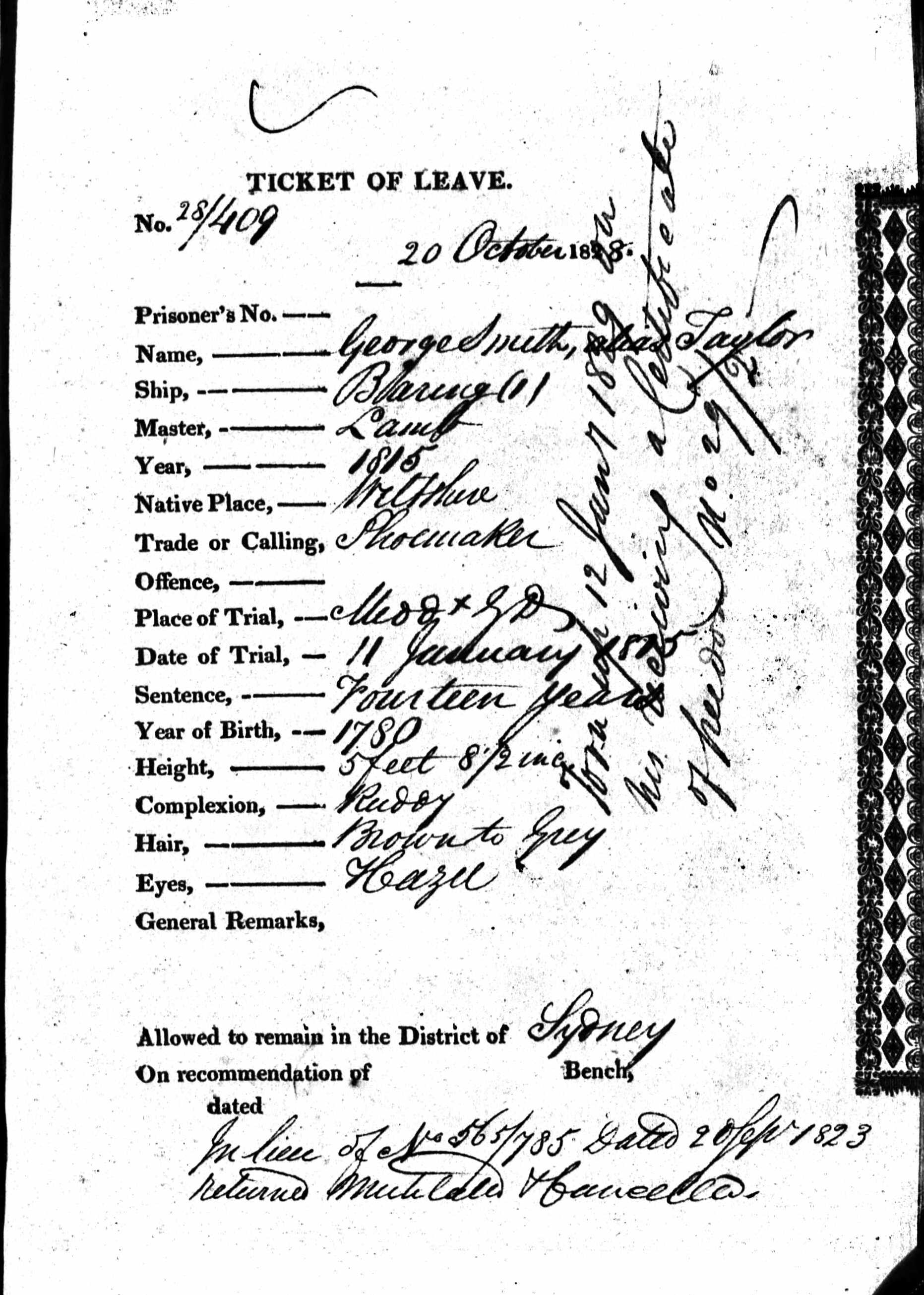
Ticket of Leave for George Smith, 12 Jan 1829, N.S.W. Ticket of Leave Butts, Aug 1828-May 1829
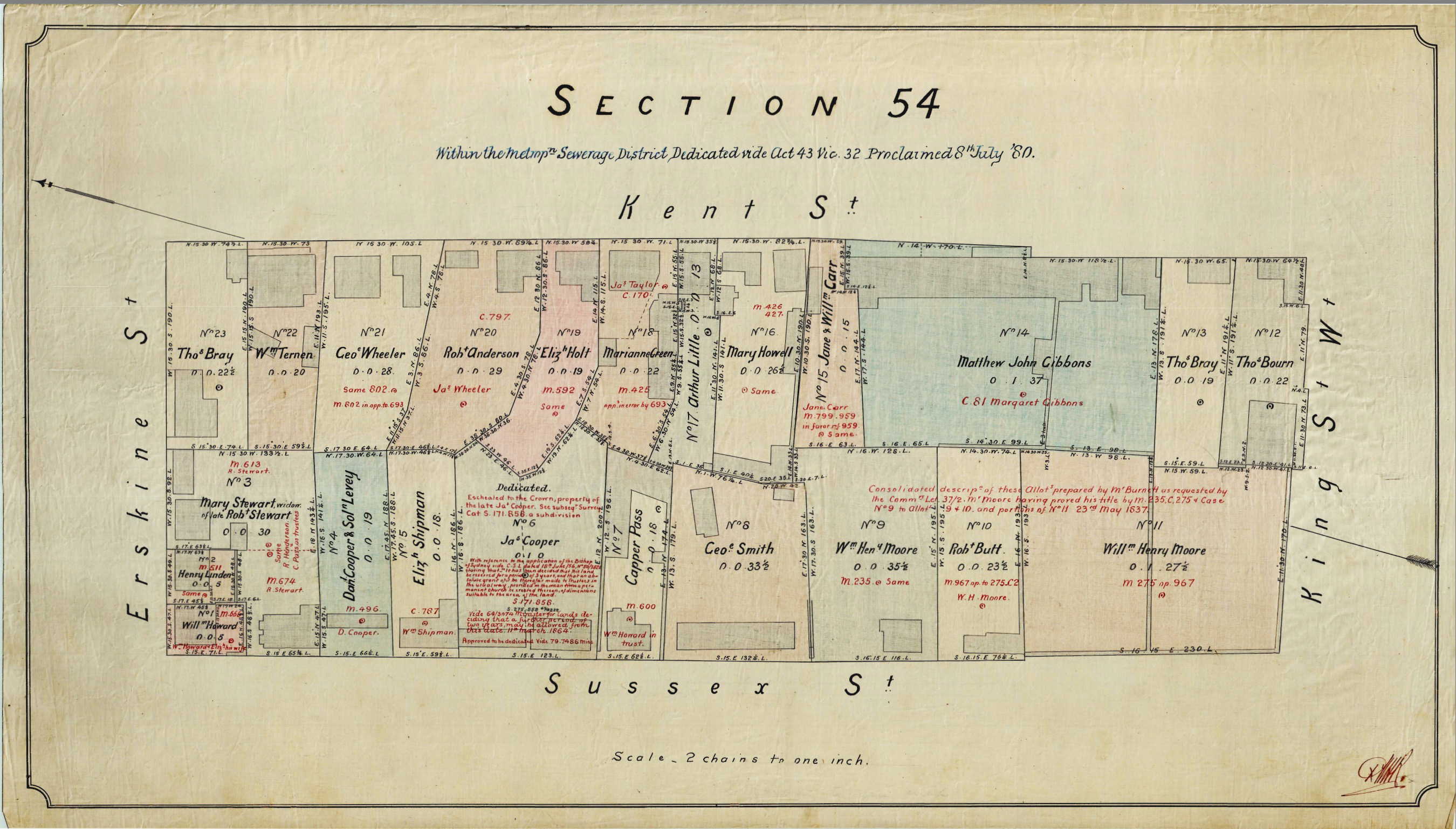
Section 54, Corner of Erskine and Sussex Streets, Sydney, the Stewart’s land is bottom LHS and George Smith’s property is further up Sussex Street, image courtesy of Nathgate 31 ancestry.com
It was not wonder then that Thomas Stewart, the son of Robert and Mary Stewart and Ann Smith, the daughter of George and Sarah Smith had met, romanced and married, as they were living in such close surroundings to each other. The Smiths would have thought the marriage was a very good match, and no doubt George Smith must have had the last laugh, knowing the irony of the fact that it was no so many years ago that he was under the careful watch of the soldiers of the Regiment.
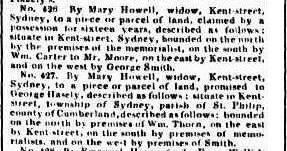
Application by Mary Howell, widow, Kent Street, Sydney Morning Herald, 2 June 1834
In effect Mary Howell is claiming squatter’s rights over the land “by the premises of the memorialist”, and I had studied the previously illustrated map and noted that Mary Howell’s property adjoined George Smith’s property in Sussex Street.

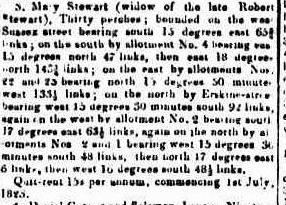
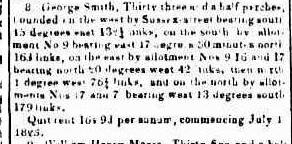
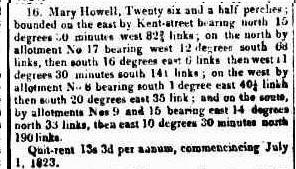
Col. Secretary’s Office Town Allotments – Howard, Stewart, Smith and Howell family 3 March 1835
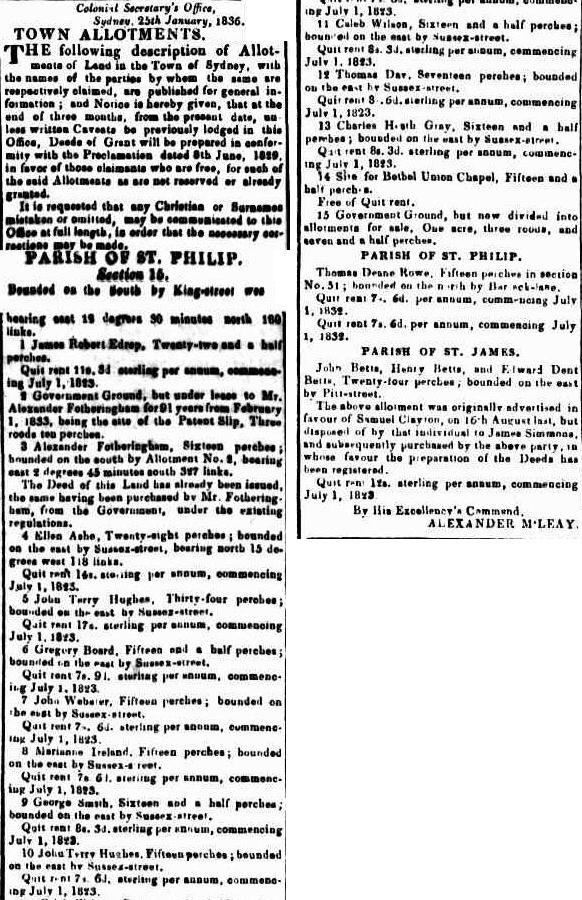
Town Allotments, Colonial Secretary’s Office, 25 Jan 1836, Sydney Gazette 2 Feb 1836
George Smith was granted sixteen and a half perches on Sussex Street and his step daughter Sarah Ann Ireland was granted fifteen perches. This land was previously George Smith’s land but he gave it to Sarah Ann via a memorial “for love and affection for my daughter”, probably after her marriage to John Ireland.
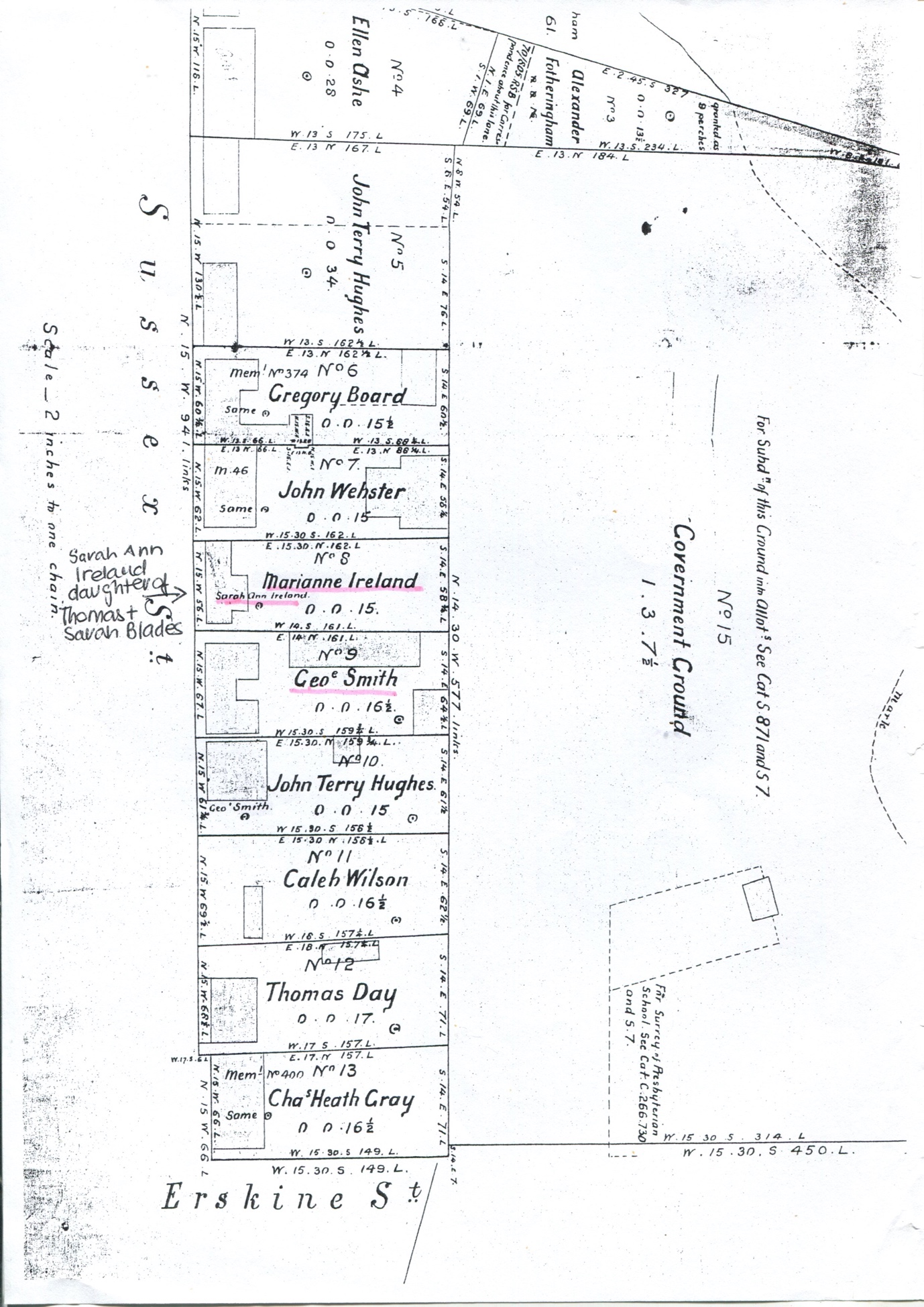
Survey of Government Grounds, Sydney, including Sussex and Erskine Streets, circa 1836, image courtesy of Potsy Quigley
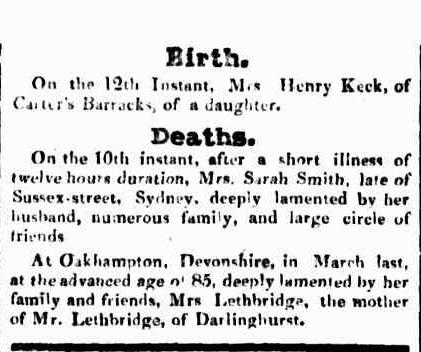
Death of Sarah Smith, Sydney Morning Herald, 13 July 1837
A wonderful collaboration developed with Bev Giveen, a descendant of Sarah Kent and Thomas Blades, who had first contacted me on ancestry.com and then later by email, providing me with many new documents and information that another Blade researcher Maureen Robinson had written a book, Two Ships, Two Hundred Years about Thomas Blade and his descendants. A week or so later in late May 2018 an envelope arrived in the mail from Bev with copies of her research matter, including documents showing that George and Sarah Smith had placed their daughters, Ann and Jane Smith and step-son Thomas Blades Jnr. into school when they were adolescents.
It came as a surprise to learn from Bev Giveen and Maureen Robinson that George Smith had married again after his wife Sarah’s death in 1837.
Ann Paul nee Redhead (1818-1874) was a widow with two small daughters, when she married George Smith in Sydney in 1847. Ann had arrived in Sydney with her husband, a carpenter, John Paul (1812-1844) and her daughter Amy Esther Paul (1838-1891), aboard the China in 1841 as assisted migrants. Another daughter Elizabeth Ann Paul (1844-1892) was born in the same year that her father died. It would have indeed been a marriage of convenience for Ann Paul, who would have needed protection at this very vulnerable time in her life.
George and Ann Smith had a son, George Henry Reuben Smith (1848-1895) and I can remember contemplating this birth record, hesitating to collect it because of the unusual name Reuben, however I finally accepted it, thinking the name Reuben might have been a surname from one of his ancestors.
Elizabeth Ann Paul married William Chantrill at Woollahra on 21 January 1875 and they had two children George William Bevan Chantrill (1876-) and Areta L. G. Chantrill (1880-). After Ann Grace Smith’s death in July 1874 Elizabeth Chantrill was named executrix of her estate.
Australia Marriage Index, 1788-1949
| Name | Ann Redhead |
|---|---|
| Spouse Name | George Smith |
| Marriage Date | 1847 |
| Marriage Place | New South Wales |
| Registration Place | Sydney New South Wales |
| Registration Year | 1847 |
| Volume Number | V B |
Australia, Births and Baptisms, 1792-1981
| Name: | George Henry Reuben Smith |
|---|---|
| Gender: | Male |
| Baptism Age: | 0 |
| Birth Date: | 27 Jul 1848 |
| Baptism Date: | 10 Sep 1848 |
| Baptism Place: | St.Lawrence, Sydney, New South Wales, Australia |
| Residence Date: | 1848 |
| Residence Place: | New South Wales, Australia |
| Father: | George Smith |
| Mother: | Ann |
| FHL Film Number: | 993935 |
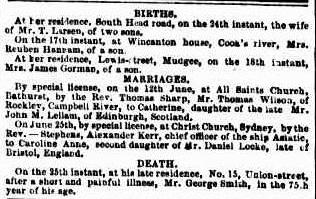
Death notice for Mr. George Smith, Sydney Morning Herald, 26 June 1855
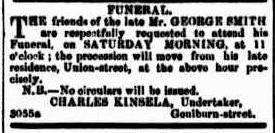
Funeral notice for Mr. George Smith, The Empire, 27 June 1855
Funeral of Mrs Ann Grace Smith 1 August 1874, Sydney Morning Herald
George Henry Reuben Smith married Emily Jane Beard at Woollahra on 21 January 1875, and they had six children, Nina G. J. Smith (1877-), Charles Reuben Smith (1879-1920), Arthur Wilfred Smith (1881-1945), Reginald Garnet Smith (1883-1945), Percival George Smith (1885-1947) and Florence Ellen May Smith (1889-1973).
Keen readers will have noticed that George and Emily Smith’s wedding was celebrated on the same day as his half sibling Elizabeth Paul married William Cantrell at the Ocean Street Congregational Church in Woollahra. It must have been a wonderfully happy wedding day for these two couples who shared a mother in Ann Grace Smith nee Redhead, and so terribly sad that Ann had died just six months earlier. It is a wonderful tribute to Ann and her husband George Smith of Sydney that her children erected a beautiful sandstone grave stone at Rookwood Cemetery in her memory.
Marriages of Chantrell-Paul and Smith- Beard (blurred document), 30 January 1875, Sydney Morning Herald
George and Emily Smith are buried at Rookwood Cemetery along with George’s mother Ann Grace Smith. In a separate grave, in another section of the cemetery are the graves of five of their children.
Headstone of George Henry Reuben Smith, Rookwood Cemetery, New South Wales, his wife Emily and his mother Ann Grace Smith nee Redhead, formerly Paul, is buried as “the wife of George Smith of Sydney”.
Probated will of Ann Grace Smith, New South Wales Government Gazette, 17 September 1877
Headstone for Arthur Wilfred Smith, Rookwood Cemetery, buried in a row of four matching graves along with brother Charles Reuben Smith and sister Nina Smith in another, and brothers Reginald G. Smith and Percival G. Smith in the third, one other grave is unmarked.
Headstone of Charles Reuben Smith, and also listed as buried in this grave is Nina Smith, presumably his sister.
Headstone for Reginald G. Smith and Pervical G. Smith, Rookwood Cemetery
I noticed a small glass jam jar, commonly used to place flowers had been left by this grave, possibly some day I will find the descendants of the grandsons of George and Ann Smith of Sydney.
Re-Interment Register for the Smith and Stewart Family from Devonshire Street to Rookwood Cemetery permitted by Charles R. Smith of Reubenleigh, Robinson Street, Croydon. Image kindly provided by Bev Giveen.
This wonderful document kindly provided by Bev Giveen gave information that the Smiths, George and Sarah, and their daughters Ann Stewart, and possibly Lily Shepherdess Smith had been resumed from Devonshire Cemetery and reinterred at Rookwood in 1901 when the cemetery was closed, razed and redeveloped as Central Railway, Sydney. This burial information is ongoing as I await Rookwood Cemetery to upgrade their digital online services and include reinterment registers. The move from the original and precious handwritten registers to transcribed entries is fraught with problems, not the least transcription errors with names, dates and plot numbers. For myself, nothing but the original handwritten documents can possibly provide correct information on the graves at Rookwood.
In March 2019, after the re-discovery of the headstone photograph of Robert and Ann Stewart on a grassy bank at Devonshire Cemetery, taken by Mrs Arthur George Foster, historian Mary Petroff explained to me that her husband Arthur George Foster had actually undertaken the very meticulous transcribing of several hundred headstones before the cemetery was razed to the ground to make way for Sydney’s Central Railway. His work and that of his wife is truly a remarkable and most amazing piece of genealogical research and today, nearly 120 years ago it is wonderful to be able to see clearly so much of the old cemetery and capture information about a long lost grave that hasn’t survived the passage of time.
In so many ways this situation actually relates to George and Sarah Smith’s grave at Devonshire Cemetery which, after several fruitless searches does not appear to be found at Rookwood Cemetery today. So it was, I was quietly going through Arthur George Foster’s headstone transcriptions page by page when to my absolute joy the page opened to reveal the Smith’s lost grave inscription from Devonshire Cemetery.
There is so much information on the page and most interesting of all is the fact that this was an altar tomb, which would have looked more like a raised lidded sarcophagus monument with the writing on the top. In fact I will return to Rookwood with this information to see if they have any information regarding the transferral to Rookwood of these types of monuments, because the very large nature of them would mean that they would have probably been grouped together in the cemetery. The transcription not only gives wonderful information regarding dates of death and ages, but there is also a wonderful tribute to the memory of Sarah Smith, aged 51, died 10 July 1837 by her husband George Smith. To crown this wonderful discovery, buried in this grave is also a grand-daughter of the Smith’s, Sarah Morris, aged 6, who died on 22 August 1844 the daughter of Charles and Jane Morris. Sarah Smith’s husband, George Smith, aged 75, who died 25 June 1855 and their daughter Ann Stewart, aged 35, who died 28 October 1856 are also buried in this same monument grave. Ann Stewart nee Smith was the first wife of Thomas Stewart Snr., the son of Robert and Mary Stewart.
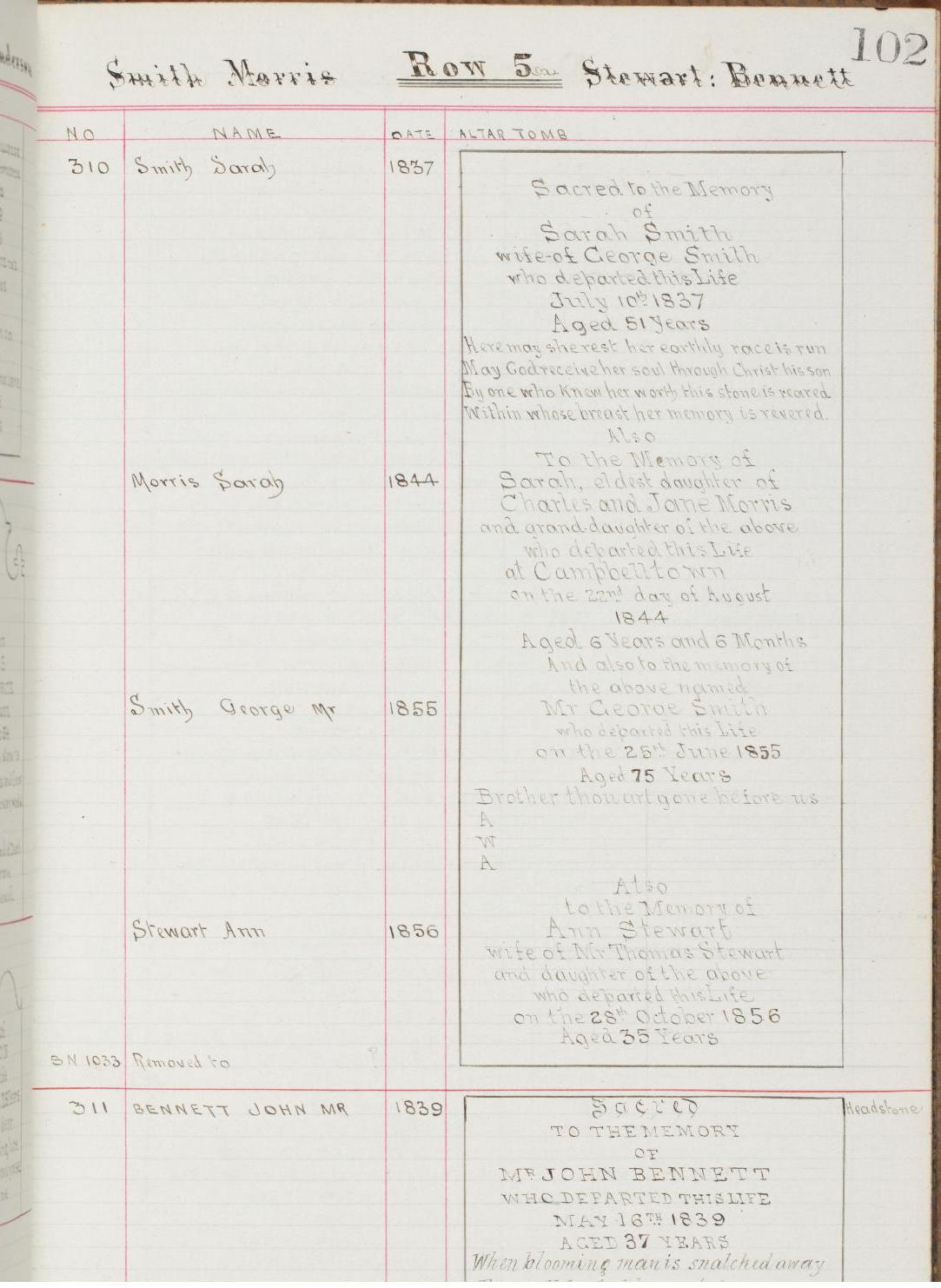
Transcription of the George Smith Family Altar Tomb from Devonshire Cemetery, Sydney, page 102, The Arthur George Foster Papers, 1901, lodged with the Mitchell Library, State Library of New South Wales
THE BLADE FAMILY
Thomas Blade was tried at the Old Bailey, Middlesex Assizes on 17 February 1813 for feloniously shoplifting three hams from an East Smithfield cheesemonger’s shop owned by Joseph Stiles. Along with Richard Robinson, his co-conspirator, he was sentenced to death for his crime and held at Newgate Prison and later aboard the prison hulk Retribution. His sentence was commuted to a life sentence on 10 June 1813 and he was later transported along with Richard Robinson aboard the Surrey, to the penal colony of New South Wales in 1814. I was lucky enough to find Thomas’ trial transcription, amongst the pages of the Old Bailey Trials, however there were very few personal details disclosed in his submission to the court, where Thomas Blade pleaded innocent to the charge. It has been said that Thomas Blade may indeed have been an innocent man, in the wrong place at the wrong time, sadly however his fate was transportation for life.
Proceedings of the Old Bailey, 17 February 1813, page 167, courtesy of Harvard University Microfilm page 28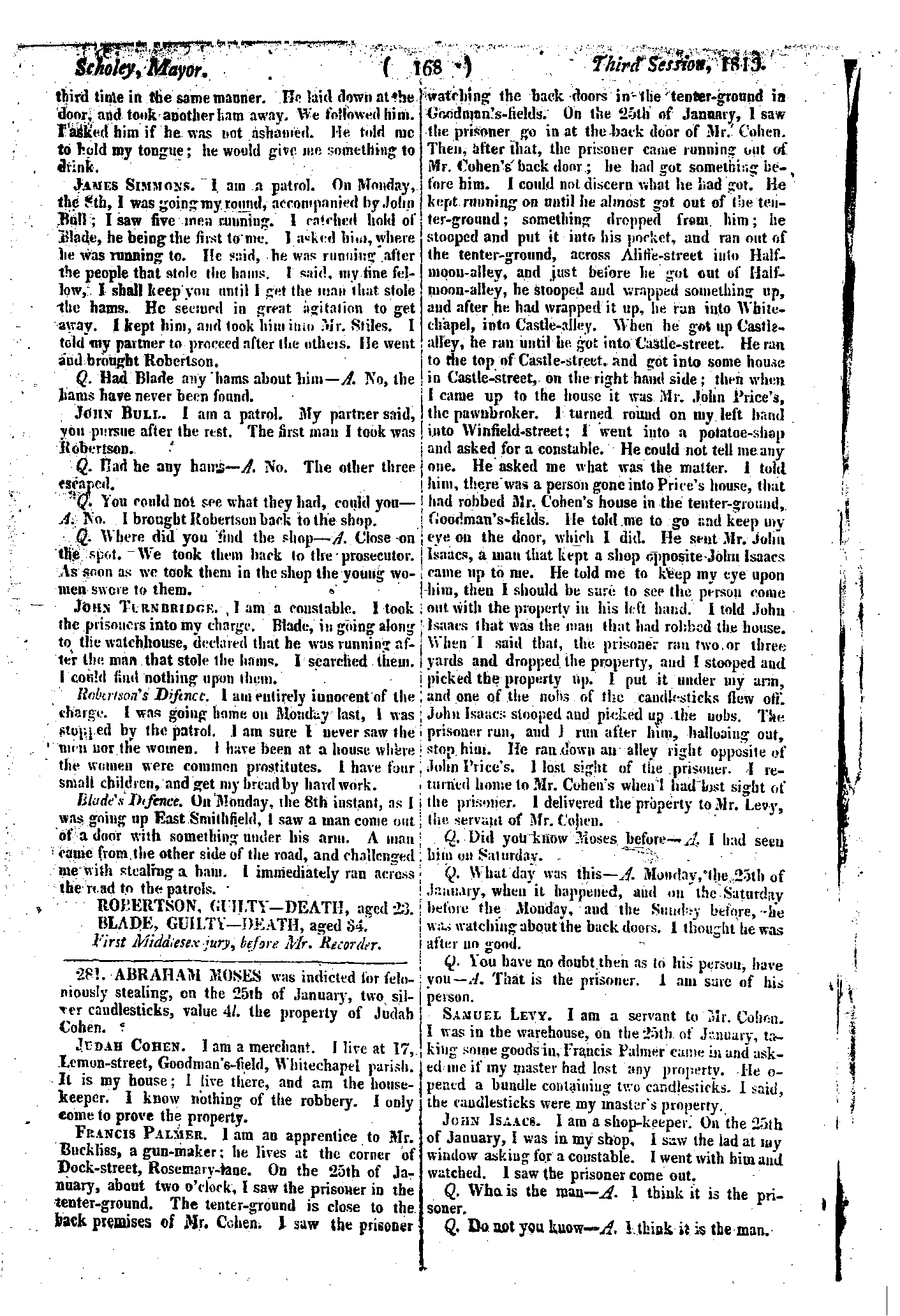
Proceedings of the Old Bailey, 17 February 1813, page 168, courtesy of Harvard University Microfilm page 29
Old English Newspaper clipping from the Old Bailey, 18 February 1813, courtesy of lkmitchell2 ancestry.com family tree
I was confident to collect Thomas Blade’s marriage record in London, in 1809 to Sarah Kent from the ancestry.com website. Thomas states he is a bachelor and Sarah, a spinster. Thomas and Sarah were married on 5 May 1809 at Christ Church, Southwark. I also had a conversation with Bev Giveen who has done a huge amount of work on Thomas Blade and his family. She has collaborated with other family researchers and they discovered that Thomas Blade, son of John and Jane Blade was baptised at Terrington St Clement, Norfolk, England on 23 December 1781. Bev also had information that Thomas had several siblings including a brother Robert Blade. It didn’t take me long to find Thomas Blade’s Baptism in the Bishop’s Transcripts for Terrington, St Clement, Norfolk, although the record was badly damaged, there are apparently other parish records books that are better preserves which confirm this baptism date and the name Blade.
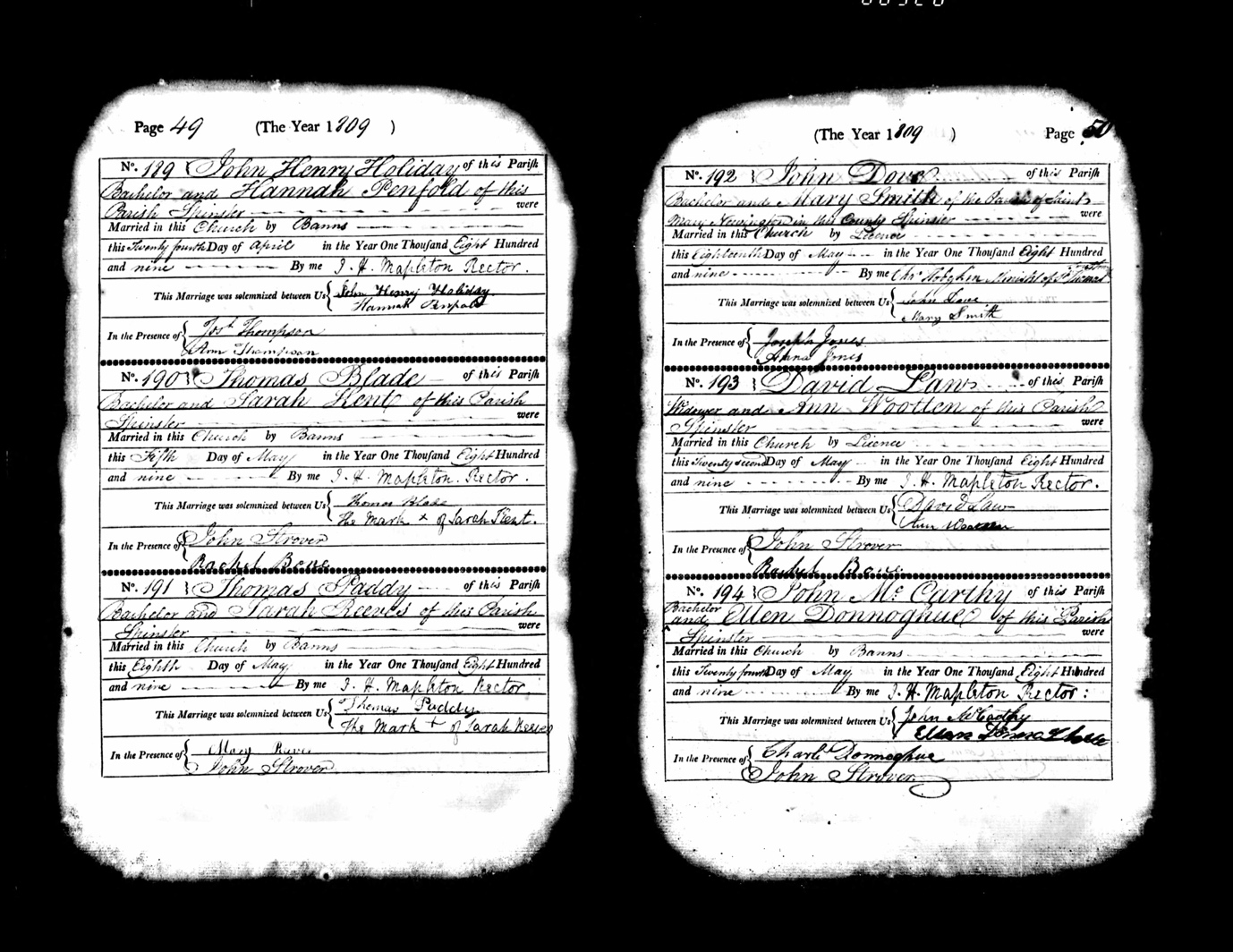
London, England Marriages and Banns 1754-1921, for Thomas Blade and Sarah Kent 5 May 1809, Christ Church, Southwalk, London
Baptism of Thomas Blade, son of John and Jane Blade, 23 December 1781, Bishop’s Transcripts, Terrington St Clement, Norfolk, England
Marriage of John Blade and Ann Arton, 7 October 1779, Bishop’s Transcripts, Terrington St Clement, Norfolk
John Blade and Ann Arton had nine children, Mary Blade (1780-1838), Thomas Blade (1781-1815), Arton Blade (1783-1827), Sarah Blade (1784-85), John Blade (1785-87), Jane Blade (1787-87), Robert Blade (1788-1829), Josias Blade (1790-1849), Jane Blade (1792-1822), all born in the parish of Terrington St Clement, Norfolk, England.
I was able to find the baptisms and marriages of most of the Blade family from Terrington St Clement from the Family Search website, which has been the most invaluable tool, whereby I can go to the actual Parish Records and Bishop’s Transcripts to find these original hand written records. Unfortunately not all English Counties are available, however, having researched my own Fuller family who originated from Norfolk, I knew that some Norfolk parish records were freely available.
While Thomas Blade awaited his transportation to New South Wales I found a document dated 13 September 1813, showing that he was sent to the Retribution at Woolwich, a ship prison hulk floating on the Thames. It must have been a desperate time for his wife Sarah and she was obviously a strong and capable woman who was able to handle this terrible predicament. The fact that she was able to make the decision to follow her husband to Sydney was an inspiration to others, I am sure, and she has my respect and admiration for her bravery. Sarah Blade nee Kent (1782-1837) also had a young daughter to care for, Sarah Ann Blade (1809-1856) as well as a step-daughter Caroline Blade (1801-1867) whose mother Elizabeth had died before 1809.
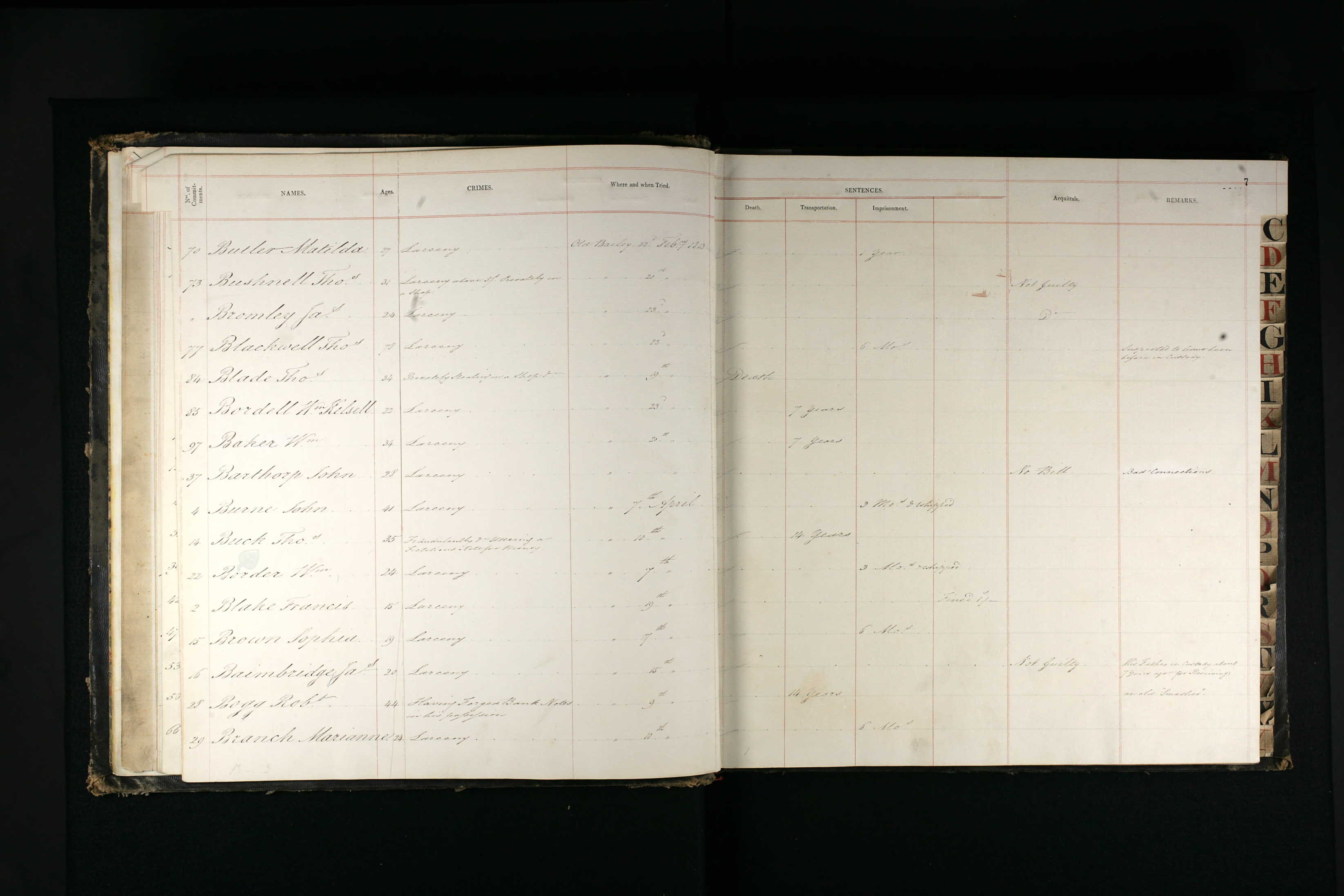
England and Wales, Criminal Registers, 1791-1892, for Thos. Blade, Middlesex prison, 19 Feb 1813
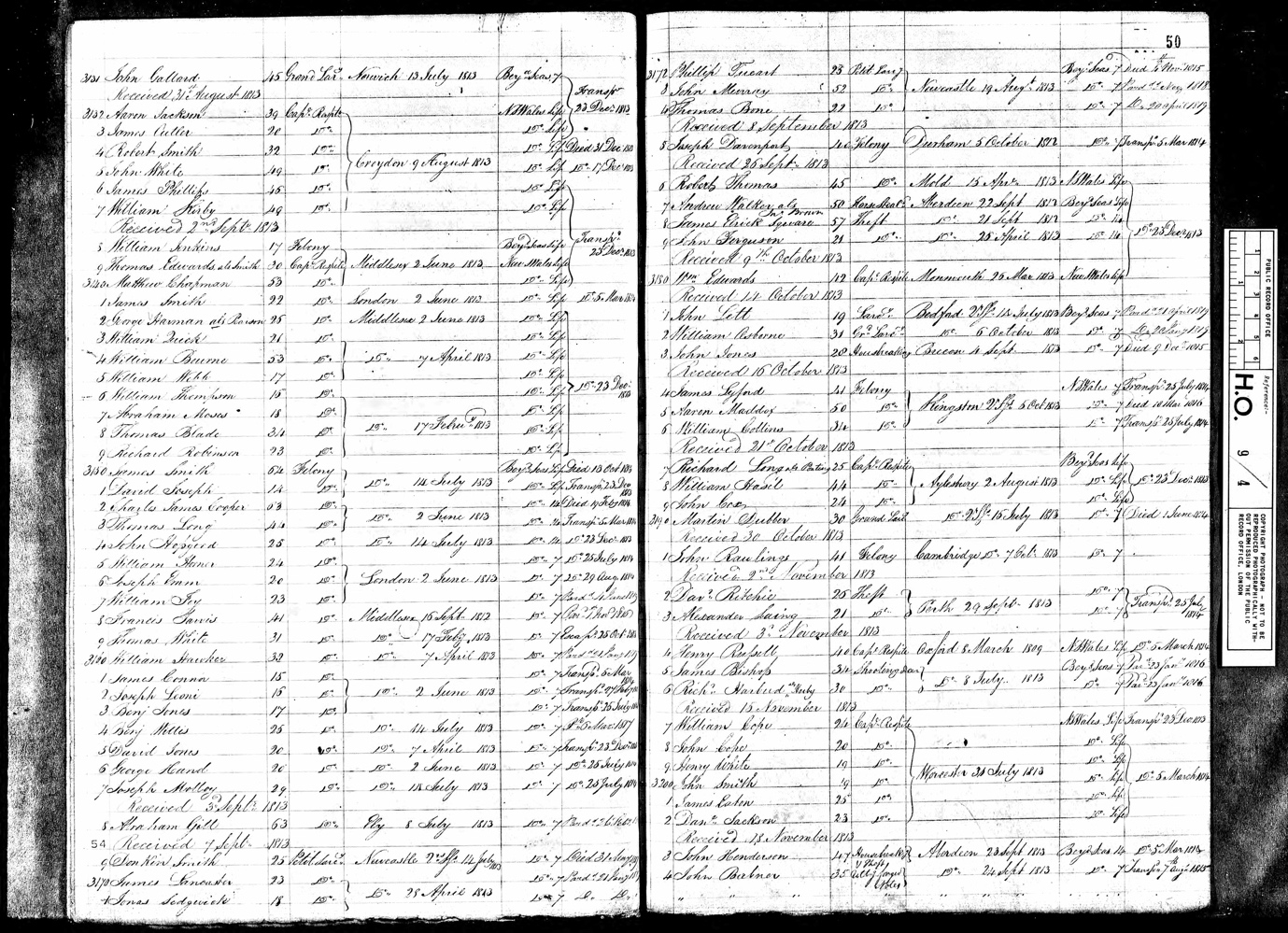
UK, Prison Hulk Registers and Letter Books, 1802-1849, for Thomas Blade, 2 September 1813 aboard the Retribution
New South Wales Convict Indent for Thomas Blade, 28 July 1814, aboard the Surrey
In January 1814 Thomas Blade departs England aboard the Surrey, for transportation to Sydney, New South Wales as “a lifer”. According to some Blade family historians, Thomas Blade was an artist. However, the convict indent for his arrival in Sydney on 28 July 1814, aboard the Surrey lists him as a 35 year old Excise man, a native of Lynn, (possibly King’s Lynn), 5 ft 4 ins tall, of pale complexion, light brown hair and hazel eyes. Upon arrival in Sydney on 28 July 1814, Thomas was immediately assigned to his wife Sarah Blade. I also collected a Convict Census for him in that same year, 1814, however, it gives very little information except that he is residing in Sydney.
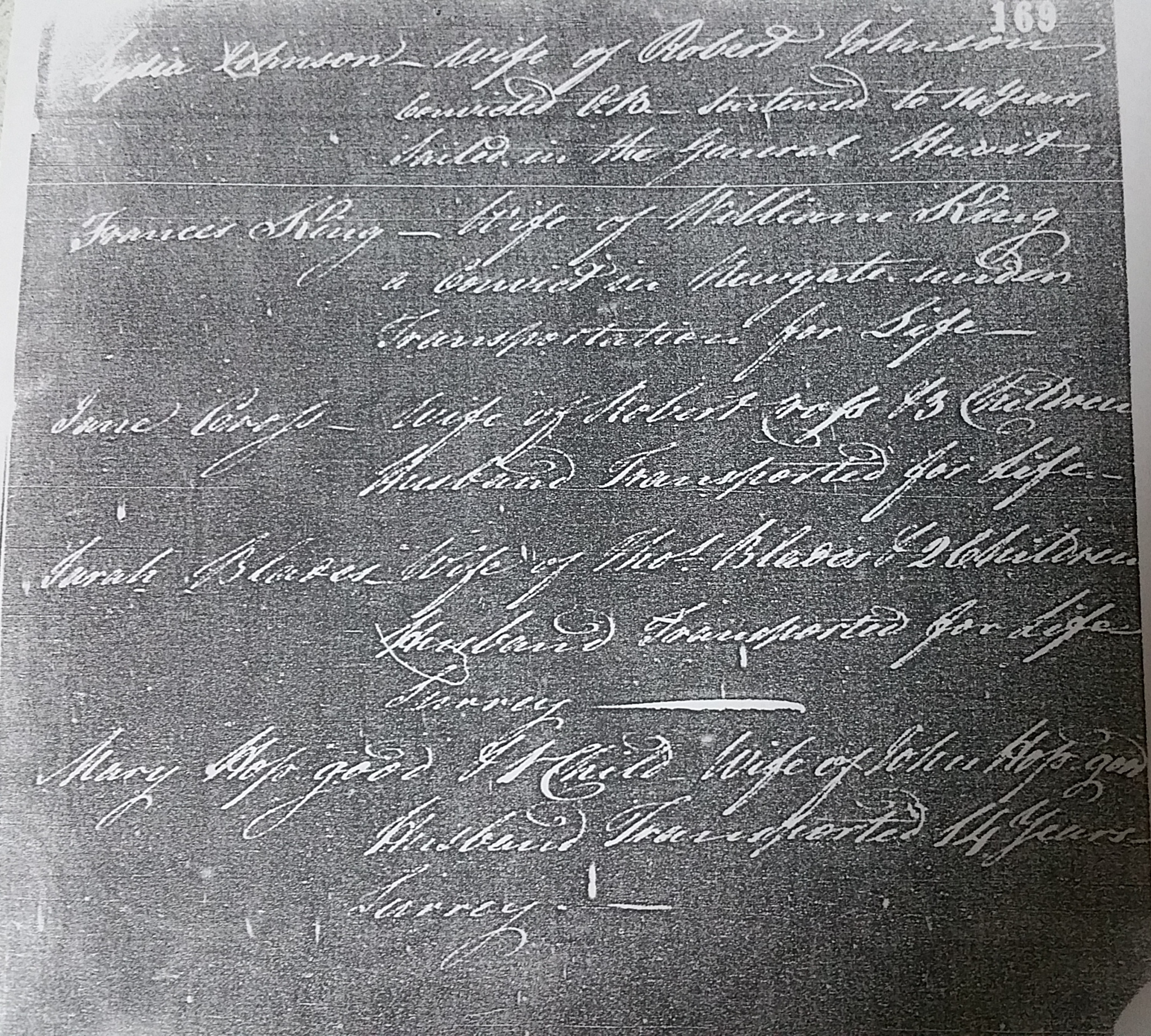 “Sarah Blade, wife of Thomas Blade and two children, husband transported for life Surrey”, as listed on the Broxbournebury, in this British Government Letter, allowing these women to travel free with their children and allowing them to be assigned their husbands Off Store upon arrival at Sydney Cove. Off Store meant that the families would have to fend for themselves.
“Sarah Blade, wife of Thomas Blade and two children, husband transported for life Surrey”, as listed on the Broxbournebury, in this British Government Letter, allowing these women to travel free with their children and allowing them to be assigned their husbands Off Store upon arrival at Sydney Cove. Off Store meant that the families would have to fend for themselves.
This image was kindly supplied by Bev Giveen, a descendant of Thomas Blade. This document comes from an English transport document which listed the wives of convicts who were listed on the Broxbornebury, a ship which accompanied the Surrey to the Colony of New South Wales. It is interesting to see that other wives travelled to Australia with their families in the hope of a reunion with their husbands and fathers. Francis Greenway’s wife and children were also aboard the Broxbornebury.
Bev Giveen also explained that a wonderful book has been written by another Blade descendant, Maureen Robinson back in 2014 to coincide with a family reunion celebrating two hundred years since Thomas Blade and Sarah Kent arrived in Sydney aboard the Surrey and the Broxbornebury in 1814. Maureen’s book Two Ships, Two Hundred Years ago is an excellent account of the Blade family and also includes Thomas Blade’s origins in Norfolk. Maureen gives wonderful social and historic facts to tie the Blade family so nicely into their English and Australian families.

The Surrey is Quarantined, Sydney Gazette, 30 July 1814
This historic notice is the first time a ship from England, which arrived with Typhoid fever was quarantined in Sydney Harbour. Quarantine Station, the beautiful and still relatively untouched area of Sydney, nearest to North Head and Manly, became such an iconic, feared and frightening place of association for many ships who disclosed diseased passengers. However, it was pointed out by Blade family researcher, Bev Giveen, that this was not the area where those souls from the Surrey were impounded. Apparently, in the very early days of the colony a quarantine station was set up directly north of Sydney Cove, near Jeffrey Street, Kirribilli, in an area now nearby to the northern pylon of The Sydney Harbour Bridge where a cemetery existed for the victims of the Surrey.
1840 map (cropped), the original coming from The Robert Campbell Estate, courtesy of the Australian National Library, showing the Quarantine Area, near Jeffrey Street, Kirribilli, for those victims of the Surrey.
The Surrey had 200 male convicts aboard, marine guards, and crew, and early in the journey, it was separated from its sister ship the Broxbornebury, just after calling in at Rio de Janeiro. Typhus fever was recorded early in the voyage and became so virulent that 51 convicts died, and the toll included the Captain of the ship, the First and Second Mate, the boatswain, six seamen, four soldiers and worst of all, the ship’s surgeon. The Broxbornebury was carrying many women convicts, and also included a large contingent of “free on board” women, the wives and children of convicts transported aboard other ships. Sarah Blade and her two daughters were on board and Sarah was hoping that upon arrival she would have her husband Thomas Blade “assigned” to her, as a servant, as was the custom for many women in her predicament.
The Surrey was ‘adrift’ off Shoalhaven, New South Wales in late July 1814, when the Broxbornebury re-joined her. Without anyone to navigate the Surrey, the captain of the Broxbounebury transferred a “volunteer” to board the fever ridden ship and navigate it into Port Jackson. Once inside Sydney Heads on 27 July 1814, a voyage of 156 days, the ship was quarantined on the northern shore of the harbour and the many remaining sick were treated in tents erected as a temporary hospital.
In contrast, only 2 female passengers on the Broxbornebury died in transit. The stories of the female convicts from the Broxbornebury are many and varied and well recorded in many sources, one book in particular, The Women of Botany Bay by Portia Robinson covers this voyage very well.
Sarah arrived in Sydney on board the Broxbornebury with two daughters, Caroline and Sarah Ann and they would have had to fend for themselves until Thomas Blades was released from quarantine. Governor Macquarie insisted that the survivors of the Surrey stay isolated for at least six weeks.
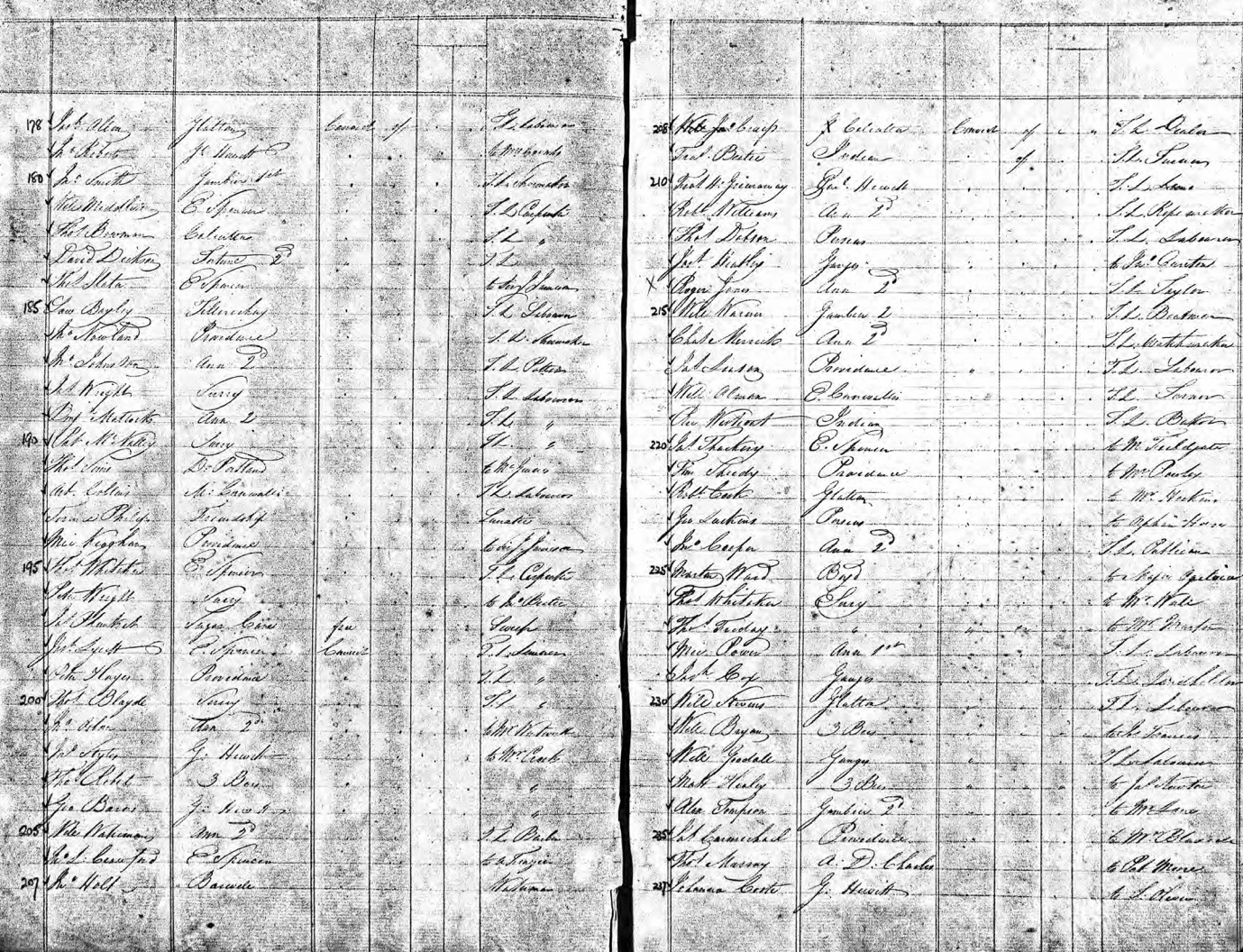
New South Wales, Population Census, for Sarah Blade and two children, Sydney, 1814
Thomas Blade (1774-1815) was born in King’s Lynn in Norfolk, England. Thomas and his first wife Elizabeth had a daughter Caroline Blade (1801-1867). Thomas Blade married Sarah Kent in 1809 and they had two children, Sarah Ann Blade (1809-1856) and Thomas Blade (1815-).
Other researchers claim the Blade had several more children, I have not established this yet, as I have not found firm documents to support these claims. I am happy to correct my chapter if further evidence comes to light.
I have been able to pick up the family shortly after their arrival from the 1814 Census, recorded on two separate sheets, the children are indicated by a “2” on the list beside Sarah Blade entry.
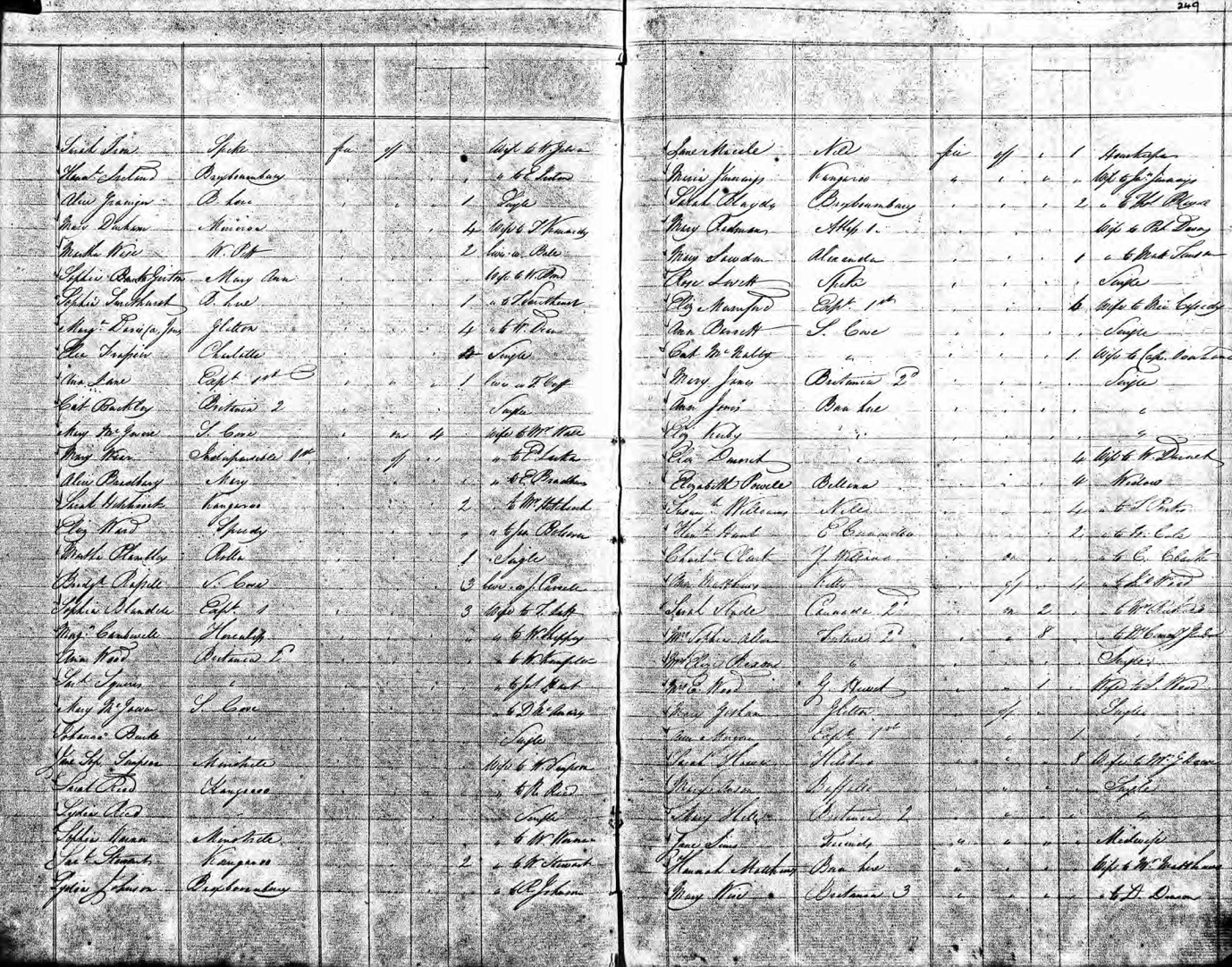
NSW Population Census for Thomas Blade, Sydney, 1814
By early 1815 the Blade family had settled in Sussex Street, Cockle Bay, on the western shore of Sydney town, an area we now call Darling Harbour. Thomas and Sarah Blade had become involved in trading goods up and down the Parramatta River during the week-days, with the purchase of a small sailing boat, and on week-ends they hired it out as a pleasure craft for recreational use. Presumably Thomas had resumed his career as an Excise man and was also over-seeing the trading of goods at the Cockle Bay Wharves.
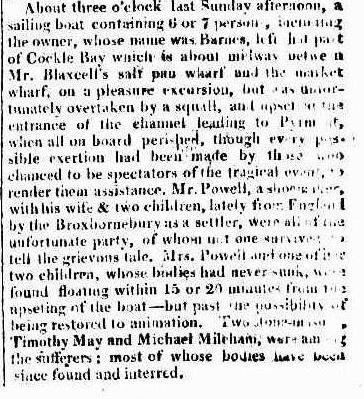
Pleasure craft overtaken by a squall, Sydney Gazette, 28 January 1815
The Sydney Gazette article was so tragic to read, and it gave so much information about the day’s outing on the harbour. The small sailing boat, making its way to Birch Grove had only reached the entrance to the channel leading to Pyrmont when a squall overturned the boat tossing them all into the harbour and all perished. Some who witnessed the event made a desperate attempt to save some of the victims, and it would seem some of them drowned under the sheer weight of their own clothing. It would also seem that the newspaper article made some errors in its report, naming Thomas Blades as “Barnes” and the Powell family were actually the Howell family who had arrived on the Broxbournebury with Sarah Blade. I have often wondered if the only reason Sarah was not on board on the day was due either to her early pregnancy, or that she stayed behind to care for her other small children.
The victims of the tragedy were all recorded in the Parish Records of St Philip’s Church and their funerals took placed at St Philip’s Church between 19 January and 3 February 1815. All were recorded as deceased on 22 January, the Howell family, Joshua Howell aged 31, Elizabeth Howell aged 30, Mary Howell aged 7 years and Elizabeth Howell aged 5 years were all buried on 23 January 1815. Thomas Blade, aged 34 years was buried on 29 January. Thomas Blade’s body was the last to be found from the tragedy. The names of the other deceased who were buried in January 1815 at St Philip’s Church were Michael Milham, aged 28 years and Timothy May aged 30 years, both convicts who arrived on the Sir Philip Davidson.
An official inquest by the New South Wales Coroner corrected these naming issues.
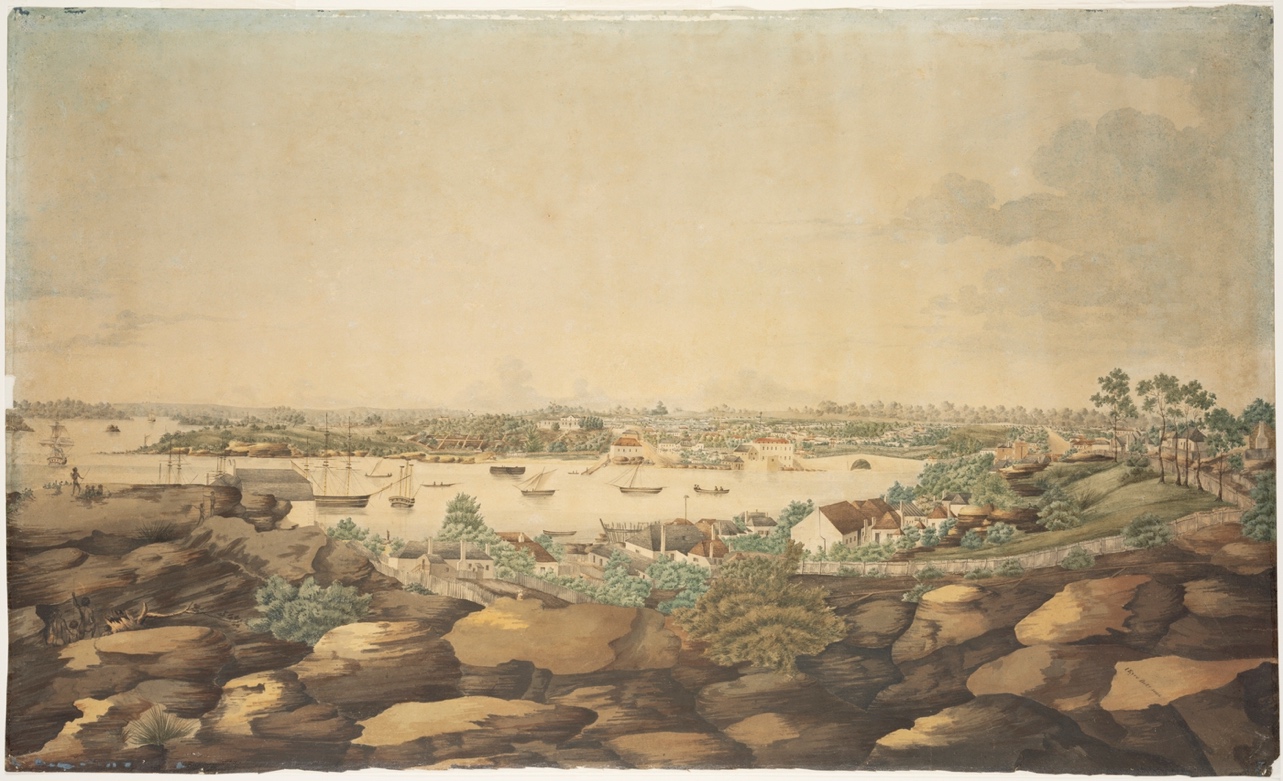
View of Sydney, taken from the western shores, John Eyre, 1806, watercolour, State Library of New South Wales
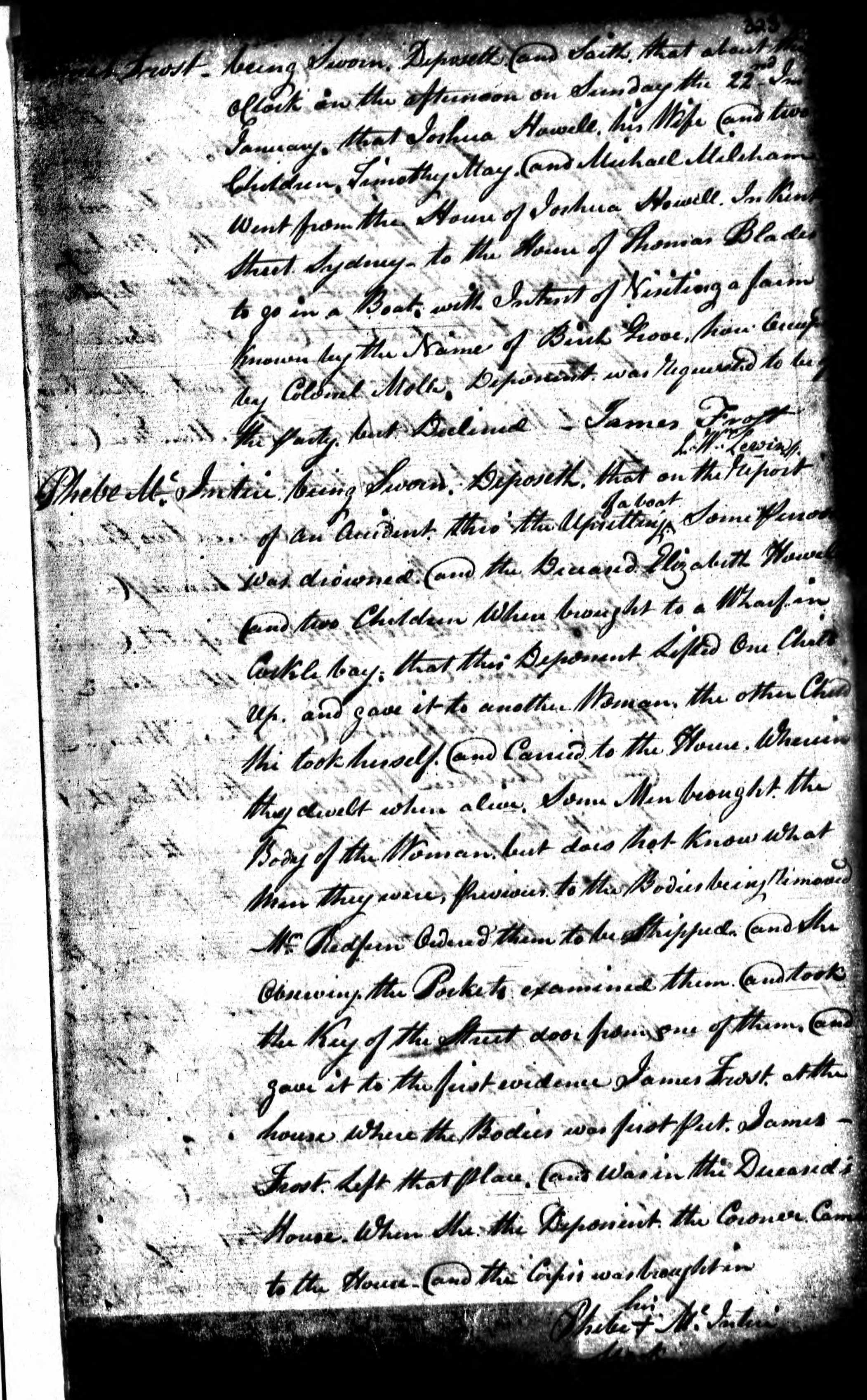
New South Wales Colonial Secretary’s Papers, Special Bundles, Inquest into the deaths of Thomas Blade and the Howell Family 23 January 1815
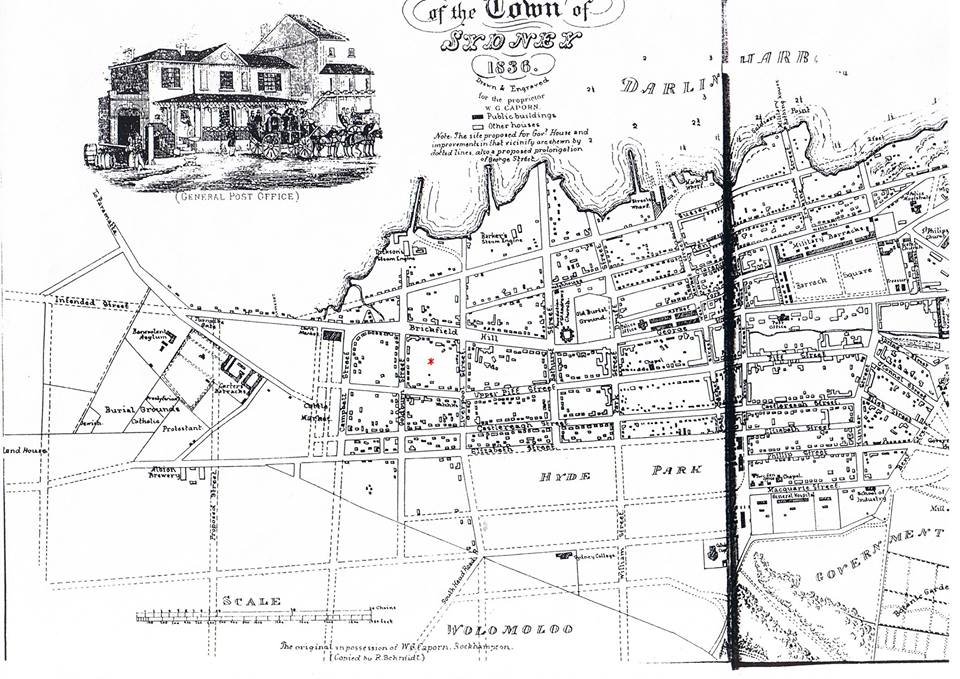
Map of Sydney Town 1834, image courtesy of Cathy Dee, Old Sydney Burial Grounds
Thomas Blade is listed as being buried in the Old Burial Ground at the top of George Street (see map) in a grave marked with a simple wooden cross, some time after the burial ground was closed, due to over capacity, the Sydney Town Hall was built over the graveyard in 1880. Sarah Blade must have been absolutely heart broken by her husband’s sudden death and it is hard to think how she coped with this tragedy. To compound matters, Sarah gave birth to a son, a few months later and poignantly named him Thomas Blade in honour of his father.
Australia Birth Index, 1788-1922
| Name | Thomas Blades | ||||||||||||||||||||||
| Birth Date | 1815 | ||||||||||||||||||||||
| Birth Place | New South Wales | ||||||||||||||||||||||
| Registration Year | 1815 | ||||||||||||||||||||||
| Registration Place | Sydney, New South Wales, Australia | ||||||||||||||||||||||
| Father | Thomas Blades | ||||||||||||||||||||||
| Mother | Sarah | ||||||||||||||||||||||
| Volume Number | V18153659 1B | ||||||||||||||||||||||
|
Baptism of Thomas Blade, St Philip’s Church Sydney 6 Aug 1815
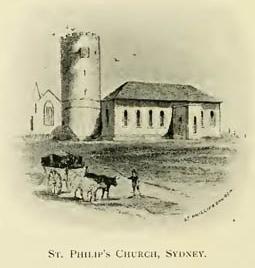
St Philip’s Church, Sydney
Many referred to this St Philip’s as the ugliest church in the Colony of New South Wales, mainly because of the ungainly unsymmetrical tower. It was built in 1798 after the first St Philip’s, a wattle and daub building, which stood on the corner of Bligh and Hunter Streets was gutted by fire in 1798, and opened in 1810. The new St Philips was built in 1856 at Lang Park on Grosvenor Street, Sydney.

1828 New South Wales, Australian Census for Thomas Blade Jnr.
Thomas Blade is listed as a 13 year old, who was born in the Colony of New South Wales, living in Sussex Street with George Smith, his step-father. Nothing more is known about Thomas.
Sarah Ann Blade (1809-1856) was an older sister of Thomas Blade Jnr, and she married John Ireland (1799-1847) in 1826 and they had ten children, Mary Ann Ireland (1827-1895), Sarah Ireland (1829-1911), John H Ireland (1830-1831), John Thomas Ireland(1833-1909), James B Ireland (1835-1884), George Ireland (1837-1904), William Henry Ireland (1840-1917), Thomas Ireland (1842-1928), Jane Ann Ireland (1844-1891) and Isabella Ireland (1846-1888). After the death of John Ireland Sarah Ann Blades married Samuel Lucas (1819-1905) at Ashfield, in 1851.
John Ireland was a convict from Hereford, England who arrived in Sydney aboard the Guildford in 1824.
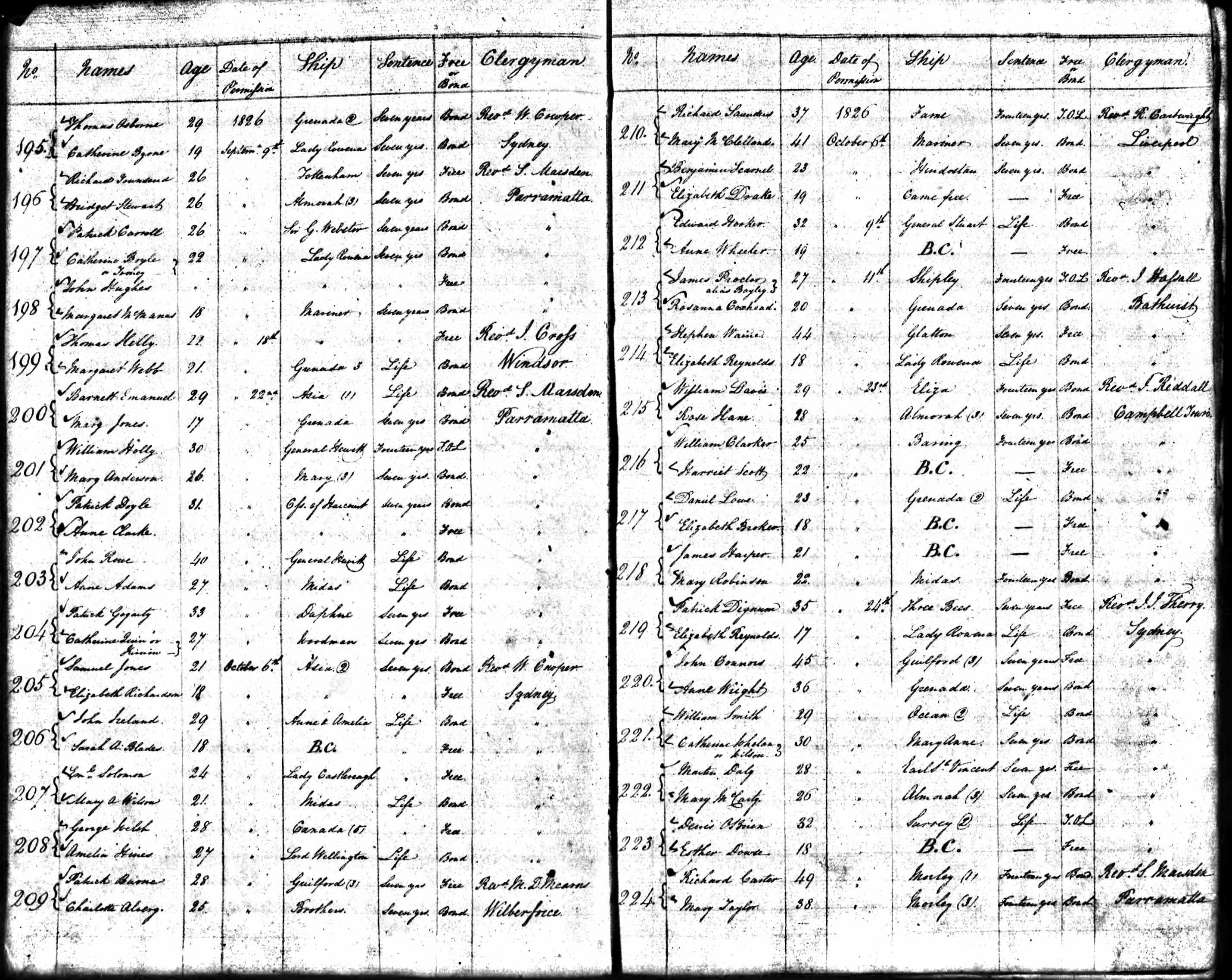
Permission for John Ireland and Sarah Ann Blade to Marry, 1826, NSW Australia Register of Convicts Applications to Marry, 1826-1851
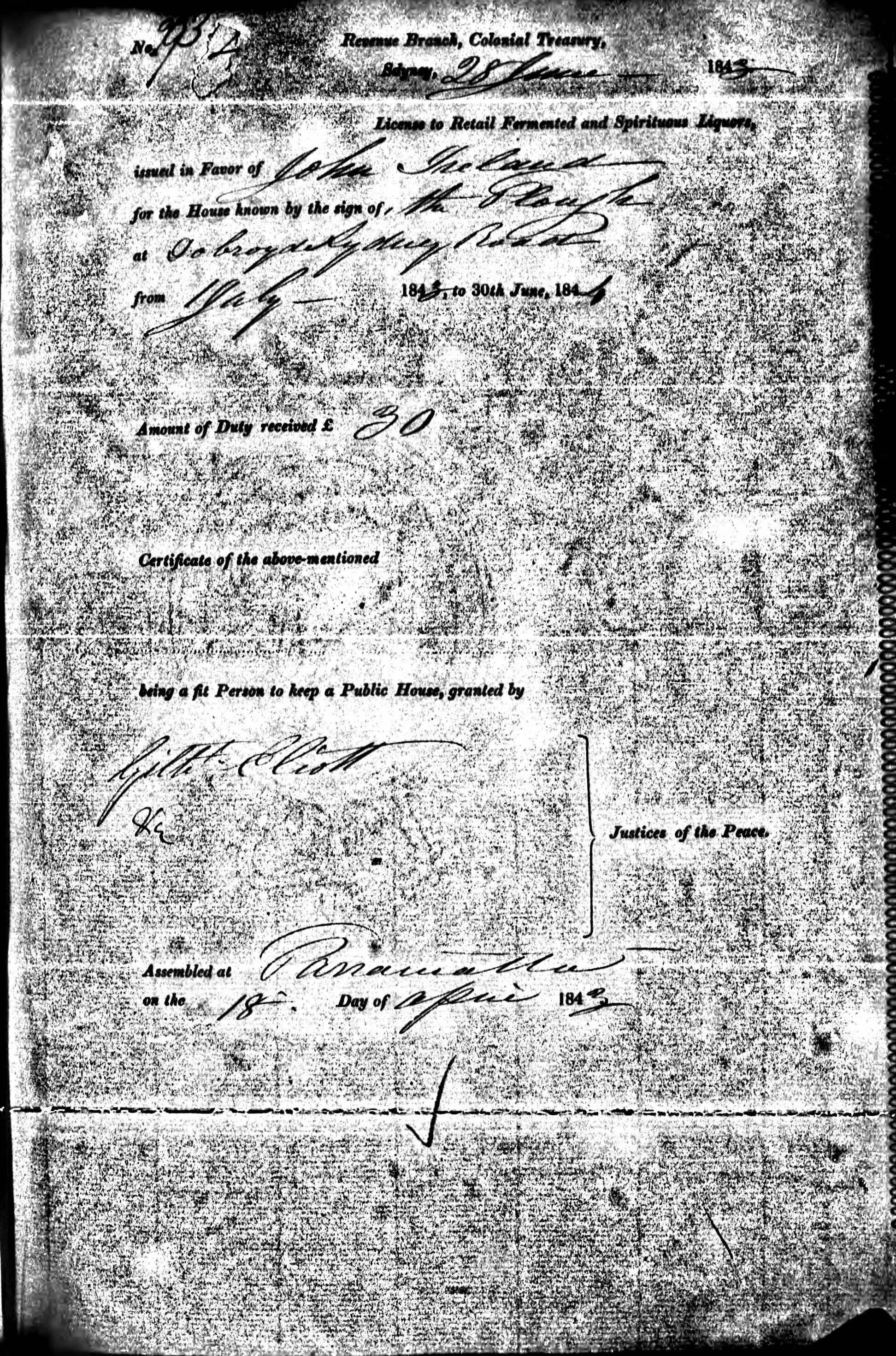
John Ireland, 1843 Publican of “The Plough”, NSW Certificate for Publican Licence 1830-1849
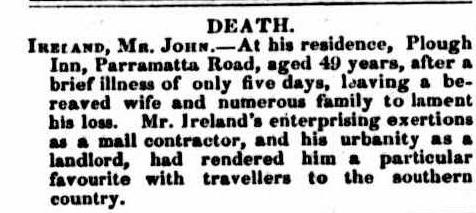
Death of John Ireland, Australian, 11 February 1847
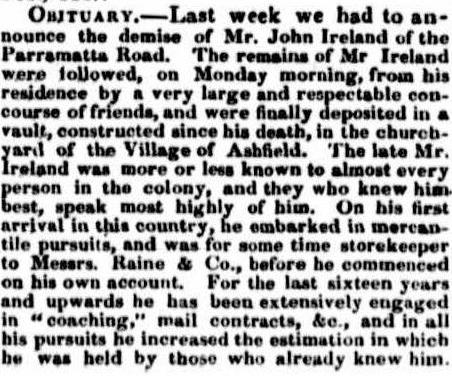
Burial of Mr John Ireland, Australian, 18 February 1847
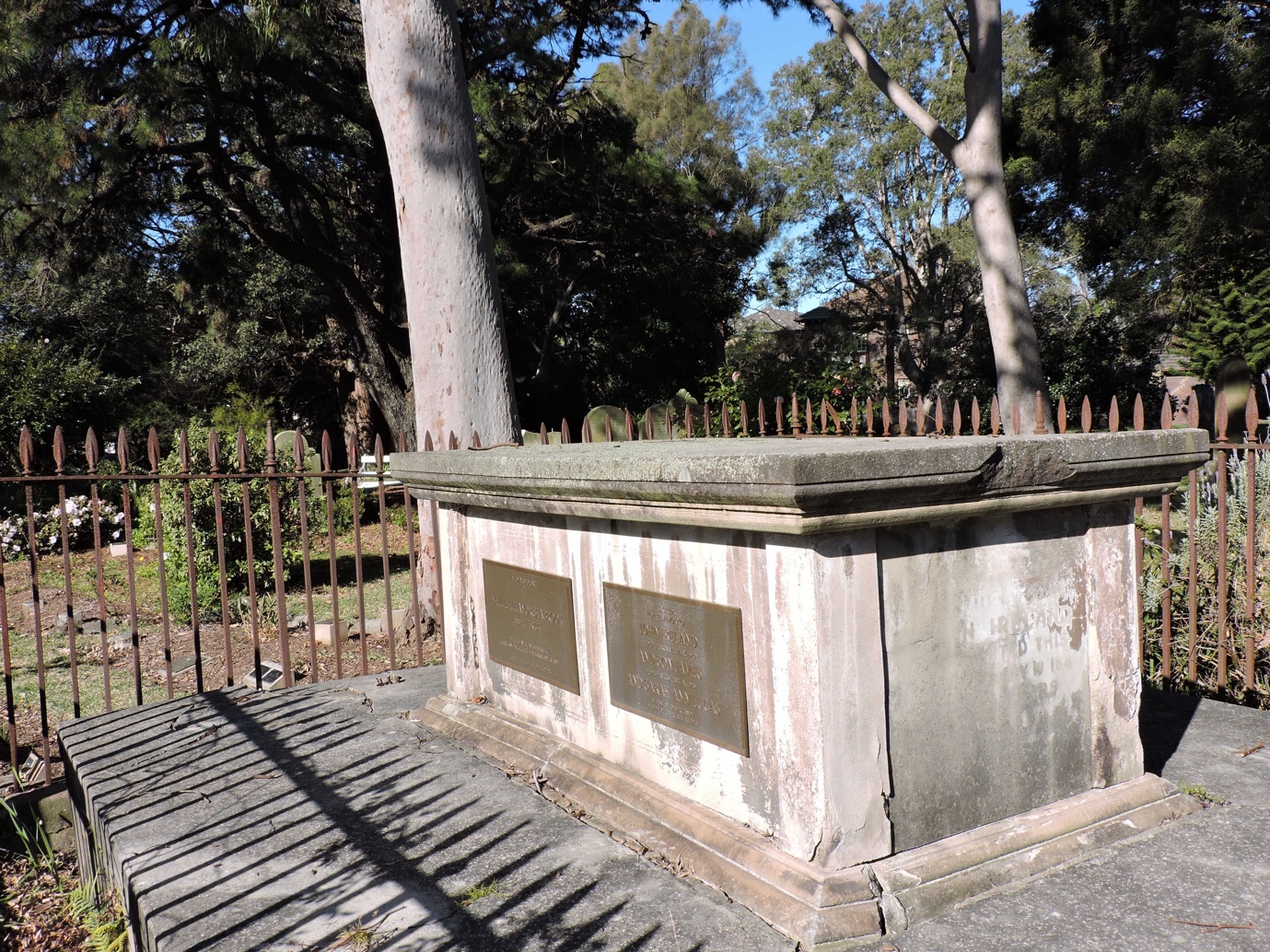
Ireland Family Crypt, Ashfield Cemetery, image courtesy of Kerrie Het, from the Heterick/Cook, & Owen/Counsell Family Tree on ancestry.com
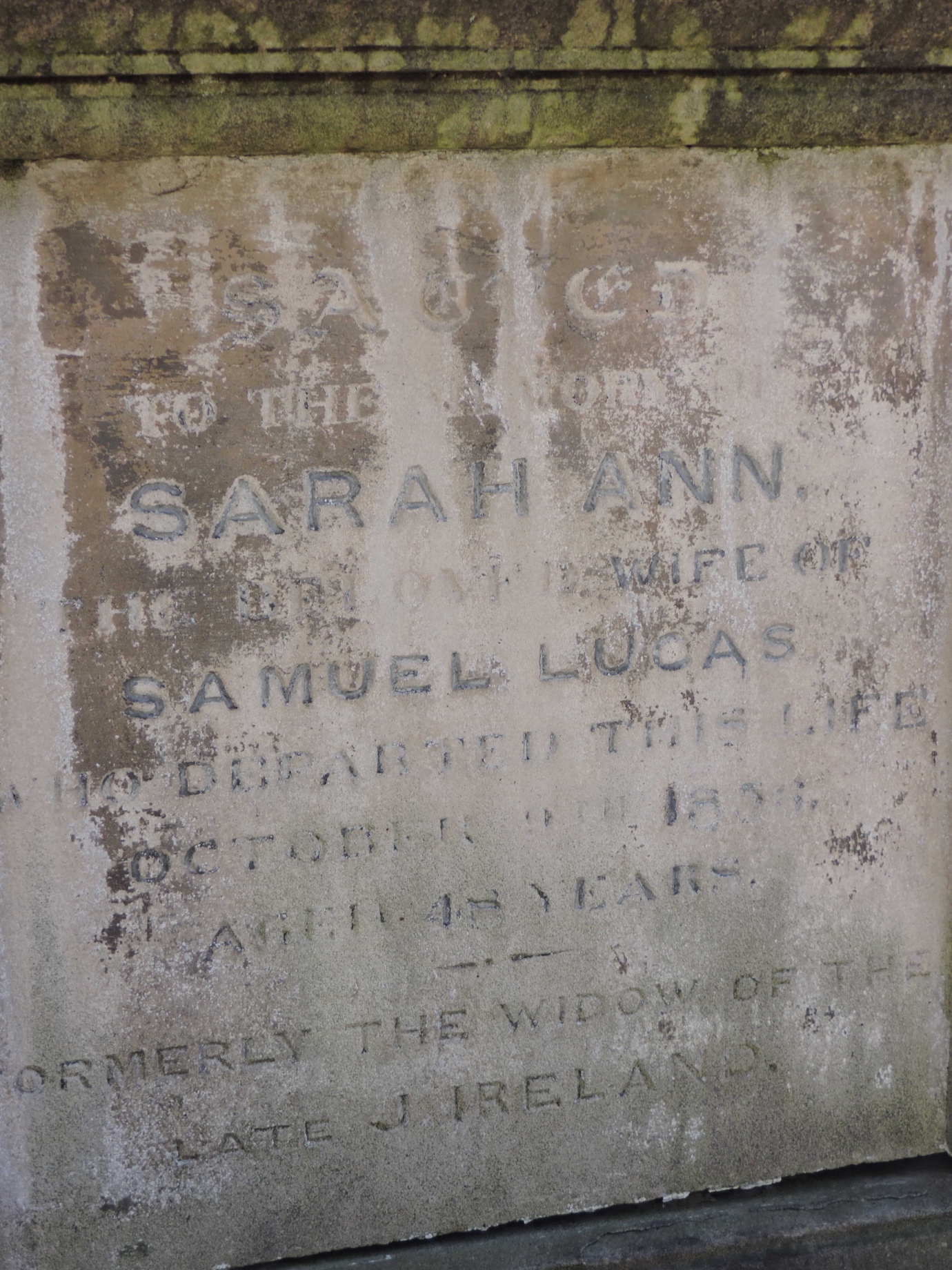
Grave stone of Sarah Ann Lucas formerly Ireland, wife of Samuel Lucas, Ireland Family Crypt, image courtesy of Kerrie Heterick, from the Heterick/Cook, & Owen/Counsell Family Tree on ancestry.com
Caroline Blade (1801-1867) daughter of Thomas and Elizabeth Blade married twice, firstly to William Henson (1792-1832) in 1822 and they had six children, Robert Blade (1820-1871), Thomas Henry Blade (1822-1900), Rebecca Elizabeth Henson (1824-1869), William Henson (1826-1903), John Charles Henson (1828-1890) and Mary Ann Henson (1830-1870). Caroline then married Samuel Jackson (1792-1870) in 1833 and they had five children, Samuel Jackson (1833-1884), George Jackson (1835-1884), Jane Ann Jackson (1838-1991), Charles John Jackson (1840-1877) and Sarah Jackson (1843-1909).
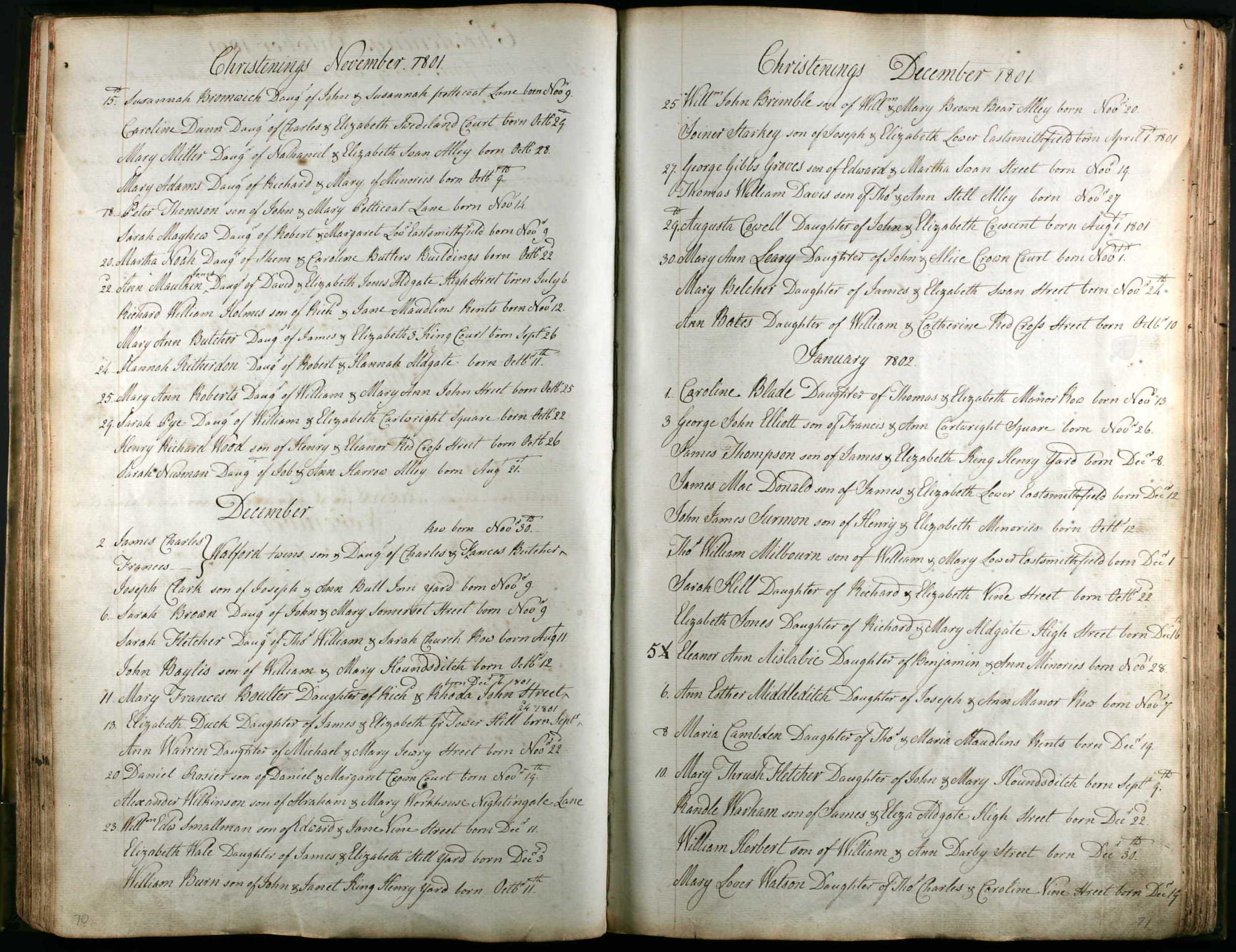
Baptism of Caroline Blade, 1 January 1802, born Nov 10 1801, St Botolph’s Church, Aldgate, London, London, England Baptisms Marriages and Burials, 1538-1812
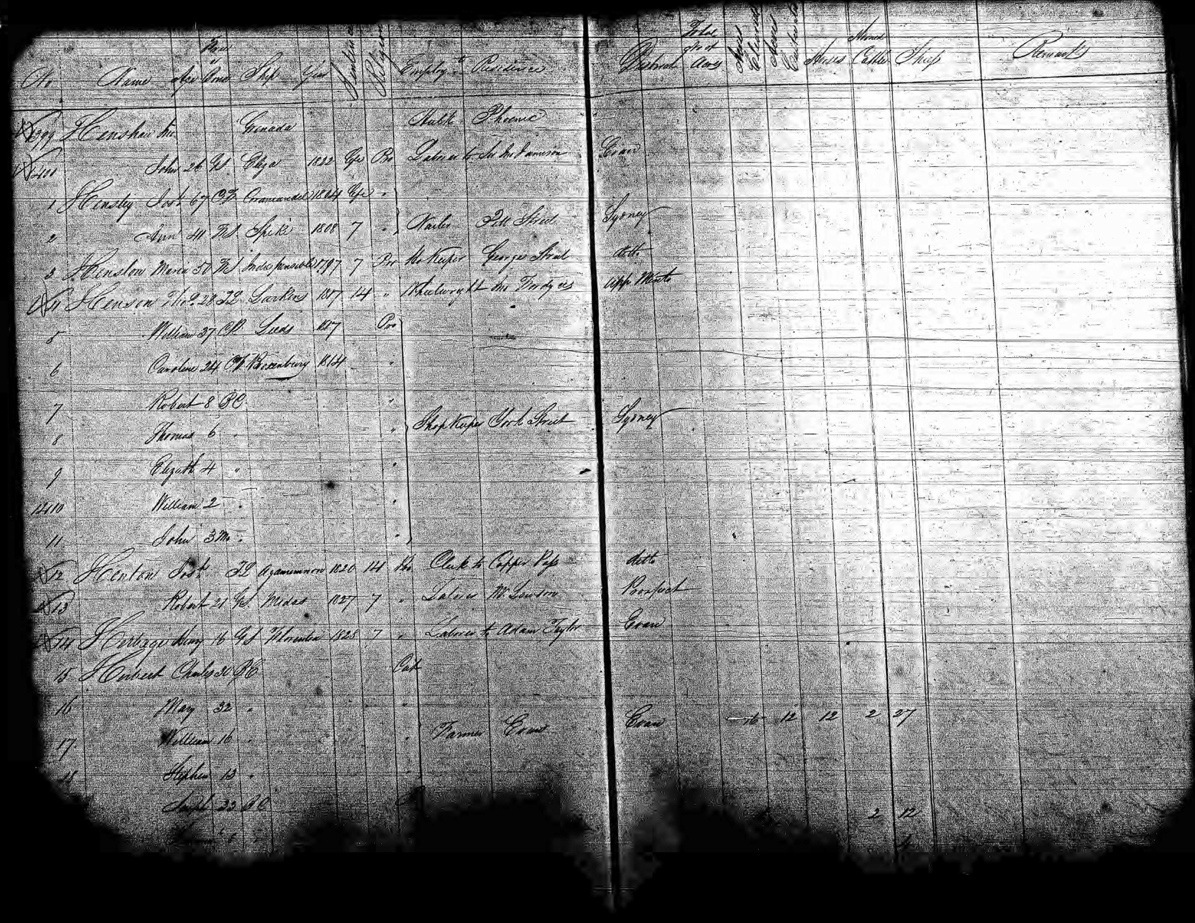
1828 New South Wales, Australian Census for Caroline Henson
Caroline Henson of the Broxbournebury is listed with her husband William aged 37, a shopkeeper living in York Street, Sydney. Listed are five of the Hensons children, Robert 8, Thomas 6, Elizabeth 4, William 2 and John just 3 months of age.
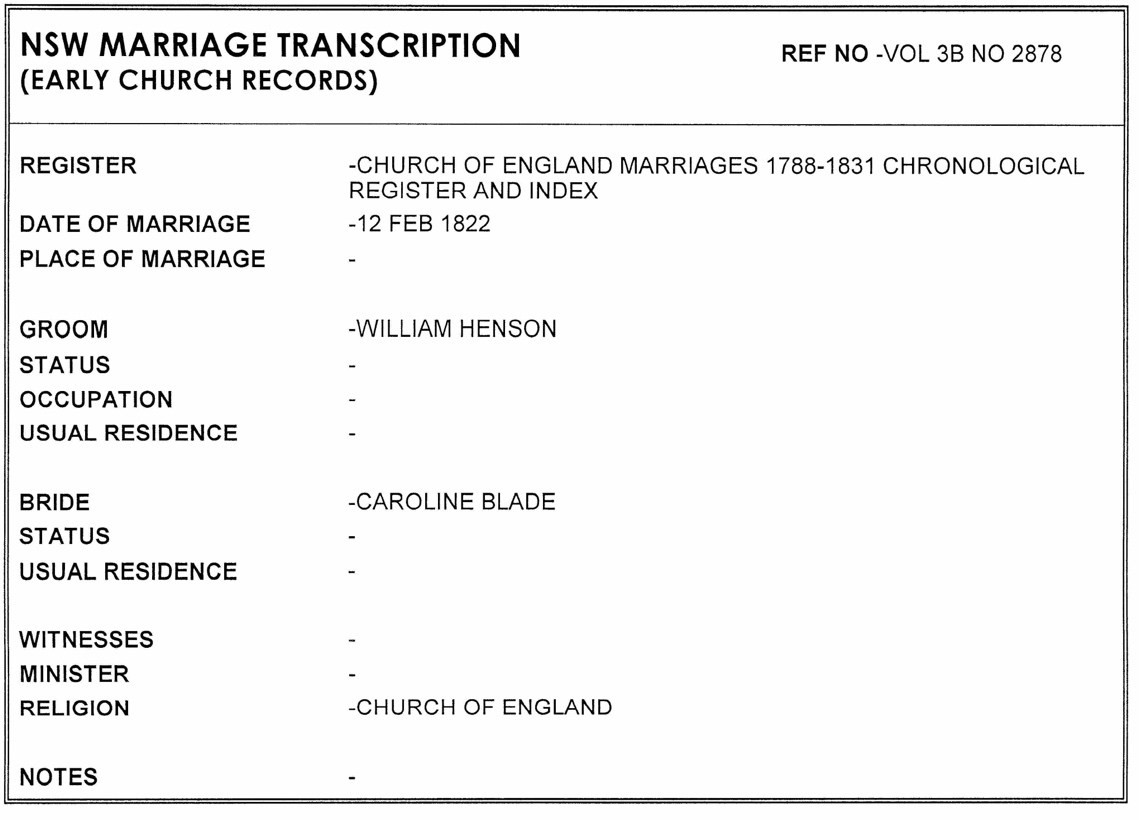
Marriage Certificate for William Henson and Caroline Blade, New South Wales, 12 Feb 1822, courtesy of Leigh Mc C ancestry.com Hutton Family Tree
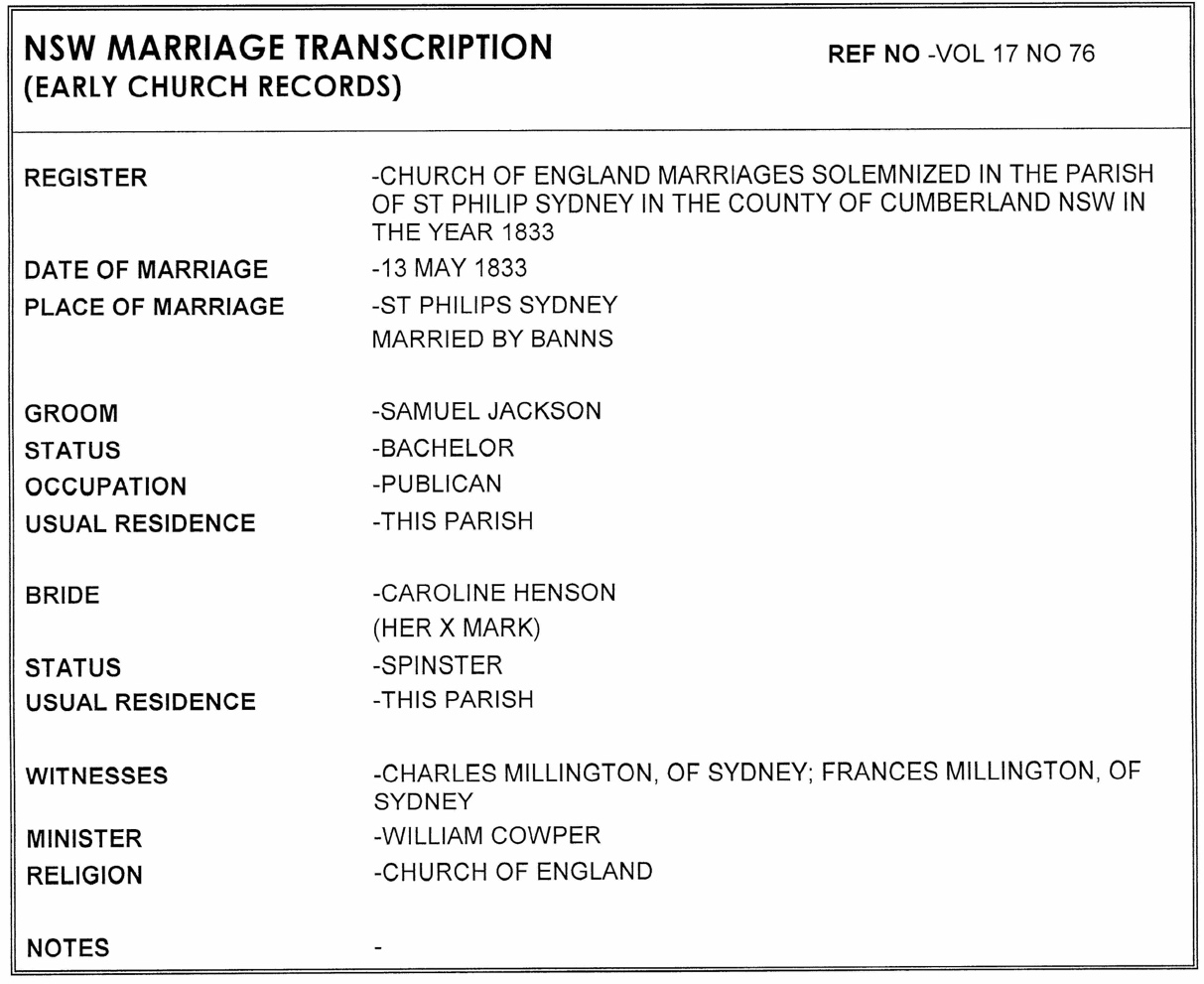
Marriage Certificate for Samuel Jackson and Caroline Henson, St Philip’s Church, Sydney, 13 May 1833, courtesy of Leigh McC ancestry.com Hutton Family Tree
This is where I end my chapter on the Stewart, Smith and the Blade Families. It has been an honour to have researched this family tree on behalf of my husband Geoffrey Rundle, in the knowledge that this information will now be passed down to our children and grandchildren as a tribute to the early contribution their family has made to the Colony of New South Wales. It has been our absolute joy to find the Stewart Grave at Waverley Cemetery and to restore it to its former glory there among the stones overlooking the Pacific Ocean. If ever a more beautiful place in the world could have been chosen to remember and respect our early ancestors, you could search the world and find no better place.
I would like to dedicate this chapter of my family history to Potsy Quigley, for without her collaboration and very kind sharing her Stewart Family documents, this history would be unfinished. It has been overwhelming to meet so many wonderful family descendants of the Stewarts and without exception they are all happy to share their documents in the quest for finding out the past. I congratulate them all and in particular Potsy, and will long remember our weekend in June 2018 when she visited Sydney. It was such a pleasure to be her tour guide to some of the very earliest cemeteries of Sydney.
I look forward to comments from Stewart, Smith and Blade family researchers and descendants on my website, and if I will update my research as new evidence comes to light.
Virginia Rundle, April 2018, updated Mar 2019
Acknowledgements and Bibliography:
Leigh McC ancestry.com Hutton Family Tree
Warwickv1 from ancestry.com Venables Family Tree
lkmitchell2 ancestry.com family tree
Kerrie Heterick, from the Heterick/Cook, & Owen/Counsell ancestry.com Family Tree
Potsy Quigley kindly copied and posted The Stewart Family Collection, a series of original documents, maps and other family information that she had carefully researched
Bev Giveen, for kindly helping on the Blade family and their descendants, providing many documents and emails full of information
Maureen Robinson, Two Ships, Two Hundred Years Ago, 2014
Kath Booth for kindly uploading the photo of William and Elizabeth Howard to ancestry.com
Neil Stewart for kindly uploading John Stewart’s grave photos at Camperdown Cemetery
Noelene Williams, as Noelene_W and her Bathis/Williams family tree
Ancestry.com.au subscription website
State Library of New South Wales
Ashfield Cemetery, Sydney
Waverley Cemetery, Sydney
Camperdown Cemetery, Newtown, Sydney
Rookwood Cemetery, Sydney, New South Wales
New South Wales State Archives
Ship’s Lists of New South Wales
Trove Digitised Newspapers, National Library of Australia
Nathgate 31 ancestry.com
Wikipedia.com
Colonial Secretary’s Index 1788-1825, online resource
Old Bailey, London, online
Family Search.org, Bishop’s Transcripts, Terrington St Clement, Norfolk, England
Cathey Dee, Old Sydney Burial Grounds

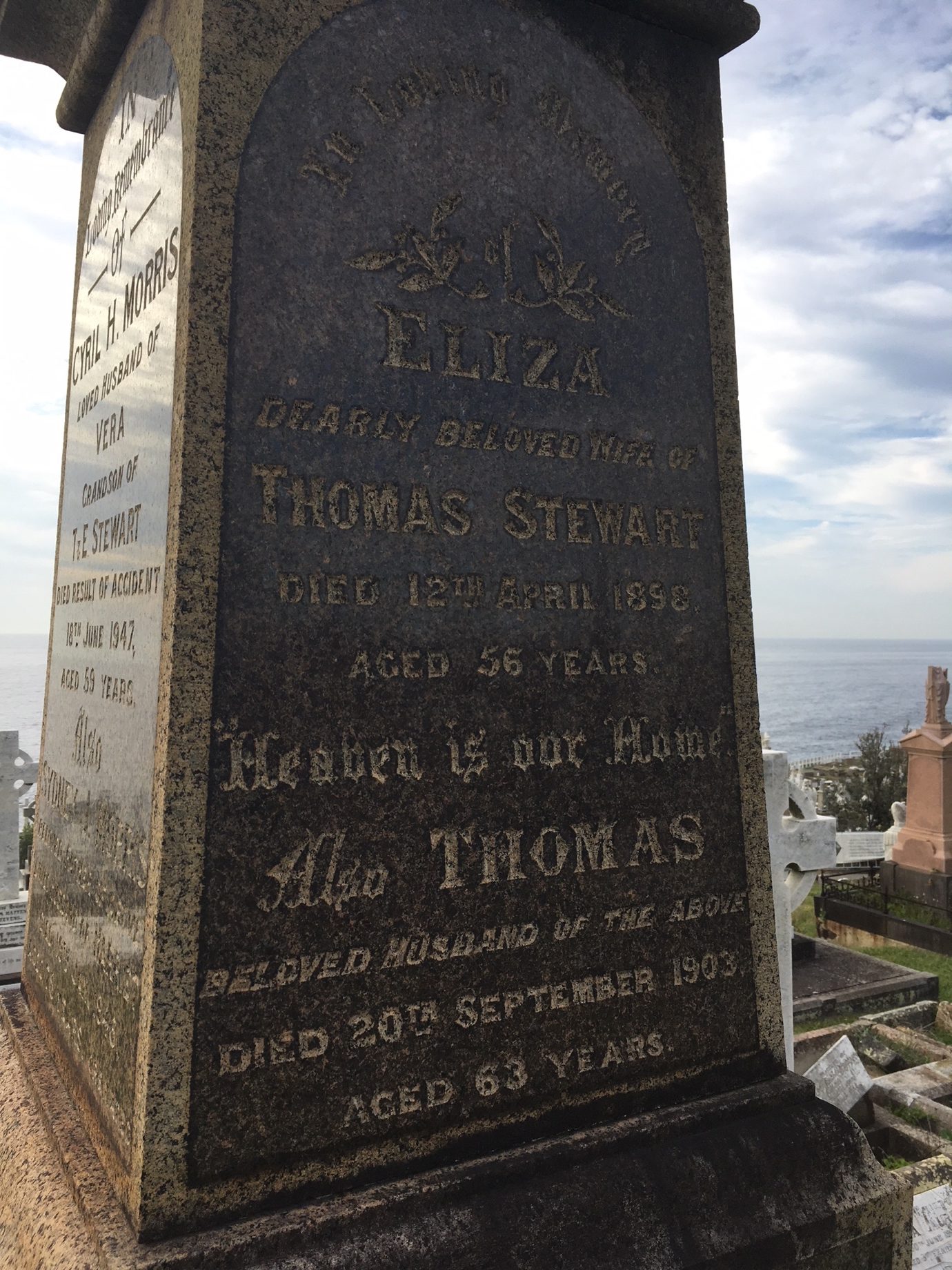
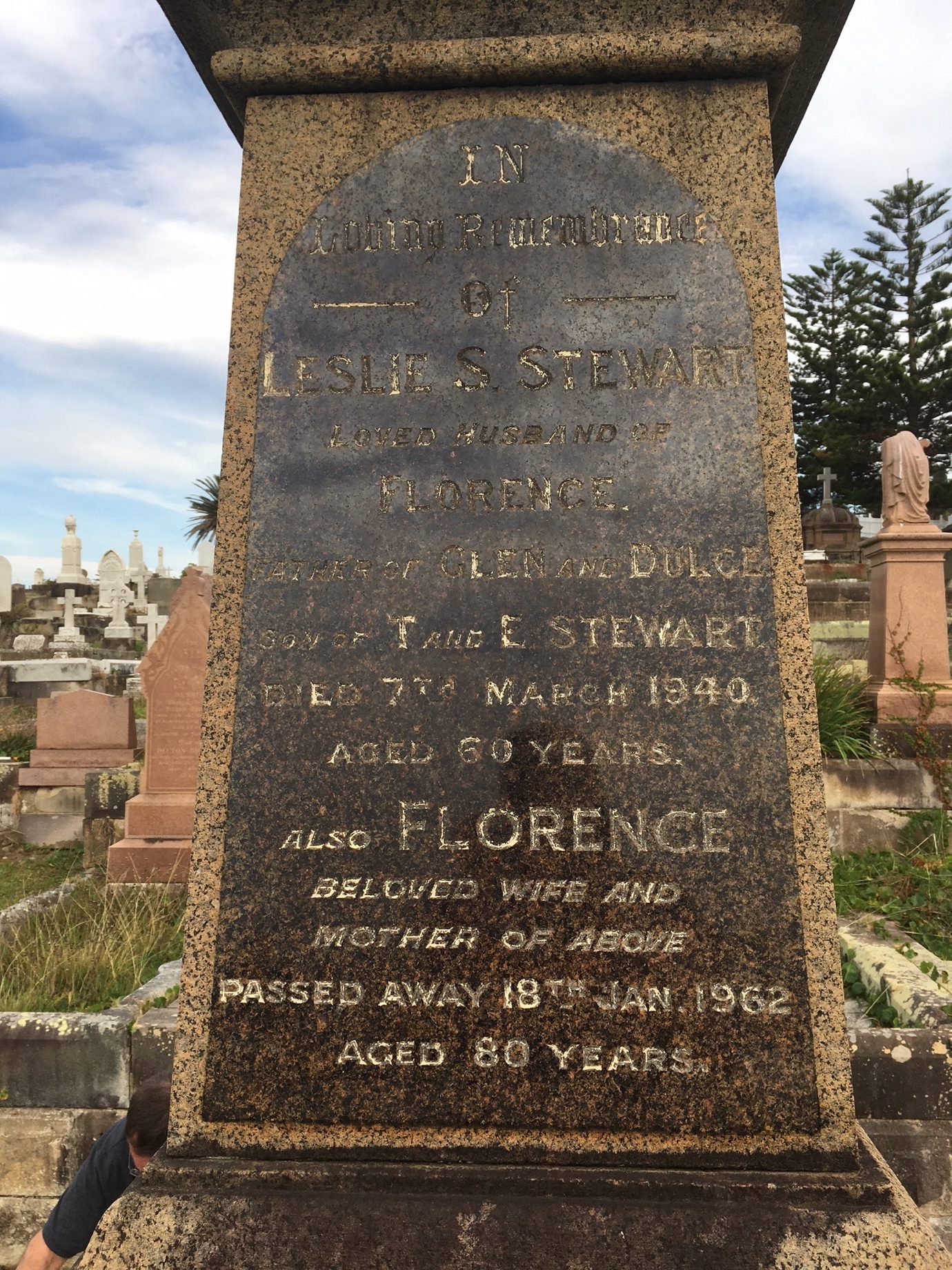
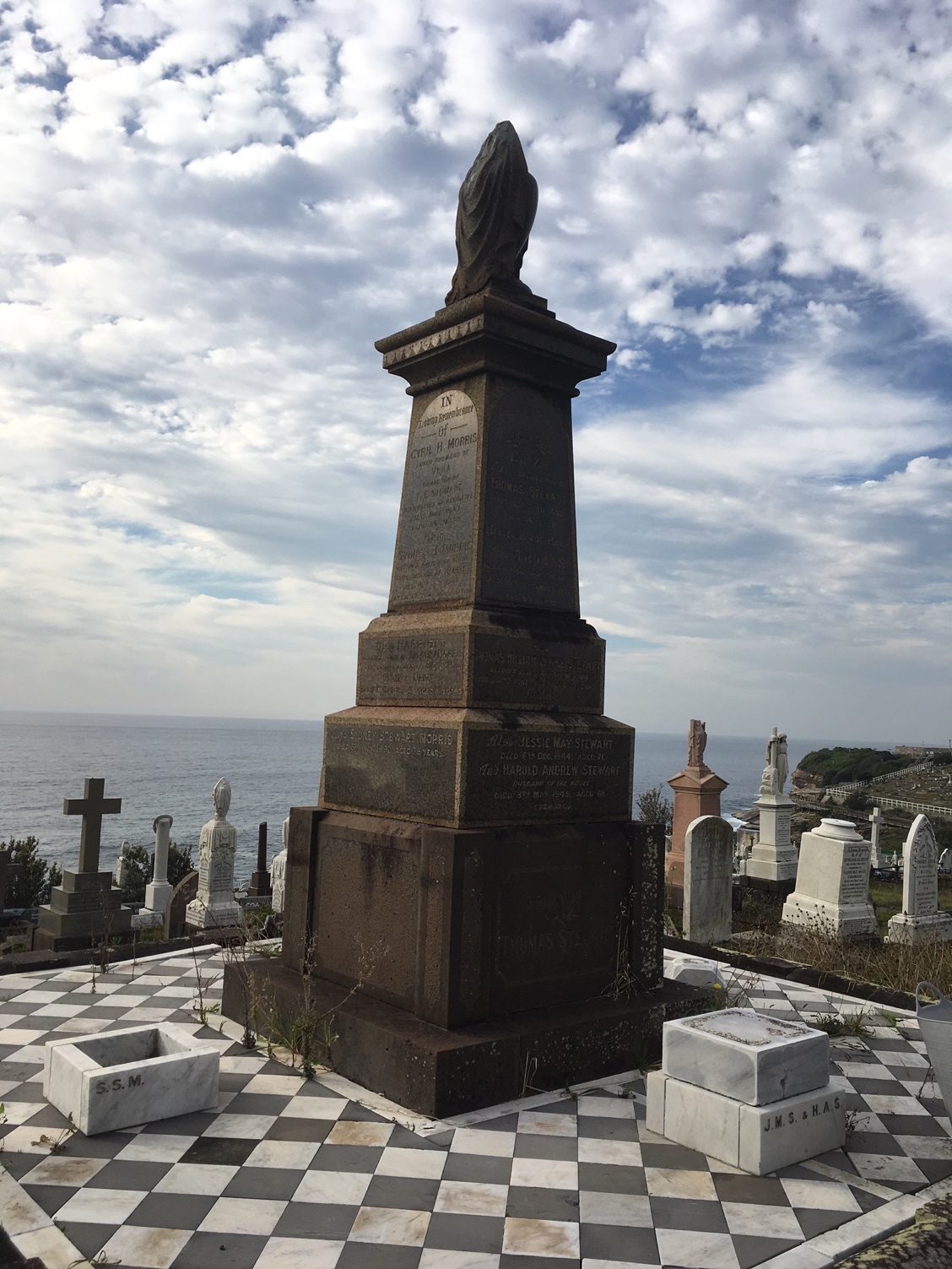
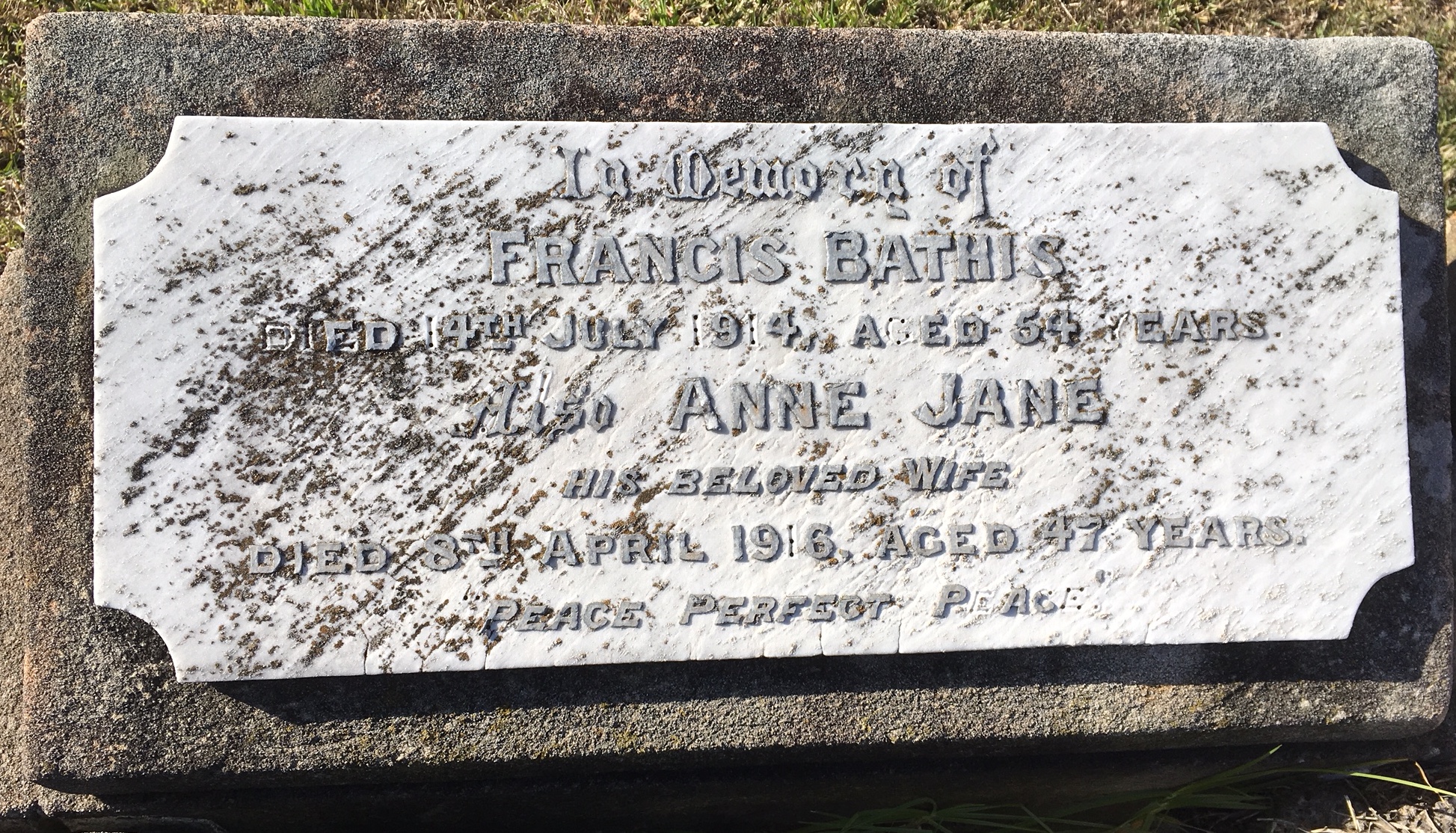
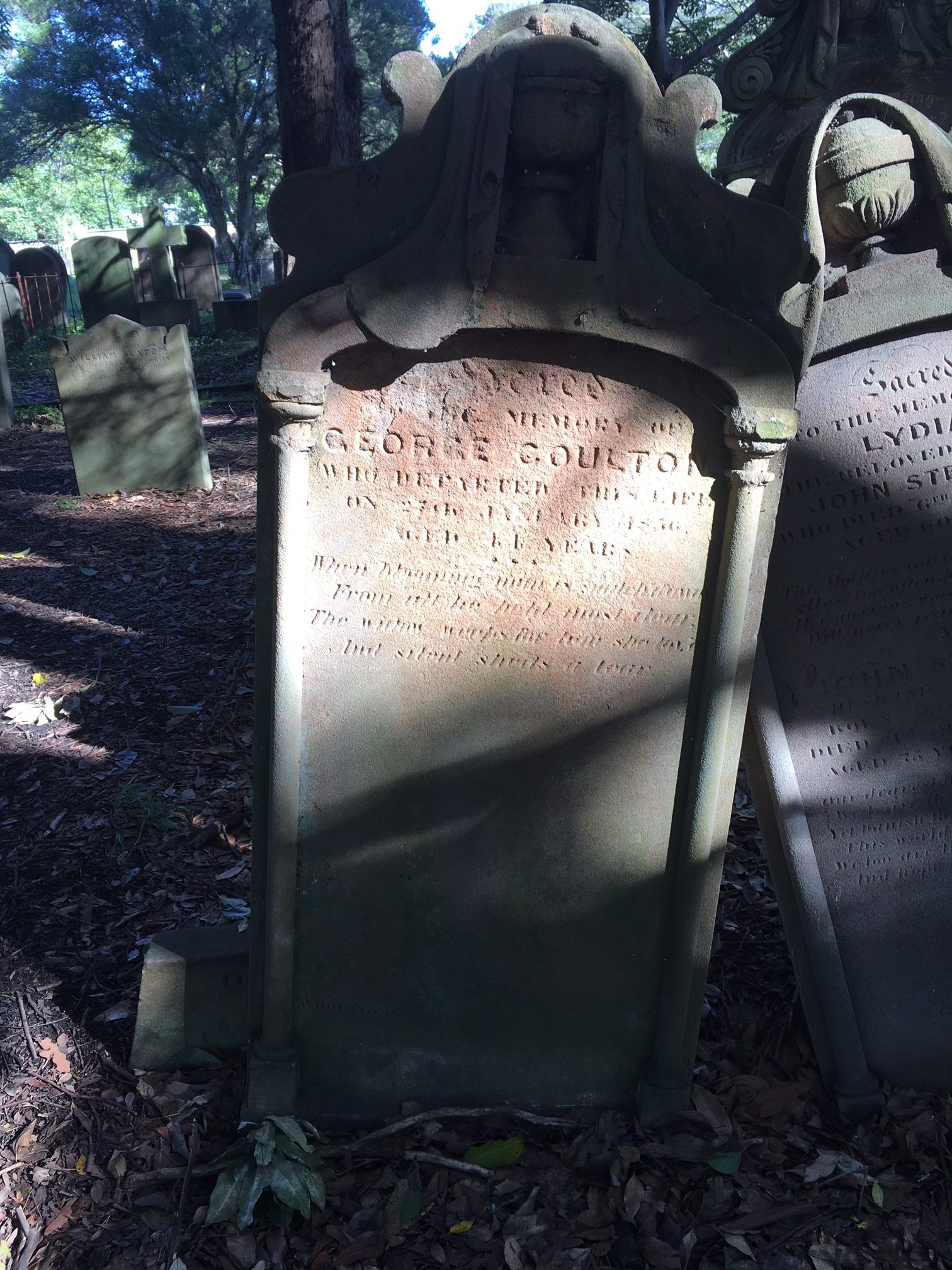
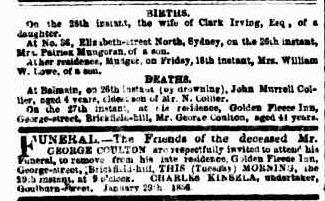
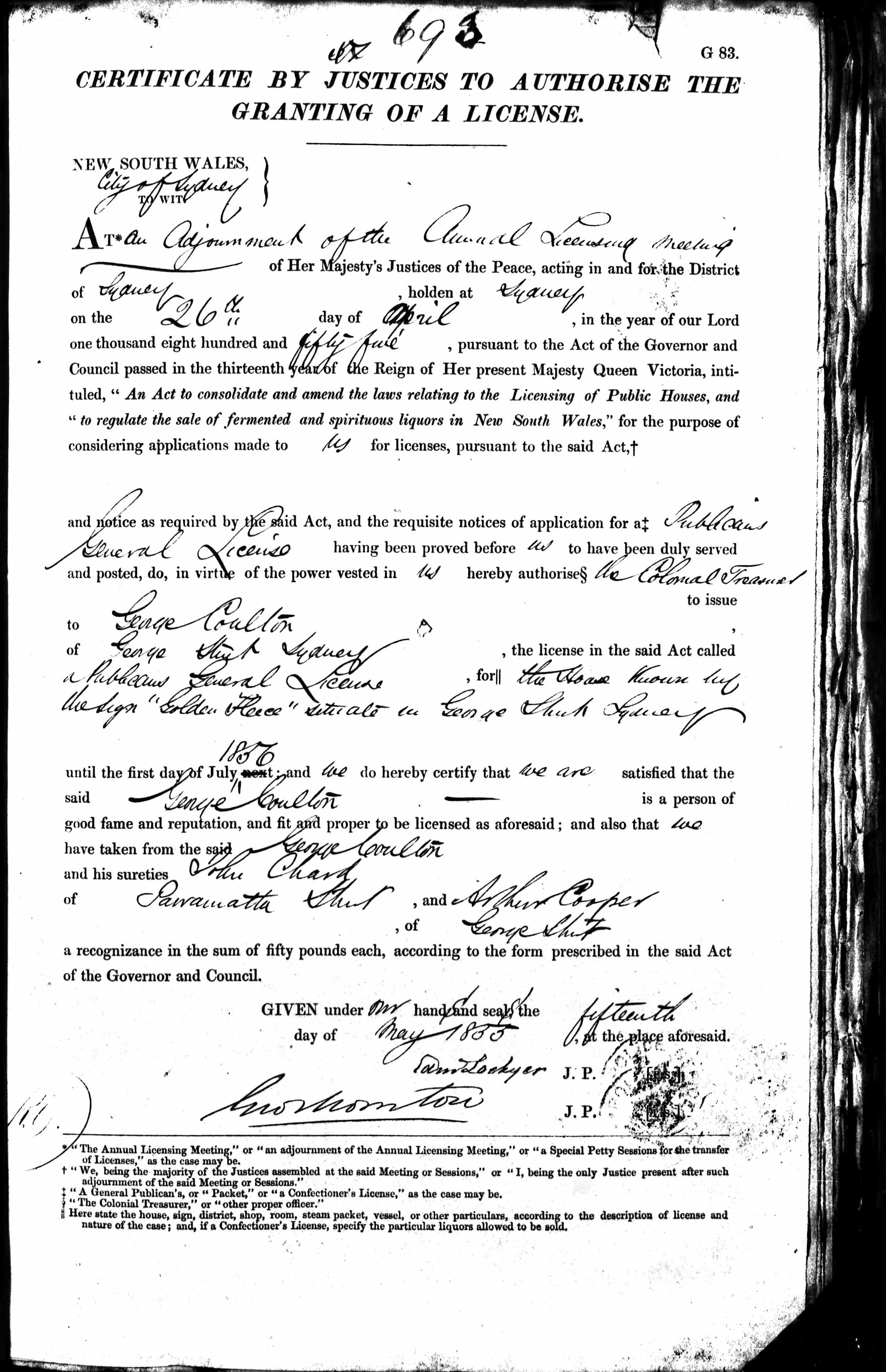
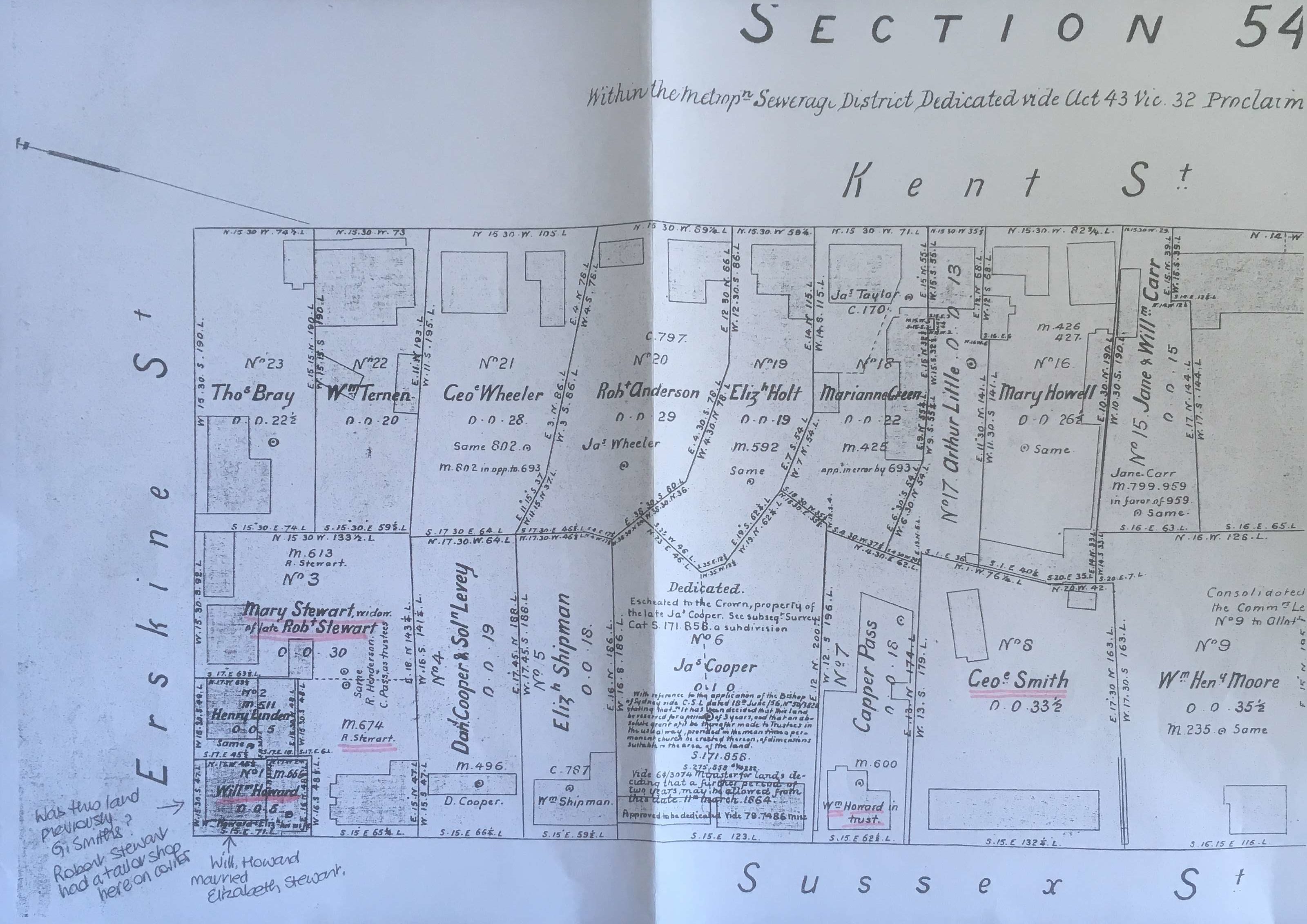
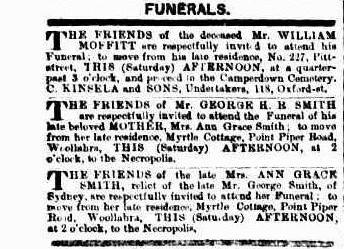
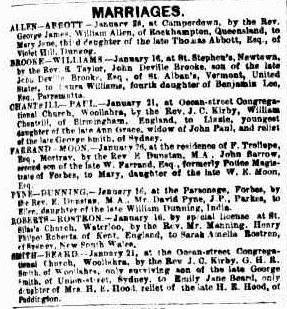

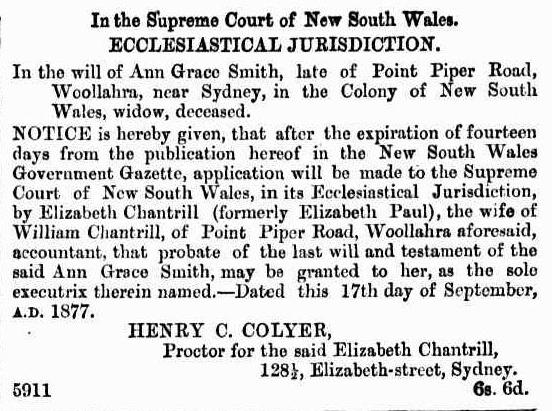
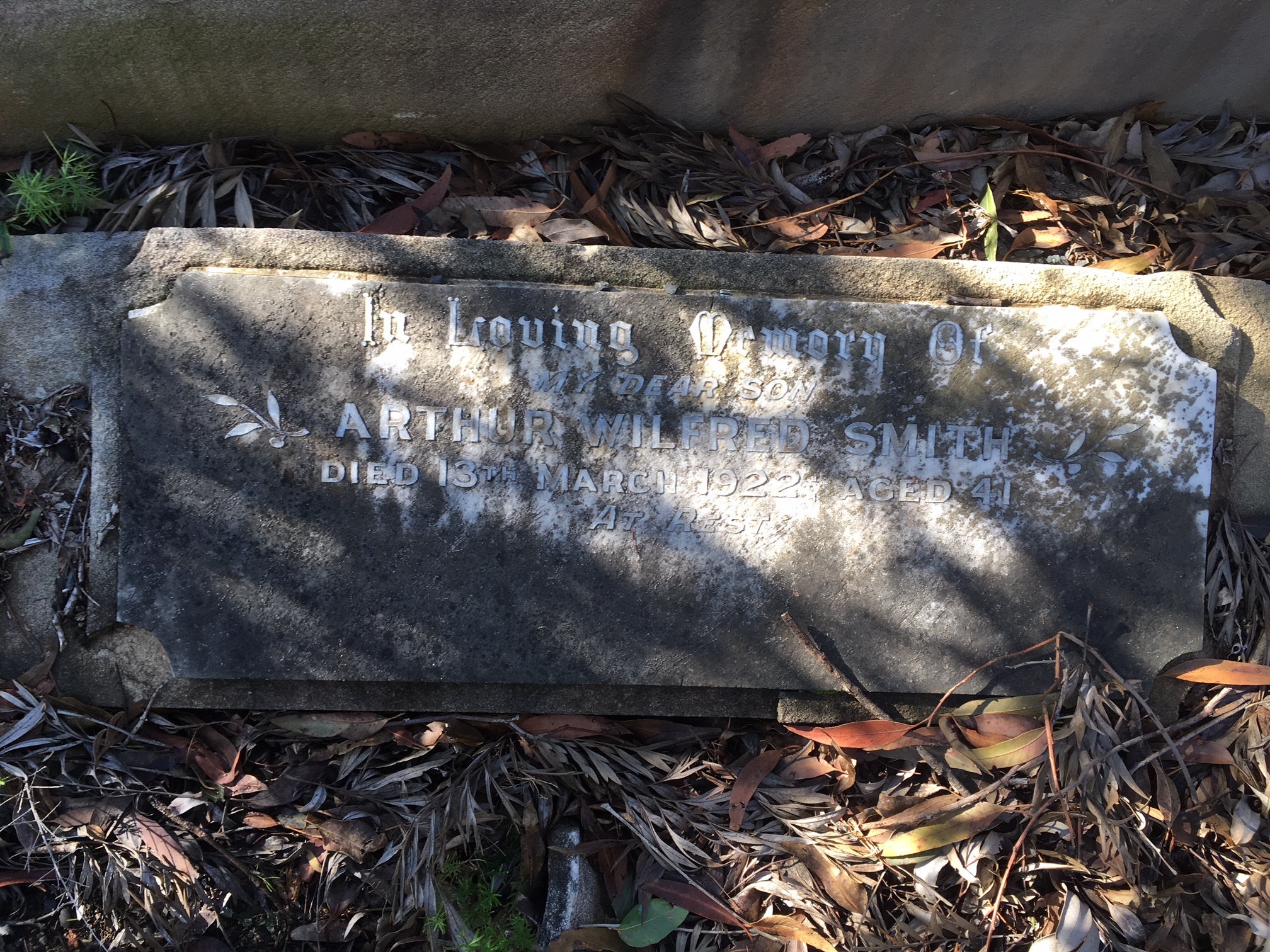
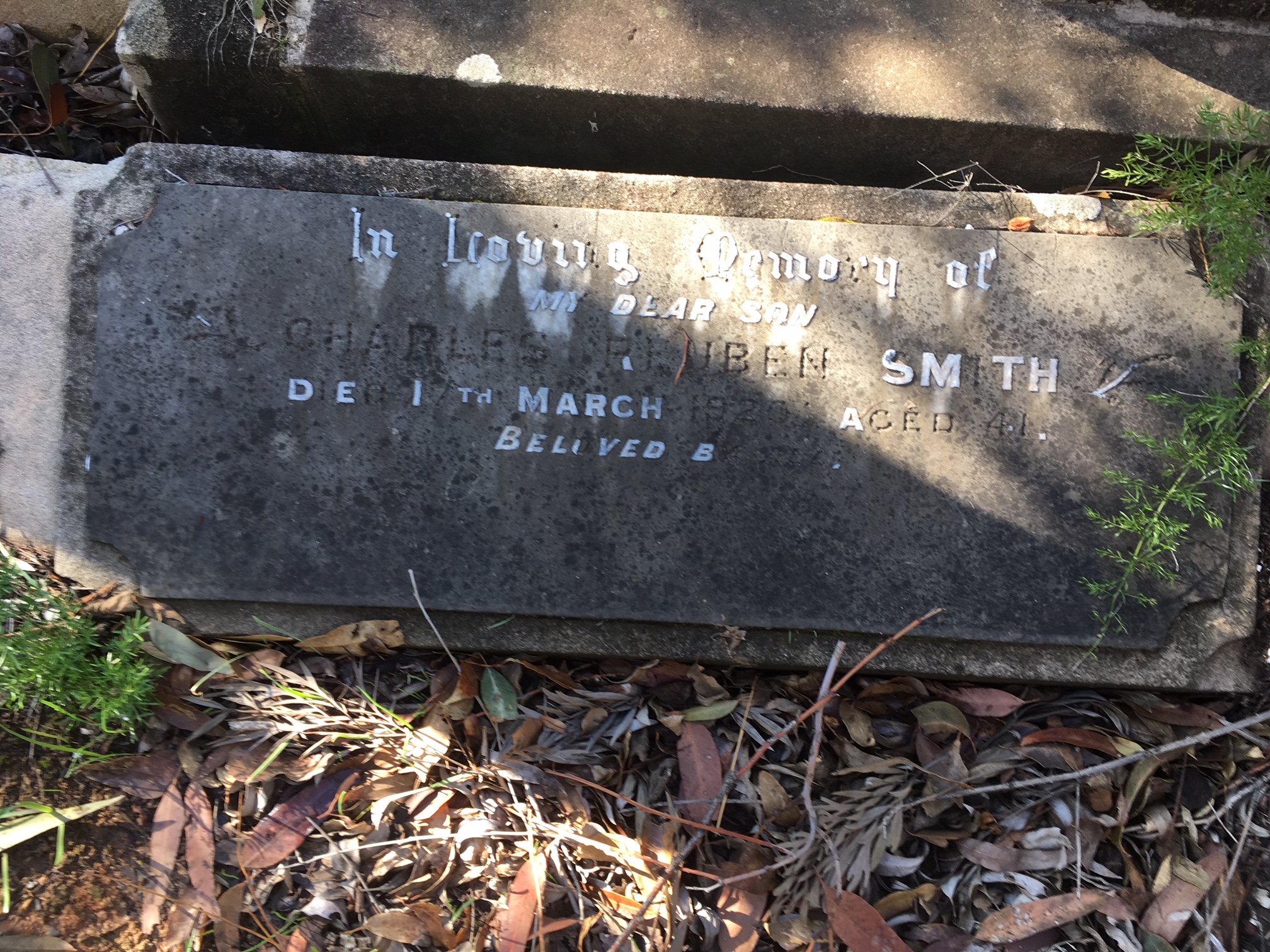
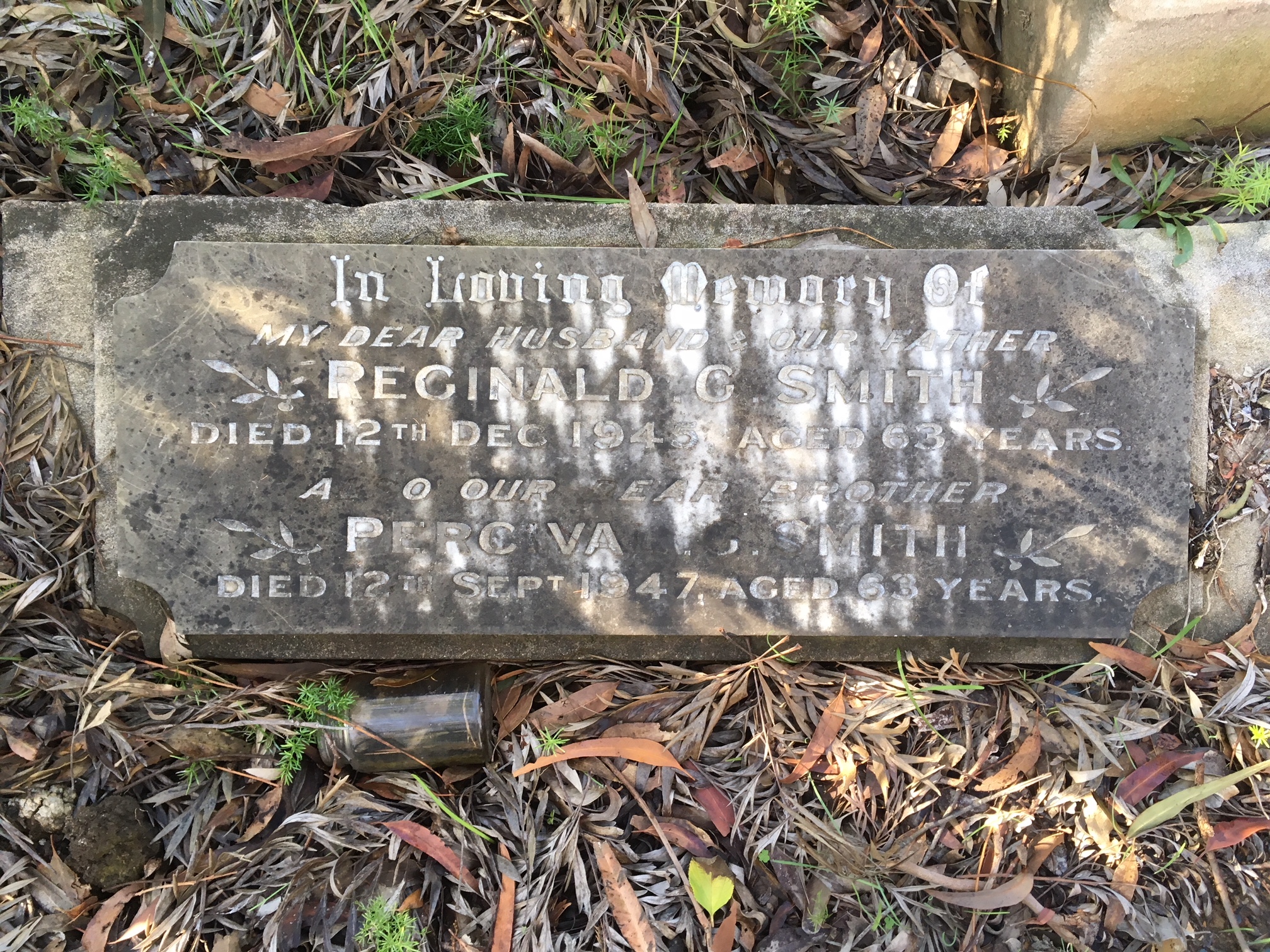
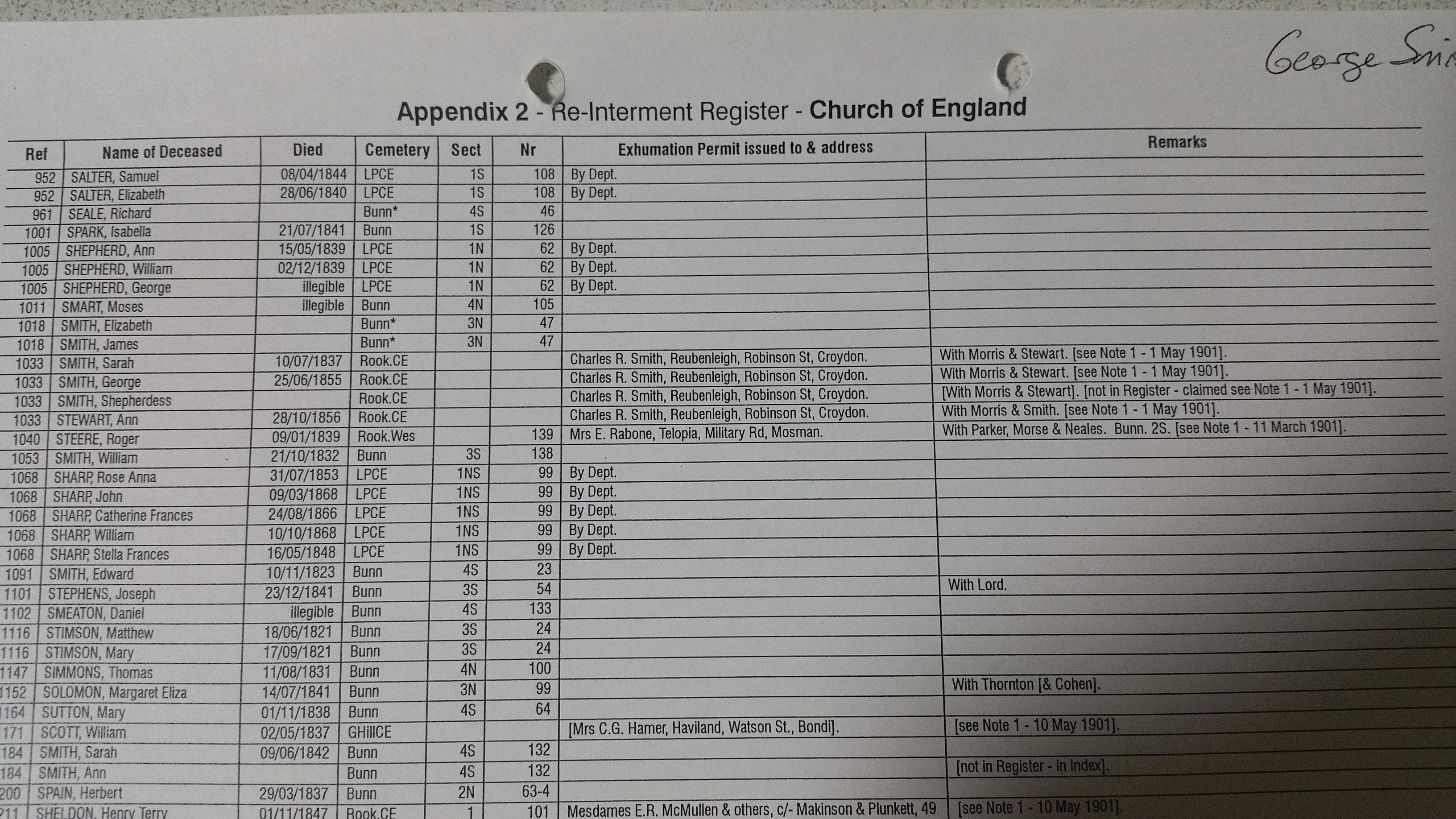

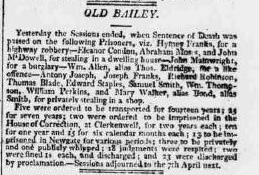

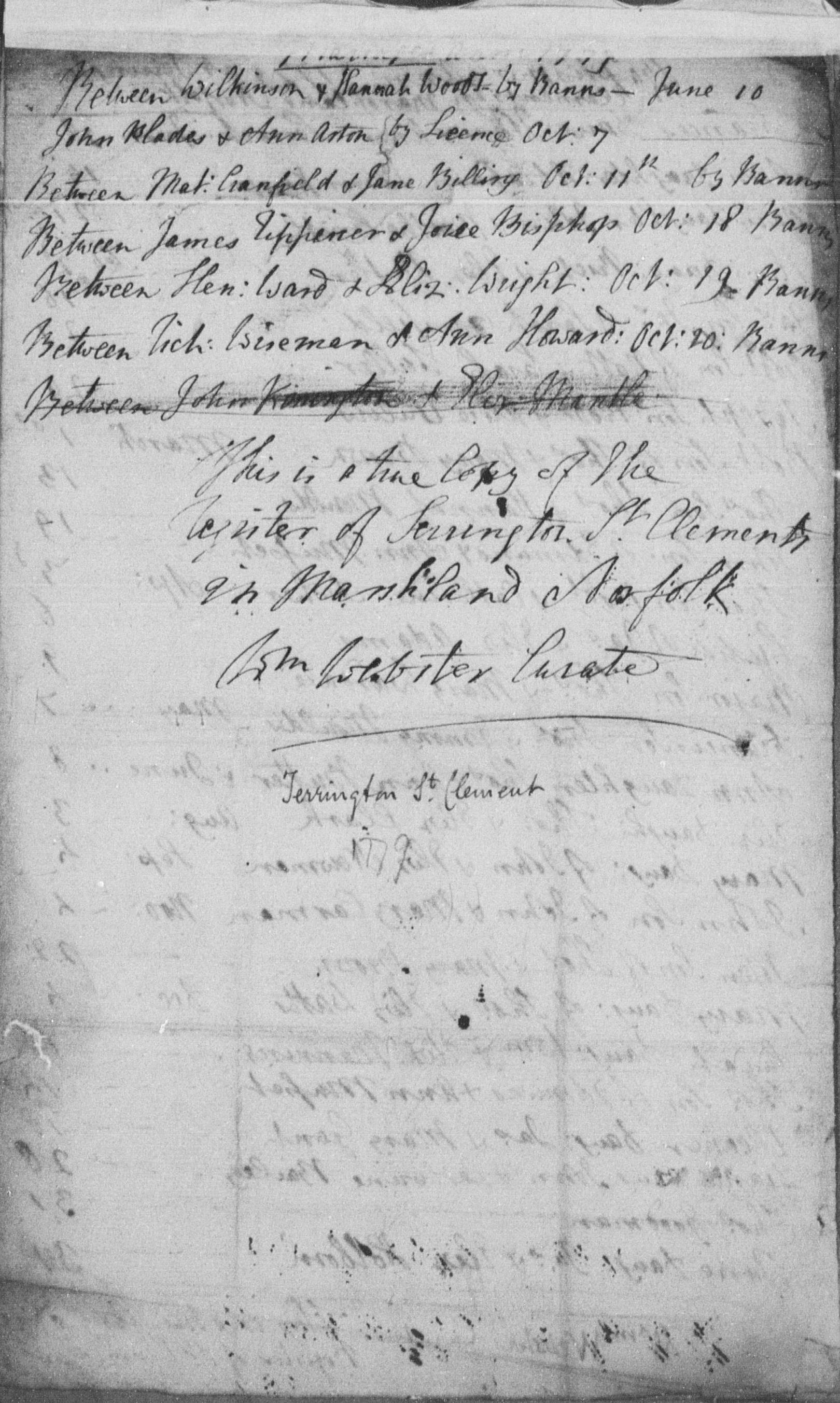
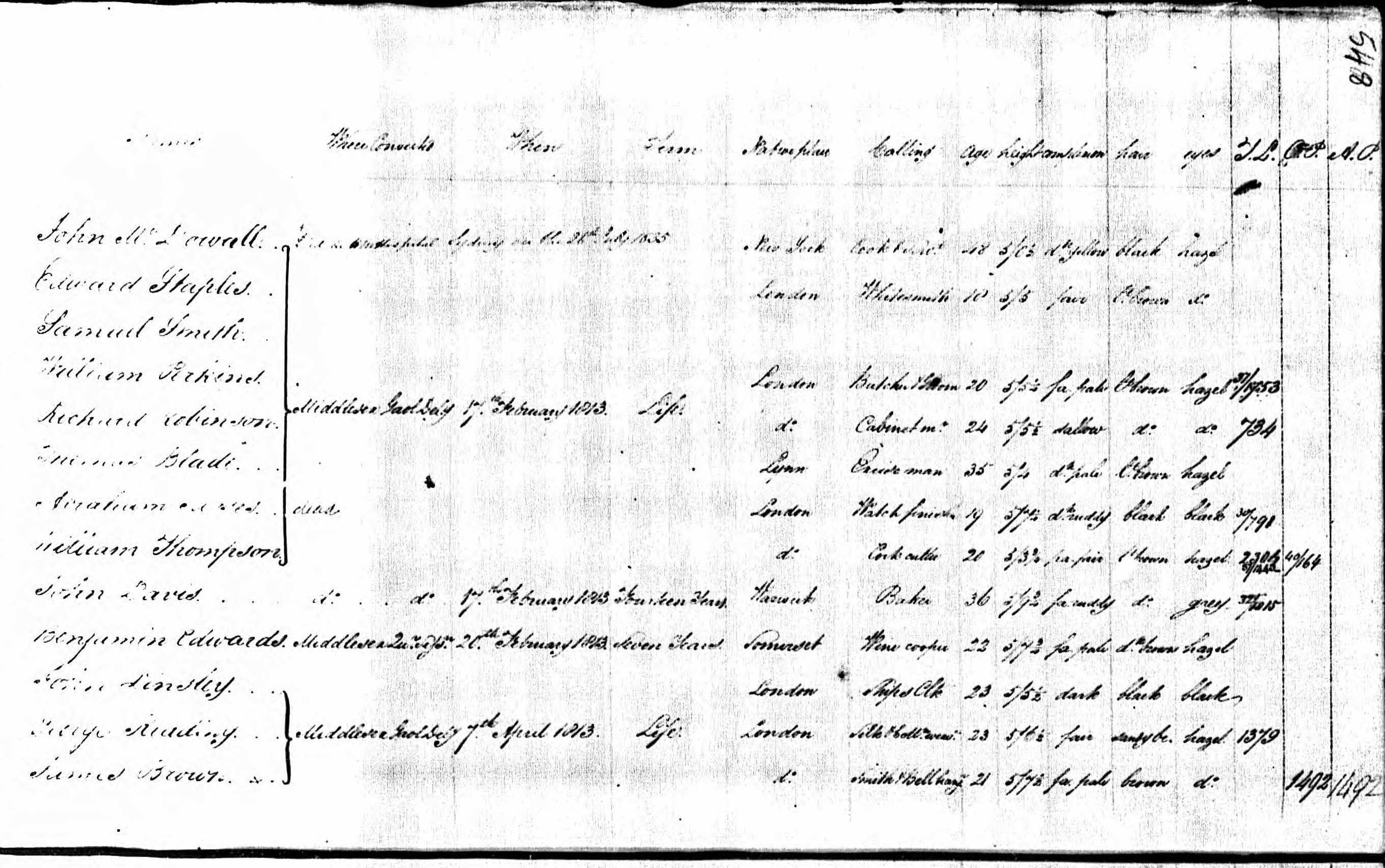
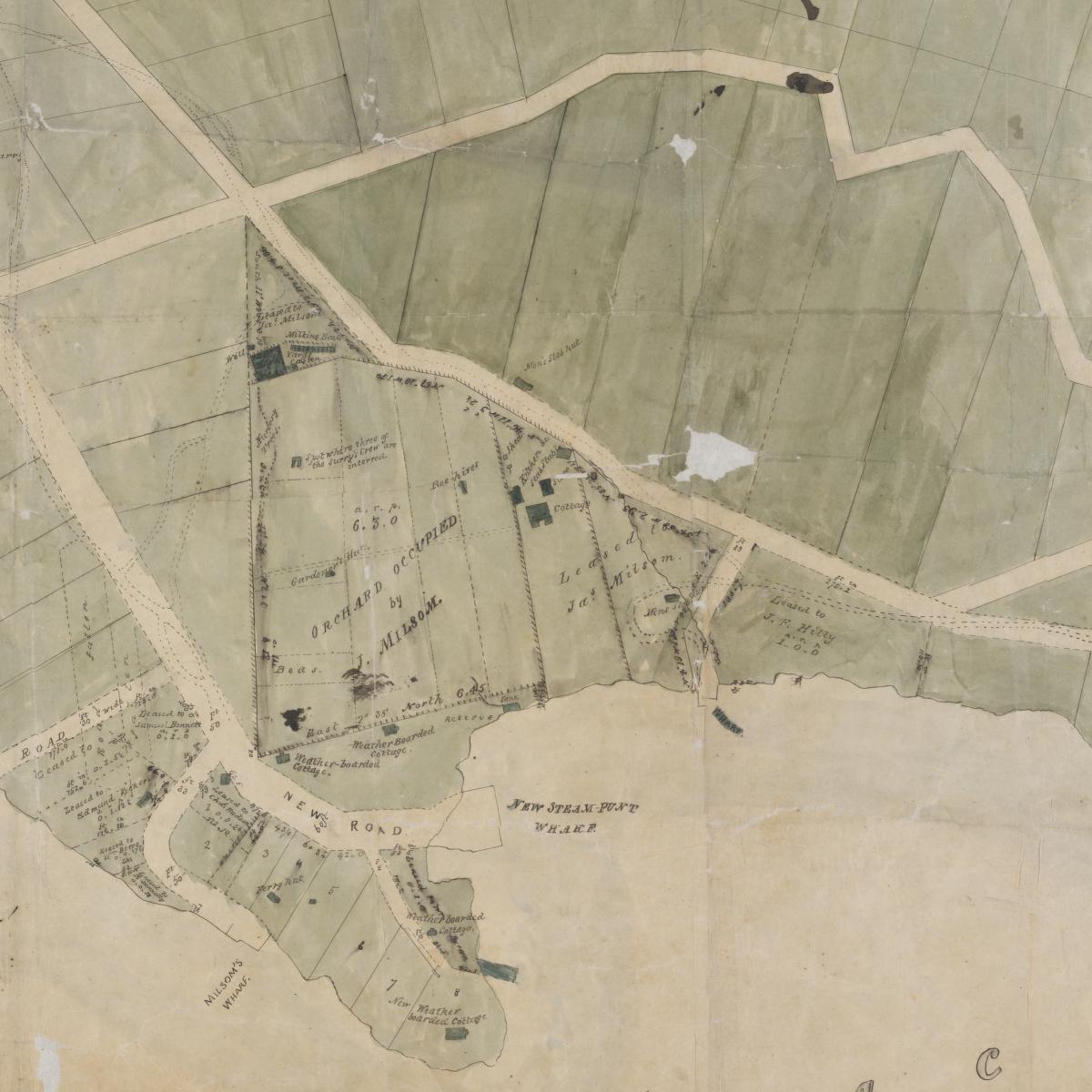
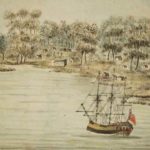
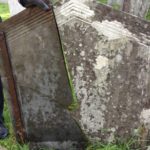
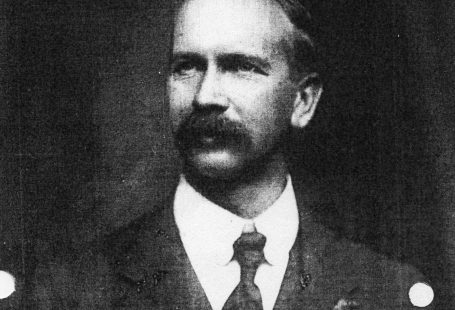
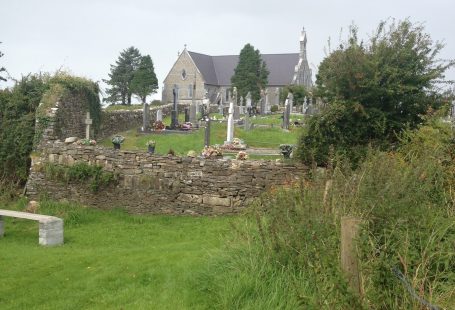
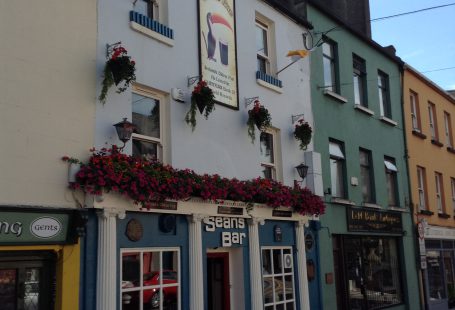
7 comments On The Stewart, Smith and Blade Families of Sydney, New South Wales
Hello, Virginia, I saw your information on Adam Moar by chance when I was looking up my Abernethy ancestors. I am descended from
James Abernethy and Georgina Goodlad (married 11 Feb. 1834). We know basically what has happened to James and Georgina’s
descendants and James and Eliza Dalziel’s descendants but didn’t know about Eliza and Adam Moar’s descendants. James’s families
are mostly in Vancouver and Seattle.
Thank you so much for all the information that you have put on the internet – absolutely fascinating!! I have written my e-mail
address below if you are interested in getting in touch. Thank you again!! Kathie Lefeaux
Hi Virginia,
Thank you for alerting me to this site. It was very interesting to read about your family history. I’m a direct descendant of Thomas & Sarah Blades through their daughter Sarah who married John Ireland. I haven’t done much research on Sarah after she married George Smith just basic information, but they do sound interesting!
You’ve inspired me to go back and have a closer look at Sarah.
Thank you again.
Kerrie.
Hi Virginia, I am Potsy’s sister, Linda and was surprised when I googled Thomas Stewart and your story appeared. I have almost finished my book on the Stewarts and Bathis/Bathurst history. I only googled his name because I was looking for more info on the bus company. Some of what Potsy gave you was Merle Perham’s research. She was married to our cousin, David Perham. I did not know Potsy saw our great grandparents grave and am asking you if I can use the photo in my book. I will acknowledge you. Francis and Anne Bathis were our great grandparents. I also did not know George Smith remarried and am asking if I can copy their marriage certificate. I have most of the info you have. If you would like a USB of my story which is now about 180 pages and includes Dad’s mother’s side and current family info I will post it to you. It won’t be for a few weeks as I am goung to Norfolk Island for a holiday. I have almost all of the newspaper clippings you have except George Smith’ remarriage and second wife’s death. Please give me your address if you want a copy. PS Your story was excellent. I am not going to add the Blade family just focussing on my line. Regards Linda, Lil.
Hello!! Just spent hours reading this wonderful research. My name is Karen Decelis I am a descendant of Lydia and John Stewart … Martha I think. My roots are in Balmain James Tutton marriied Martha Stewart James Tutton Jnr married Elizabeth Grahame who were the parents of my Nanna Frances Ellen Tutton who married Thomas Albert Jarvis my Mum June Doreen Jarvis who married Anthony Lewis Decelis . I have not finished reading your research what a astonishing finding of the History of our genes. Noleen Nee Kelly a second cousin on the Stewart side also has done a lot of research My Mothers cousin Allan Tutton also. thank You for such a great read ???
Hello Virginia,
I am not leaving a reply but simply letting you know that I have a photograph of John Humphrey MORRIS (1821 – 1921), timber merchant whose 2nd wife was Martha Suzanne STEWART (m. 1883) if you would like a scan of the image.
Congratulations om all your family research.
Hi there Joy, it’s Christine finlay here the granddaughter of Emily Elizabeth Finlay, nee Morris. would love to catch up with you. my phone number is 0416677492., regards Christine
Dear Virginia and Geoff,
I was researching a Robert Petty Stewart, roots in Tasmania and Western districts Victoria.
Your wonderful essay popped up.
Nicely written, very well researched.
With good thoughts,
Simon Storey